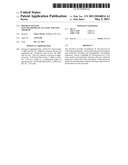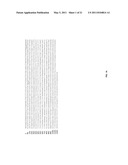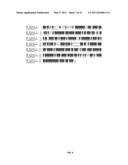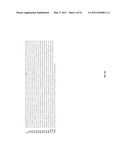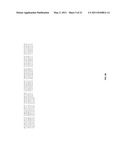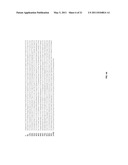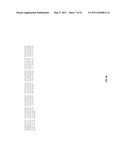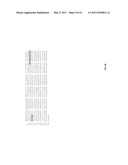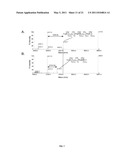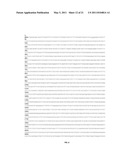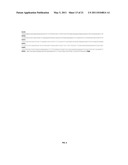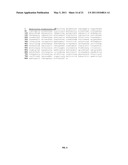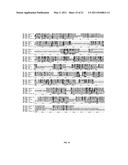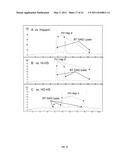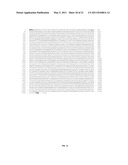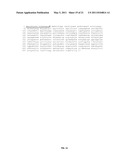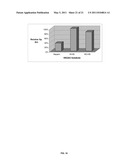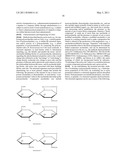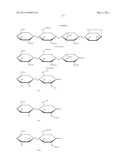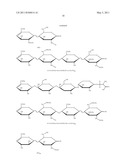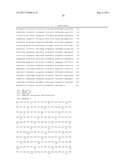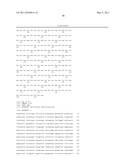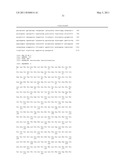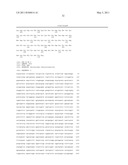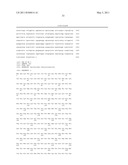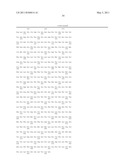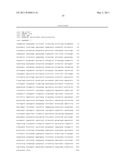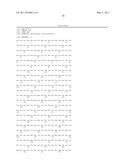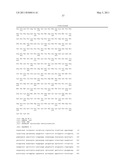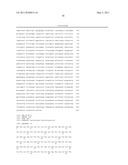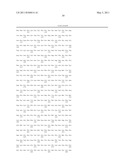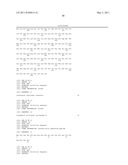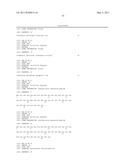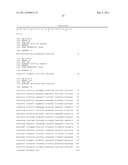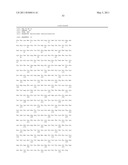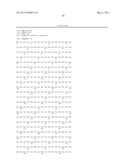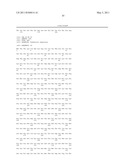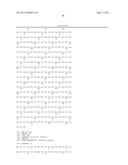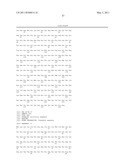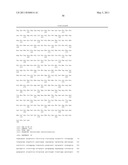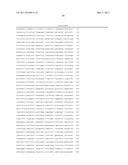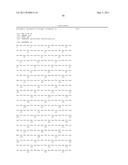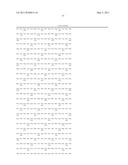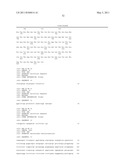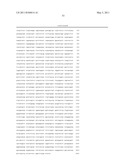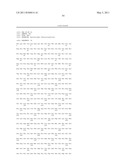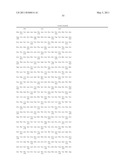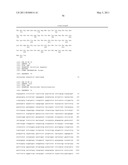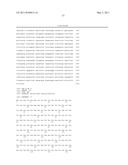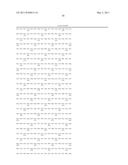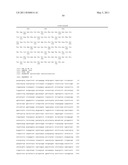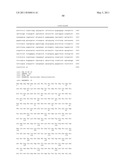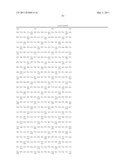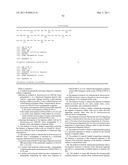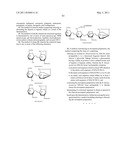Patent application title: HEPARAN SULFATE GLYCOSAMINOGLYCAN LYASE AND USES THEREOF
Inventors:
James Myette (Waltham, MA, US)
IPC8 Class: AG01N3300FI
USPC Class:
436 94
Class name: Heterocyclic carbon compound (i.e., o, s, n, se, te, as only ring hetero atom) hetero-o (e.g., ascorbic acid, etc.) saccharide (e.g., dna, etc.)
Publication date: 2011-05-05
Patent application number: 20110104814
Claims:
1. A method of specifically cleaving a heparin or a heparan sulfate,
comprising: selecting an isolated B. thetaiotaomicron HSGAG lyase
polypeptide I, or a functional fragment thereof, that cleaves a
glycosidic linkage between a glucosamine having a sulfate at position 3
and a sulfated uronic acid of the heparin or heparan sulfate, wherein the
B. thetaiotaomicron HSGAG lyase I polypeptide comprises a) an amino acid
sequence which is at least 90% identical to the amino acid sequence of
SEQ ID NO:2; b) the amino acid sequence of SEQ ID NO:2, 4 or 23; and c)
an amino acid sequence which differs by at least 1 amino acid but not
more than 15 amino acids from the amino acid sequence of SEQ ID NO:2, and
contacting the heparin or the heparan sulfate with the B.
thetaiotaomicron HSGAG lyase polypeptide I, to thereby cleave the heparin
or heparan sulfate.
2. The method of claim 1, further comprising contacting the heparin or heparan sulfate with an isolated B. thetaiotaomicron HSGAG lyase II polypeptide, or functional fragment thereof.
3. The method of claim 1, wherein the B. thetaiotaomicron HSGAG lyase I polypeptide is encoded by a nucleotide sequence selected from the group consisting of: a) a nucleic acid molecule comprising a fragment of at least 800 nucleotides of the nucleotide sequence of SEQ ID NO: 1, 3 or 22; b) a nucleic acid molecule which encodes a polypeptide comprising the amino acid sequence of SEQ ID NO:2, 4 or 23; and c) a nucleic acid molecule which encodes a fragment of a polypeptide comprising the amino acid sequence of SEQ ID NO:2, 4 or 23, wherein the fragment comprises at least 300 contiguous amino acids of SEQ ID NO:2, 4 or 23.
4. The method of claim 1 or 3, wherein the B. thetaiotaomicron HSGAG lyase I cleaves a heparin at one or more glycosidic linkages of 2-O sulfated uronic acids.
5. The method of claim 1, wherein the heparin or heparan sulfate is cleaved into di-, tri-, tetra-, penta-, hexa-, octa-, deca-saccharides, and combinations thereof.
6. The method of claim 1, further comprising contacting the heparin or heparan sulfate with one or more HLGAG degrading enzyme other than the B. thetaiotaomicron HSGAG lyase I polypeptide.
7. The method of claim 6, wherein the HLGAG degrading enzyme is selected from Flavobacterium heparinum heparinase I, Flavobacterium heparinum heparinase II, Flavobacterium heparinum heparinase III, Flavobacterium heparinum heparinase IV, heparanase, sulfatase, delta 4,5 glucuronidase and functional fragments thereof.
8. The method of claim 1, further comprising determining if a structural signature is absent or present in the cleaved heparin or heparin sulfate.
9. The method of claim 8, further comprising comparing the absence or presence of the structural signature or the amount of the structural signature of the heparin or heparin sulfate to a preselected value.
10. The method of claim 9, wherein the preselected value is the absence, presence or amount of the structural signature present in a commercially available heparin or heparin sulfate.
11. The method of claim 10, wherein the commercially available heparin is selected from: unfractionated heparin, enoxaparin, dalteparin, certoparin, ardeparin, nadroparin, parnaparin, reviparin, tinzaparin, and Fondaparinux.
12. The method of claim 9, further comprising selecting or discarding the heparin or heparin sulfate as a result of the determination.
13. The method of claim 8, wherein the structural signature is determined by one or more of mass spectroscopy, NMR spectroscopy, gel electrophoresis, capillary electrophoresis, reverse-phase column chromatography, and ion-pair HPLC.
14. The method of claim 10, wherein the structural signature is one or more of the following structures: ##STR00004##
15. A method of producing an enoxaparin preparation, the method comprising the steps of: comprising: selecting an isolated B. thetaiotaomicron HSGAG lyase polypeptide I, or a functional fragment thereof, that cleaves a glycosidic linkage between a glucosamine having a sulfate at position 3 and a sulfated uronic acid of heparin or heparan sulfate, wherein the B. thetaiotaomicron HSGAG lyase I polypeptide comprises a) an amino acid sequence which is at least 90% identical to the amino acid sequence of SEQ ID NO:2; b) the amino acid sequence of SEQ ID NO:2, 4 or 23; and c) an amino acid sequence which differs by at least 1 amino acid but not more than 15 amino acids from the amino acid sequence of SEQ ID NO:2, and contacting the enoxaparin preparation with the B. thetaiotaomicron HSGAG lyase polypeptide I, to thereby cleave the enoxaparin preparation; determining if a structural signature is absent or present in the cleaved enoxaparin preparation; and based upon the determination, further processing the enoxaparin batch by a method including selecting or discarding the enoxaparin preparation.
Description:
CROSS-REFERENCE TO RELATED APPLICATIONS
[0001] This application is a divisional of U.S. application Ser. No. 12/436,751 filed May 6, 2009, which is a divisional of U.S. application Ser. No. 11/948,561 filed Nov. 30, 2007, which is a divisional of U.S. application Ser. No. 11/592,622 filed Nov. 3, 2006, which is a continuation-in-part application of and claims priority to U.S. application Ser. No. 11/265,908, filed on Nov. 3, 2005.
BACKGROUND OF THE INVENTION
[0002] Heparin and heparan sulfate represent a class of glycosaminoglycans characterized by a linear polysaccharide of D-glucosamine linked to hexuronic acid (Linhardt, R. J. (1991) Chem. Ind. 2, 45-50; Casu, B. (1985) Adv. Carbohydr. Chem. Biochem. 43, 51-134). Heparin and heparan sulfate are complex carbohydrates that play an important functional role in the extracellular matrix of mammals. These polysaccharides modulate and regulate critical biochemical signaling pathways which impinge on normal physiological processes such as cell and tissue morphogenesis, cell-cell interactions, and growth and differentiation. These polysaccharides also play a critical role in various pathologies including wound healing, tumor growth and metastasis, certain neurodegenerative disorders and microbial pathogenesis, to name a few.
[0003] Much of the current understanding of heparin and heparan sulfate sequence has relied on studies of their biosynthesis (Linhardt, R. J., Wang, H. M., Loganathan, D., and Bae, J. H. (1992) Biol. Chem. 267, 2380-2387; Lindahl, U., Feingold, D., and Roden, L. (1986) Trends Biochem. Sci. 11, 221-225; Jacobson, I., and Lindahl U. (1980) J. Biol. Chem. 255, 5094-5100; Lindahl, U., and Kjellen, L. (1987) in The Biology of Extracellular Matrix Proteoglycans (Wight, T. N., and Mecham R., eds) pp. 59-104, Academic Press, New York).
[0004] Heparan sulfate, which is chemically related to heparin, is present on the cell surface and within the extracellular matrix (ECM) of virtually every mammalian cell type. These heparin-like glycosaminoglycans (HLGAGs) are present in this extracellular environment as protein-polysaccharide conjugates known as proteoglycans. It is increasingly recognized that HLGAGs play much more than a mere structural role as they interact in a functional manner with numerous proteins of the extracellular matrix, such as laminin, fibronectin, integrins, and collagen. As such, HLGAGs (as part of proteolycans) help to define the biological properties of the matrix. These HLGAGs also interact with an array of cytokine-like growth factors and morphogens present within the extracellular matrix by facilitating their biochemical interaction with receptors and by protecting them from proteolytic degradation. For example, heparin potentates the biological activity of aFGF, as reported by Thornton, et al., Science 222, 623-625 (1983), possibly by potentiating the affinity of aFGF for its cell surface receptors, as reported by Schreiber, et al., Proc. Natl. Acad. Sci. USA 82, 6138-6142 (1985). Heparin protects aFGF and bFGF from degradation by heat, acid and proteases, as reported by Gospodarowicz and Cheng, J. Cell Physiol. 128, 475-4 84 (1986); Rosengart, et al., Biochem. Biophys. Res. Commun 152, 432-440 (1988); and Lobb Biochem. 27, 2572-2578 (1988). bFGF is stored in the extracellular matrix and can be mobilized in a biologically active form by the hydrolyzing activity of enzymes such as heparanase as reported by Vlodavsky, et al., Proc. Natl. Acad. Sci. USA 84, 2292-2296 (1987) and Folkman, et al., Am. J. Pathol. 130, 393-400 (1988) and Emerson et. al. Proc. Natl. Acad. Sci. USA 101(14): 4833-8 (2004).
[0005] The binding of FGF to heparan sulfate is a prerequisite for the binding of FGF to its high affinity receptor on the cell surface, as reported by Yayon, et al., Cell 64, 841-848 (1991) and Papraeger, et al., Science 252, 1705-1708 (1991). A specific heparan sulfate proteoglycan has been found to mediate the binding of bFGF to the cell surface, as described by Kiefer, et al., Proc. Natl. Acad. Sci. USA 87, 6985-6989 (1990).
[0006] Heparin lyases, such as heparinases, are a general class of enzymes that are capable of specifically cleaving the major glycosidic linkages in heparin and heparan sulfate. Three heparinases have been identified in Flavobacterium heparinum, a GAG-utilizing organism that also produces exoglycuronidases, glycosidases, sulfoesterases, and sulfamidases and other enzymes which further act on the lyase-generated oligosaccharide products (Yang, et al. J. Biol. Chem. 260, 1849-1857 (1987); Galliher, et al. Eur. J. Appl. Microbiol. Biotechnol. 15, 252-257 (1982). These lyases are designated as heparinase I (heparinase, EC 4.2.2.7), heparinase II (heparinase II, no EC number) and heparinase III (heparinase EC 4.2.2.8). The three purified heparinases differ in their capacity to cleave heparin and heparan sulfate: heparinase I primarily cleaves heparin, heparinase III specifically cleaves heparan sulfate, and heparinase II acts on both heparin and heparan sulfate. Several Bacteroides species (Saylers, et al. Appl. Environ. Microbiol. 33, 319-322 (1977); Nakamura, et al. J. Clin. Microbiol. 26, 1070-1071 (1988)) also produce heparin lyases. A heparin lyase has also been purified to apparent homogeneity from an unidentified soil bacterium by Bohmer, et al. J. Biol. Chem. 265, 13609-13617 (1990).
SUMMARY OF THE INVENTION
[0007] The invention is based, in part, on the discovery and recombinant expression of glucosaminoglycan (GAG) lyases from Bacteroides thetaiotaomicron, hereafter referred to as "B. thetaiotaomicron GAG lyases", e.g., B. thetaiotaomicron GAG lyase I, B. thetaiotaomicron GAG lyase II B. thetaiotaomicron GAG lyase III, and B. thetaiotaomicron GAG lyase IV, useful, inter alia, in the structure-specific cleavage of heparin and/or heparan sulfate, and, in some cases, chondroitin sulfate and dermatan sulfate. Thus, the invention includes methods, compositions and kits with a B. thetaiotaomicron GAG lyase or functional fragments thereof and combinations of B. thetaiotaomicron GAG lyases or functional fragments thereof, for, e.g., characterization or modification of glycosaminoglycans (GAGs) such as heparin-like glycoaminoglycans (HLGAGs), e.g., heparin and heparan sulfate or, e.g., characterization or modification of non-heparin/heparan sulfate GAGs, e.g., chondroitin sulfate and dermatan sulfate. For example, the methods, compositions and kits can be used to analyze and monitor heterogeneous populations of GAGs, e.g., HLGAGs. In other aspects, the methods, compositions and kits can be used to modify the structure and/or activity of GAGs, e.g., HLGAGs.
[0008] Accordingly, in one aspect, the invention features B. thetaiotaomicron GAG lyase polypeptides, or functional fragments thereof, e.g., B. thetaiotaomicron GAG lyase polypeptides, or functional fragments thereof, having the amino acid sequence shown in SEQ ID NOs:2, 4, 6, 8, 10, 23, 29, 34, 37 or 39; an amino acid substantially identical to the amino acid sequence shown in SEQ ID NOs:2, 4, 6, 8, 10, 23, 29, 34, 37 or 39; or an amino acid encoded by a nucleic acid molecule that hybridizes under stringent hybridization conditions to a nucleic acid molecule comprising the nucleic acid sequence of SEQ ID NOs:1, 3, 5, 7, 9, 22, 28, 33, 36 or 38, wherein the nucleic acid encodes a full length B. thetaiotaomicron GAG lyase protein, or functional fragments thereof.
[0009] In another aspect, the invention features a composition that includes a B. thetaiotaomicron GAG lyase polypeptide, B. thetaiotaomicron GAG lyase polypeptides, or functional fragments thereof, e.g., B. thetaiotaomicron GAG lyase polypeptides, B. thetaiotaomicron GAG lyase polypeptides, or functional fragments thereof, described herein. In one embodiment, the composition further comprises one or more HLGAG degrading enzyme, e.g., one or more heparinase and/or one or more GAG lyase polypeptide other than a B. thetaiotaomicron GAG lyase polypeptides. For example, the composition can further include one or more of: an unsaturated glucuronyl hydrolase (e.g., F. heparinum Δ4,5 glycuronidase; B. thetaiotaomicron Δ4,5 glycuronidase); a glucuronyl hydrolase (e.g., mammalian α-iduronidase, β-glucuronidase); a sulfohydrolase (e.g., F. heparinum 2-O-sulfatase, 6-O-sulfatase, 3-O-sulfatase: B. thetaiotaomicron 6-O-sulfatase; mucin desulfating enzymes; mammalian N-acetylglucosamine-6-sulfatase; mammalian iduronic acid-2-sulfatase); an N-sulfamidase (e.g., F. heparinum N-sulfamidase; mammalian heparan-N-sulfatase); an arylsulfatase; a hexosaminidase; a glycosyl hydrolase (e.g., endo-N-acetyl glucosaminidase); a heparinase (e.g., Flavobacterum heparinum heparinase I, Flavobacterum heparinum heparinase II, Flavobacterum heparinum heparinase III, Flavobacterum heparinum heparinase IV aka heparinases from Cytophaga heparina or Pedobacter heparinum), mammalian heparanase, bacteriophage K5 heparan lyase, and functional fragments and variants thereof. Such compositions can be used, e.g., to cleave a HLGAG such as heparin and/or heparan sulfate, e.g., to characterize a preparation of HLGAGs such as heparin and/or heparan sulfate.
[0010] In another aspect, the invention features a method of specifically cleaving an HLGAG, e.g., heparin or heparan sulfate, that includes contacting an HLGAG with a B. thetaiotaomicron GAG lyase polypeptide, B. thetaiotaomicron GAG lyase polypeptides, or functional fragments thereof, e.g., a B. thetaiotaomicron GAG lyase polypeptide, B. thetaiotaomicron GAG lyase polypeptides, or functional fragments thereof, described herein. In one embodiment, the HLGAG is cleaved into di-, tri-, tetra-, penta-, hexa-, octa-, and/or deca-saccharides and, e.g., the method further includes determining the sequence of the di-, tri-, tetra-, penta-, hexa-, octa-, deca- and/or longer saccharides of the HLGAG. In one embodiment, the method further includes contacting the HLGAG with one or more HLGAG degrading enzyme, e.g., a heparinase polypeptide or a GAG lyase polypeptide other than a B. thetaiotaomicron GAG lyase polypeptide. For example, the HLGAG degrading enzyme can be one or more of: an unsaturated glucuronyl hydrolase (e.g., F. heparinum Δ4,5 glycuronidase; B. thetaiotaomicron Δ4,5 glycuronidase); a glucuronyl hydrolase (e.g., mammalian α-iduronidase, β-glucuronidase); a sulfohydrolase (e.g., F. heparinum 2-O-sulfatase, 6-O-sulfatase, 3-O-sulfatase: B. thetaiotaomicron 6-O-sulfatase; mucin desulfating enzymes; mammalian N-acetylglucosamine-6-sulfatase; mammalian iduronic acid-2-sulfatase); a N-sulfamidase (e.g., F. heparinum N-sulfamidase; mammalian heparan-N-sulfatase); an arylsulfatase; a hexosaminidase; a glycosyl hydrolase (e.g., endo-N-acetyl glucosaminidase); a heparinase (e.g., Flavobacterum heparinum heparinase I, Flavobacterum heparinum heparinase II, Flavobacterum heparinum heparinase III, Flavobacterum heparinum heparinase IV aka heparinases from Cytophaga heparina or Pedobacter heparinum), mammalian heparanase, bacteriophage K5 heparan lyase, and functional fragments and variants thereof.
[0011] In another aspect, the invention features methods for analyzing heterogeneous populations of HLGAGs, e.g., heparin (e.g., UFH, LMWH, and synthetic heparins), and heparan sulfate, that include contacting the population with a B. thetaiotaomicron GAG lyase polypeptide, B. thetaiotaomicron GAG lyase polypeptides, or functional fragments thereof, e.g., a B. thetaiotaomicron GAG lyase polypeptide, B. thetaiotaomicron GAG lyase polypeptides, or functional fragments thereof, described herein. Thus, in some aspects, the invention relates to methods and products associated with analyzing and monitoring heterogeneous populations of HLGAGs, e.g., to thus defining the structural signature and activity of heterogeneous populations of HLGAGs, using a B. thetaiotaomicron GAG lyase polypeptide, B. thetaiotaomicron GAG lyase polypeptides, or functional fragments thereof, e.g., a B. thetaiotaomicron GAG lyase polypeptide, or functional fragment thereof, described herein.
[0012] In some embodiments, the method includes determining the structural signature of one or more batches of an HLGAG product that has been contacted with a B. thetaiotaomicron GAG lyase polypeptide, B. thetaiotaomicron GAG lyase polypeptides or functional fragments thereof, e.g., a B. thetaiotaomicron GAG lyase polypeptide, B. thetaiotaomicron GAG lyase polypeptides, or functional fragments thereof, described herein. In some embodiments, the method further includes selecting a batch as a result of the determination. In some embodiments, the method further includes comparing the results of the determination to preselected values, e.g., a reference standard. The preselected value can be, e.g., the presence or absence or a set value (e.g., mole % or area under the curve) of one or more di-, tri-, tetra-, penta-, hexa-, octa-, and/or deca-saccharide associated with cleavage of the HLGAG with a B. thetaiotaomicron GAG lyase polypeptide, B. thetaiotaomicron GAG lyase polypeptides, or functional fragments thereof, e.g., a B. thetaiotaomicron GAG lyase polypeptide, B. thetaiotaomicron GAG lyase polypeptides, or functional fragment thereof, described herein.
[0013] For any of the methods described herein, a completely or partially B. thetaiotaomicron GAG lyase polypeptide (or polypeptides) digested sample can be analyzed to determine the structural signature by, e.g., one or more of mass spectroscopy (e.g., matrix assisted laser desorption/ionization mass spectroscopy (MALDI-MS)), nuclear magnetic resonance (NMR) spectroscopy (e.g., 1D NMR or 2D NMR), gel electrophoresis, capillary electrophoresis (CE), reverse-phase column chromatography (e.g., HPLC, e.g., HPLC with a stationary phase dynamically coated with a quanternary ammonium salt), ion-pair HPLC, e.g., strong anion exchange HPLC (SAX-HPLC). The methods described herein can further include digesting the sample with one or more HLGAG degrading enzyme, e.g., a heparinase or a heparin lyase polypeptide other than a B. thetaiotaomicron GAG lyase polypeptide. For example, the HLGAG degrading enzyme can be one or more of: an unsaturated glucuronyl hydrolase (e.g., F. heparinum Δ4,5 glycuronidase; B. thetaiotaomicron Δ4,5 glycuronidase); a glucuronyl hydrolase (e.g., mammalian α-iduronidase, β-glucuronidase); a sulfohydrolase (e.g., F. heparinum 2-O-sulfatase, 6-O-sulfatase, 3-O-sulfatase: B. thetaiotaomicron 6-O-sulfatase; mucin desulfating enzymes; mammalian N-acetylglucosamine-6-sulfatase; mammalian iduronic acid-2-sulfatase); a N-sulfamidase (e.g., F. heparinum N-sulfamidase; mammalian heparan-N-sulfatase); an arylsulfatase; a hexosaminidase; a glycosyl hydrolase (e.g., endo-N-acetyl glucosaminidase); a heparinase (e.g., Flavobacterum heparinum heparinase I, Flavobacterum heparinum heparinase II, Flavobacterum heparinum heparinase III, Flavobacterum heparinum heparinase IV aka heparinases from Cytophaga heparina or Pedobacter heparinum), mammalian heparanase, bacteriophage K5 heparan lyase, and functional fragments and variants thereof.
[0014] In another aspect, the invention features an HLGAG preparation (e.g., a heparin or heparan sulfate preparation) produced by contacting an HLGAG preparation with a B. thetaiotaomicron GAG lyase polypeptide, B. thetaiotaomicron GAG lyase polypeptides, or functional fragments thereof, e.g., a B. thetaiotaomicron GAG lyase polypeptide, B. thetaiotaomicron GAG lyase polypeptides, or functional fragments thereof, described herein. In one embodiment, the HLGAG preparation (e.g., the heparin or heparan sulfate preparation) has one or more of reduced anti-Xa activity and anti-IIa activity, e.g., as compared to a reference standard, e.g., as compared to a commercially available heparin or heparan sulfate or as compared to the heparin or heparan sulfate preparation prior to contacting with a B. thetaiotaomicron GAG lyase polypeptide. In some embodiments, anti-Xa activity is reduced while anti-IIa activity is maintained or increased. In other embodiments, anti-IIa activity is reduced while anti-Xa activity is maintained or enhanced. In other embodiments, anti-Xa activity and anti-IIa activity are reduced. Such preparation can be useful, e.g., for applications where reduced anti-Xa activity and/or anti-IIa activity is desirable, e.g., such as the use of heparin or heparan sulfate as a carrier for another agent, e.g., a therapeutic agent, prophylactic or diagnostic agent. Thus, in some embodiments, the HLGAG preparation can further include a second agent other than the HLGAG, e.g., the preparation can further include one or more therapeutic, prophylactic or diagnostic agents. In another embodiment, the HLGAG preparation (e.g., the heparin or heparan sulfate preparation) has one or more of increased anti-Xa activity and anti-IIa activity, e.g., as compared to a reference standard, e.g., as compared to a commercially available heparin or heparan sulfate or as compared to the heparin or heparan sulfate preparation prior to contacting with a B. thetaiotaomicron GAG lyase polypeptide. Such preparation can be useful, e.g., for applications were increased anti-Xa activity and/or anti-IIa activity is desirable, e.g., as an anti-coagulant and/or anti-thrombotic agent.
[0015] In another aspect, the invention features a method of neutralizing one or more activities of an HLGAG (e.g., a heparin or heparan sulfate). The method includes contacting the HLGAG with a B. thetaiotaomicron GAG lyase polypeptide, B. thetaiotaomicron GAG lyase polypeptides or functional fragments thereof, e.g., a B. thetaiotaomicron GAG lyase I polypeptide, B. thetaiotaomicron GAG lyase III polypeptide, a B. thetaiotaomicron GAG lyase IV polypeptide and/or functional fragment thereof, described herein. When the HLGAG is heparin or heparan sulfate, the activity to be neutralized can be one or more of anti-Xa activity and anti-IIa activity. In some embodiments, anti-Xa activity is reduced while anti-IIa activity is maintained or increased. In other embodiments, anti-IIa activity is reduced while anti-Xa activity is maintained or enhanced. In other embodiments, anti-Xa activity and anti-IIa activity are reduced. In other embodiments, anti Xa and anti-IIa activities are maintained. The HLGAG can be, e.g., contacted ex vivo or in vivo. Thus, in some embodiments, the method can include administering the B. thetaiotaomicron GAG lyase polypeptide, B. thetaiotaomicron GAG lyase polypeptides or functional fragments thereof, to a subject in an amount effective to neutralize anti-Xa activity and/or anti-IIa activity in the subject, e.g., a subject that has been administered an HLGAG such as heparin or heparan sulfate, e.g., a subject that has been administered heparin or heparan sulfate to inhibit coagulation and/or thrombosis.
[0016] In another aspect, the invention features a method of inhibiting angiogenesis in a subject. The method includes administering to the subject an effect amount of a B. thetaiotaomicron GAG lyase polypeptide, B. thetaiotaomicron GAG lyase polypeptides, or functional fragments thereof, e.g., a B. thetaiotaomicron GAG lyase I polypeptide, a B. thetaiotaomicron GAG lyase II polypeptide, a B. thetaiotaomicron GAG lyase III polypeptide, a B. thetaiotaomicron GAG lyase IV polypeptide, or functional fragments thereof, described herein, to thereby inhibit angiogenesis. In one embodiment, the subject has a disease or disorder associated with unwanted angiogenesis. Such disorders include, but are not limited to, arthritis (e.g., rheumatoid arthritis), various eye disorders (e.g., diabetic retinopathy, neovascular glaucoma, inflammatory disorders, ocular tumors (e.g., retinoblastoma), retrolental fibroplasias, uveitis as well as disorders associated with choroidal neovascularization and iris neovascularization) and cancer (e.g., tumor growth and metastases).
[0017] In another aspect, the invention features a method of inhibiting unwanted cellular proliferation and/or differentiation in a subject. The method includes administering to the subject an effect amount of a B. thetaiotaomicron GAG lyase polypeptide, B. thetaiotaomicron GAG lyase polypeptides or functional fragment thereof, e.g., a B. thetaiotaomicron GAG lyase polypeptide, B. thetaiotaomicron GAG lyase polypeptides, or functional fragments thereof, described herein, to thereby inhibit cellular proliferation and/or differentiation. In one embodiment, the subject has cancer.
[0018] In another aspect, the invention features a pharmaceutical composition that includes a B. thetaiotaomicron GAG lyase polypeptide, B. thetaiotaomicron GAG lyase polypeptides, or functional fragments thereof, e.g., a B. thetaiotaomicron GAG lyase polypeptide, B. thetaiotaomicron GAG lyase polypeptides, or functional fragments thereof, described herein, and a pharmaceutically acceptable carrier. In one embodiment, the B. thetaiotaomicron GAG lyase polypeptide, B. thetaiotaomicron GAG lyase polypeptides, or functional fragments thereof, is present in an amount effective to neutralize one or more activity of an HLGAG. Preferably, the HLGAG is heparin or heparan sulfate and the B. thetaiotaomicron GAG lyase polypeptide, or functional fragment thereof, is present in an amount effective to neutralize one or more of anti-Xa activity and anti-IIa activity. In some embodiments, anti-Xa activity is reduced while anti-IIa activity is maintained or increased. In other embodiments, anti-IIa activity is reduced while anti-Xa activity is maintained or enhanced. In other embodiments, anti-Xa activity and anti-IIa activity is reduced. In another embodiment, the B. thetaiotaomicron GAG lyase polypeptide, or functional fragment thereof, is present in an amount effective to inhibit angiogenesis.
[0019] In another aspect, the invention features a kit comprising a composition of B. thetaiotaomicron GAG lyase polypeptide, B. thetaiotaomicron GAG lyase polypeptides, or functional fragments thereof. In one embodiment, the kit further includes one or more HLGAG degrading enzyme, e.g., one or more heparinase polypeptide and/or one or more GAG lyase polypeptide other than B. thetaiotaomicron GAG lyase polypeptide. For example, the kit can further comprise one or more of: an unsaturated glucuronyl hydrolase (e.g., F. heparinum Δ4,5 glycuronidase; B. thetaiotaomicron Δ4,5 glycuronidase); a glucuronyl hydrolase (e.g., mammalian α-iduronidase, β-glucuronidase); a sulfohydrolase (e.g., F. heparinum 2-O-sulfatase, 6-O-sulfatase, 3-O-sulfatase: B. thetaiotaomicron 6-O-sulfatase; mucin desulfating enzymes; mammalian N-acetylglucosamine-6-sulfatase; mammalian iduronic acid-2-sulfatase); a N-sulfamidase (e.g., F. heparinum N-sulfamidase; mammalian heparan-N-sulfatase); an arylsulfatase; a hexosaminidase; a glycosyl hydrolase (e.g., endo-N-acetyl glucosaminidase); a heparinase (e.g., Flavobacterum heparinum heparinase I, Flavobacterum heparinum heparinase II, Flavobacterum heparinum heparinase III, Flavobacterum heparinum heparinase IV aka heparinases from Cytophaga heparina or Pedobacter heparinum), mammalian heparanase, bacteriophage K5 heparan lyase, and functional fragments and variants thereof. In one embodiment, the B. thetaiotaomicron GAG lyase polypeptide, or functional fragment thereof, and one or more of the other HLGAG degrading enzymes are in the same composition. In another embodiment, the B. thetaiotaomicron GAG lyase polypeptide, or functional fragment thereof, and the other HLGAG degrading enzyme are in different compositions. In another embodiment, the B. thetaiotaomicron GAG lyase polypeptide, or functional fragment thereof, is in a pharmaceutical composition with a pharmaceutically effective carrier. The kits can further include an HLGAG, e.g., heparin and/or heparan sulfate. In one embodiment, when the kit includes a pharmaceutical composition of a B. thetaiotaomicron GAG lyase polypeptide, or functional fragment thereof, the HLGAG, e.g., heparin and/or heparan sulfate, is also in a pharmaceutical composition and, e.g., the kit further includes instructional material for neutralizing one or more activity of the HLGAG.
[0020] In another aspect, the invention features a nucleic acid molecule which encodes a B. thetaiotaomicron GAG lyase polypeptides, or functional fragments thereof. In one embodiment, the isolated nucleic acid molecule encodes a polypeptide having the amino acid sequence of SEQ ID NOs:2, 4, 6, 8, 10, 23, 29, 34, 37 or 39. In other embodiments, the invention provides isolated B. thetaiotaomicron GAG lyase nucleic acid molecules having the nucleotide sequence shown in SEQ ID NOs:1, 3, 5, 7, 9, 22, 28, 33, 36 or 38. In another embodiment, the invention provides nucleic acid molecules that are substantially identical to (e.g., naturally occurring allelic variants) to the nucleotide sequence shown in SEQ ID NOs:1, 5, 28, or 36 and nucleic acid molecules that hybridize under stringent hybridization conditions to a nucleic acid molecule comprising the nucleotide sequence of SEQ ID NOs:1, 3, 5, 7, 9, 22, 28, 33, 36 or 38, wherein the nucleic acid encodes a full length B. thetaiotaomicron GAG lyase protein, or functional fragments thereof.
[0021] In a related aspect, the invention further provides nucleic acid constructs which include a B. thetaiotaomicron GAG lyase nucleic acid molecule described herein. In certain embodiments, the nucleic acid molecules of the invention are operatively linked to native or heterogenous regulatory sequences. Also included are vectors and host cells containing the B. thetaiotaomicron GAG lyase nucleic acid molecules of the invention, e.g., vectors and host cells suitable for producing B. thetaiotaomicron GAG lyase nucleic acid molecules and polypeptides.
[0022] In another aspect, the invention features antibodies and antigen-binding fragments thereof, that react with, or more preferably, specifically bind B. thetaiotaomicron GAG lyase polypeptides.
[0023] In another aspect, the invention provides methods of screening for compounds that modulate the expression or activity of the B. thetaiotaomicron GAG lyase polypeptides or nucleic acids.
[0024] Other features and advantages of the invention will be apparent from the following detailed description, and from the claims.
BRIEF DESCRIPTION OF THE DRAWINGS
[0025] FIG. 1A depicts a DNA sequence (SEQ ID NO:1) encoding B. thetaiotaomicron GAG lyase I. Initiating methinione codon (ATG) is underlined and a second, internal methinione codon is doubled unlined FIG. 1B depicts its predicted amino acid sequence (SEQ ID NO:2) as well as indicating in bold the N-terminal amino acid residues of two variants of B. thetaiotaomicron GAG lyase I referred to as the M17 variant (SEQ ID NO:4) and the Q26 variant (SEQ ID NO:23).
[0026] FIG. 2 depicts a BLAST alignment of B. thetaiotaomicron GAG lyase I (SEQ ID NO:2) with a heparinase I from Flavobacterium heparinum (SEQ ID NO:24) and a consensus sequence (SEQ ID NO:26).
[0027] FIG. 3A depicts a DNA sequence (SEQ ID NO:3) encoding the M17 variant of B. thetaiotaomicron GAG lyase I with the ATG codon for methionine 17 (M17) shaded. FIG. 3B depicts its predicted amino acid sequence (SEQ ID NO:4).
[0028] FIG. 4A depicts a DNA sequence (SEQ ID NO:22) encoding the Q26 variant of B. thetaiotaomicron GAG lyase I. FIG. 4B depicts its predicted amino acid sequence (SEQ ID NO:23).
[0029] FIG. 5A depicts a DNA sequence (SEQ ID NO:5) encoding B. thetaiotaomicron GAG lyase II. FIG. 5A also depicts portions of the nucleotide sequence encoding B. thetaiotaomicron GAG lyase II that are not present in two variants of B. thetaiotaomicron GAG lyase II, namely the "Q23 variant" (SEQ ID NO:7) the deleted portion indicated by underlining, and the "K169 variant" (SEQ ID NO:9) the deleted portion indicated by shading. FIG. 5B depicts the predicted amino acid sequence B. thetaiotaomicron GAG lyase II (SEQ ID NO:6) as well as indicating the portions deleted from the amino acid sequence of the Q23 variant (SEQ ID NO:8) and the K169 variant (SEQ ID NO:10).
[0030] FIG. 6 depicts a BLAST alignment of B. thetaiotaomicron GAG lyase II (SEQ ID NO:6) with a heparinase III from Flavobacterium heparinum (SEQ ID NO:25) and a consensus sequence (SEQ ID NO:27).
[0031] FIG. 7 is a representation of a MALDI-MS mass spectrum. Panel A depicts the peaks of untreated ATIII pentasaccharide ARIXTRA®, the structure of which is also shown. Panel B depicts the peaks produced after ARIXTRA® was digested with recombinant B. thetaiotaomicron GAG lyase I. A pentasulfated trisaccharide product, the structure of which is shown, results after digestion.
[0032] FIG. 8 depicts a DNA sequence (SEQ ID NO:28) for coding sequence of GAG lyase III gene cloned from Bacteroides thetaiotaomicron. Initiating methionine (ATG) and stop (TAA) codons are noted in bold. Codon (CAG) corresponding to glutamine 23 (Q23) is underlined.
[0033] FIG. 9 depicts an amino acid sequence (SEQ ID NO:29) of GAG lyase III cloned from Bacteroides thetaiotaomicron. Predicted export signal sequence is underlined. Glutamine 23 (Q23) delimiting beginning of amino-terminal variant is shaded in gray.
[0034] FIG. 10 depicts alignment of amino acid sequence of Bacteroides thetaiotaomicron GAG lyase III (SEQ ID NO:29)--listed third from the top--with related heparin/heparan sulfate glycosaminoglycan lyases. Identical residues are shown in dark gray; similar residues are shown in light gray. BT represents Bacteroides thetaiotaomicron; FH represents Flavobacterium heparinum.
[0035] FIG. 11 depicts enzyme activities of GAG lyase III isolated from Bacteroides thetaiotaomicron (BT GAG Lyase), heparinase II isolated from Flavobacterium heparinum (FH Heparinase II) and heparinase III isolated from Flavobacterium heparinum (FH Heparinase III). The enzyme activity represents substrate specificity of the three tested enzymes. The four "heparin-like" substrates tested were: porcine intestinal heparin, two different heparan sulfates (designated "HI" and "HO," each one varying in the degree of sulfation), and low molecular weight pharmaceutical heparin, enoxaparin. Enzyme activity shown depicts total cleavage activity toward these substrates in an exhaustive digestion, as assessed by absorbance at 232 nm.
[0036] FIG. 12 depicts cleavage activities of GAG lyase III isolated from Bacteroides thetaiotaomicron (BT GAG Lyase) and heparinase II isolated from Flavobacterium heparinum (FH Hep II). The cleavage activity represents substrate specificity of the tested enzymes. The actual cleavage products are fractionated by capillary electrophoresis and monitored by absorbance at 232 nm (Y axis). Solid line depicts BT GAG Lyase and dotted line depicts FH Hep II.
[0037] FIG. 13 depicts a DNA sequence (SEQ ID NO:36) encoding B. thetaiotaomicron GAG lyase IV. Initiating methinione codon (ATG) and stop codon are in bold and a second, codon (GAC) corresponding to aspartate 20 is unlined.
[0038] FIG. 14 depicts its predicted amino acid sequence (SEQ ID NO:37) with the signal sequence underlined. In addition, the N-terminal amino acid residues of the variant of B. thetaiotaomicron GAG lyase IV referred to as the D20 variant (SEQ ID NO:38) is shaded.
[0039] FIG. 15 depicts alignment of nucleic acid sequence of Bacteroides thetaiotaomicron GAG lyase IV (SEQ ID NO:36)--listed third from the top--with related heparin/heparan sulfate lyases. Identical residues are shown in dark gray; similar residues are shown in light gray. BT represents Bacteroides thetaiotaomicron; FH represents Flavobacterium heparinum.
[0040] FIG. 16 depicts the substrate specificity of Bacteroides thetaiotaomicron GAG lyase IV against three different substrates, namely unfractionated heparin (Heparin) and two fractions of heparin sulfate (HS) referred to as "HO-HS" and "HI-HS".
DETAILED DESCRIPTION
Overview
[0041] This disclosure describes recombinant expression of active B. thetaiotaomicron GAG lyases from B. thetaiotaomicron, that are useful, inter alia, in the modification and characterization of GAGs such as heparin and/or heparan sulfate glycosaminoglycans and derivatives thereof.
[0042] For example, the B. thetaiotaomicron GAG lyases described herein can be a complementary tool to existing chemo-enzymatic methods for cleaving GAGs such as heparin and heparan sulfate polysaccharides (and, in some cases, other GAGs such as chondroitin sulfate and dermatan sulfate) in a structure-specific fashion. Structure specific cleavage of a GAG, e.g., heparin and/or heparan sulfate, can be used, e.g., to determine the structure of GAGs in a heterogenous GAG preparation. In addition, cleavage can be used, e.g., to produce lower molecular weight oligosaccharides from the GAG. Thus, the B. thetaiotaomicron GAG lyases can be used to generate, e.g., heparin- and heparan sulfate-derived oligosaccharides. Such heparin- and heparan sulfate-derived oligosaccharides may have diagnostic, prophylactic and therapeutic potential.
[0043] In addition, the B. thetaiotaomicron GAG lyases described herein may also have prophylactic and therapeutic potential, e.g., in disorders associated with angiogenesis.
[0044] The B. thetaiotaomicron GAG lyases further can be used in vitro, ex vivo and/or in vivo to neutralize an anti-coagulant and/or anti-thrombotic activity of heparin and/or heparan sulfate.
[0045] The B. thetaiotaomicron GAG lyase I sequence (FIG. 1; SEQ ID NO:1), which is approximately 1251 nucleotides long including potentially untranslated regions, contains a predicted methionine-initiated coding sequence of about 1179 nucleotides, including the termination codon (nucleotides indicated as coding of SEQ ID NO:1 in FIG. 1). The putative coding sequence encodes a 392 amino acid protein (SEQ ID NO:2).
[0046] A variant in which the amino terminus begins at the methinione at residue 17 (M17) can also be used to produce recombinant protein. The amino acid sequence and nucleotide sequence encoding the M17 variant of B. thetaiotaomicron GAG lyase I are depicted in FIG. 3B (SEQ ID NO:4) and 3A (SEQ ID NO:3), respectively. In addition, a 6× histidine fusion protein has been generated to facilitate purification. Inclusion of different purification tags such as GST, MBP, Trx, DsbC, NusA or biotin can also be used to obtain this enzyme.
[0047] Another variant in which the amino terminus begins at the glutamine at residue Q26 can also be used to produce recombinant protein. The amino acid sequence and nucleotide sequence encoding the Q26 variant of B. thetaiotaomicron GAG lyase I are depicted in FIG. 4B (SEQ ID NO:23) and 4A (SEQ ID NO:22), respectively. In addition, a 6× histidine fusion protein has been generated to facilitate purification. Inclusion of different purification tags such as GST, MBP, Trx, DsbC, NusA or biotin can also be used to obtain this enzyme.
[0048] The B. thetaiotaomicron GAG lyase I protein shares structural characteristics with heparinase I obtained from Flavobacterium heparinum, at least at the primary amino acid sequence level (FIG. 2).
[0049] The B. thetaiotaomicron GAG lyase II gene sequence (FIG. 5; SEQ ID NO:5), which is approximately 2001 nucleotides long inclusive of the termination codon (nucleotides indicated as coding of SEQ ID NO:5 in FIG. 5A). The coding sequence encodes a 666 amino acid protein (SEQ ID NO:5B).
[0050] A variant in which the amino terminus begins at the glutamine at residue 23 (Q23) can also be used to produce recombinant protein. The amino acid sequence and nucleotide sequence encoding the Q23 variant of B. thetaiotaomicron GAG lyase II are depicted in FIG. 5B (SEQ ID NO:8) and 5A (SEQ ID NO:7), respectively. In addition, a 6× histidine fusion protein has been generated to facilitate purification. Inclusion of different purification tags such as GST, MBP, Trx, DsbC, NusA or biotin can also be used to obtain this enzyme.
[0051] Another variant in which is a deletion beginning at the lysine at residue 169 (K169) and ending at the glutamic acid at residue 186 can also be used to produce recombinant protein. The amino acid sequence and nucleotide sequence encoding the K169 variant of B. thetaiotaomicron GAG lyase II are depicted in FIG. 5B (SEQ ID NO:10) and 5A (SEQ ID NO:9), respectively. The B. thetaiotaomicron GAG lyase II protein shares a number of structural characteristics with heparinase III obtained from Flavobacterium heparinum, at least at the level of their respective primary amino acid sequences.
[0052] The B. thetaiotaomicron GAG lyase III sequence (FIG. 8; SEQ ID NO:28), which is approximately 2690 nucleotides long (including untranslated sequence) and contains a predicted methionine-initiated coding sequence of about 2622 nucleotides, including the termination codon. The initiation and the termination codons are depicted in bold in FIG. 8. The coding sequence encodes an 873 amino acid protein (SEQ ID NO:29 in FIG. 9). A variant in which the amino terminus begins at the glutamine residue 23 (Q23) can also be used to produce recombinant protein. The nucleotide sequence of the variant is depicted in SEQ ID NO:33, while the amino acid sequence of the variant is shown in SEQ ID NO:34. Glutamine 23 residue is underlined in FIG. 9 and shaded in gray in FIG. 10. In addition, a 6× histidine fusion protein has been generated to facilitate purification. Inclusion of different purification tags such as GST, MBP, Trx, DsbC, NusA and biotin can also be used to obtain this enzyme.
[0053] The B. thetaiotaomicron GAG lyase III protein contains some structural characteristics and substrate specificity in common with heparinase II obtained from Flavobacterium heparinum. The B. thetaiotaomicron GAG lyase III protein has substrate specificity for both heparin and heparan sulfate. In addition, it is capable of cleaving chondroitin sulfate and dermatan sulfate.
[0054] The B. thetaiotaomicron GAG lyase IV sequence (FIG. 13; SEQ ID NO:36), which is approximately 2109 nucleotides long. The initiation and the termination codons are in bold in FIG. 15. The coding sequence encodes a 702 amino acid protein (SEQ ID NO:37 in FIG. 14).
[0055] A variant in which the amino terminus begins at the aspartate at amino acid residue 20 (D20) can also be used to produce recombinant protein. The nucleotide sequence of the variant is depicted in SEQ ID NO:38, while the amino acid sequence of the variant is shown in SEQ ID NO:39. The codon for aspartate 20 residue is underlined in FIG. 13 and aspartate 20 is shaded in gray in FIG. 14. In addition, a 6× histidine fusion protein has been generated to facilitate purification. Inclusion of different purification tags such as GST, MBP, Trx, DsbC, NusA or biotin can also be used to obtain this enzyme.
[0056] The B. thetaiotaomicron GAG lyase IV protein contains limited sequence similarity with other GAG lyases obtained from B. thetaiotaomicron or heparinases obtained from Flavobacterium heparinum. In addition, B. thetaiotaomicron GAG lyase IV protein has substrate specificity that varies from other GAG lyases obtained from B. thetaiotaomicron or heparinases obtained from Flavobacterium heparinum. For example, it can cleave di- or tetrasaccharides typically underrepresented in most naturally occurring heparin and/or heparan sulfates reported in the scientific literature.
[0057] As the B. thetaiotaomicron GAG lyase polypeptides of the invention may modulate heparin- and/or heparan sulfate-mediated activities, they may be useful in various prophylactic and therapeutic applications as well as for developing novel prophylactic and diagnostic agents for heparin- or heparan sulfate-mediated or related disorders.
[0058] As used herein, a "GAG lyase activity", "biological activity of GAG lyase" or "functional activity of GAG lyase", refers to an activity exerted by a B. thetaiotaomicron GAG lyase protein, polypeptide or nucleic acid molecule in a physiological milieu. For example, a GAG lyase activity can be an activity exerted by B. thetaiotaomicron GAG lyase on e.g., on a GAG lyase substrate, e.g., glycosidic linkages in heparin or heparan sulfate. A GAG lyase activity can be determined in vivo or in vitro.
[0059] The B. thetaiotaomicron GAG lyase molecules of the present invention are predicted to have similar biological activities to various heparinases obtained from Flavobacterium heparinum. For example, the B. thetaiotaomicron GAG lyase proteins of the present invention can have one or more of the following activities: (1) binds a heparin and/or a heparan sulfate; (2) cleaves one or more glycosidic linkages of a heparin and/or a heparan sulfate, e.g., in such a manner as to generate at the site of cleavage a uronic acid possessing an unsaturated bond between positions C4 and C5 (i.e., Δ4,5); (3) modulates, e.g., increases or reduces, anti-Xa activity and/or anti-IIa activity of a heparin and/or a heparan sulfate; and (4) reduces or eliminates angiogenesis.
[0060] In some aspects, the B. thetaiotaomicron GAG lyase I has biological activity similar to, but not identical with, heparinase I obtained from Flavobacterium heparinum. For example, the B. thetaiotaomicron GAG lyase I can have one or more of the following activities: (1) binds a heparin and/or heparan sulfate; (2) cleaves one or more glycosidic linkages of heparin and/or heparan sulfate, e.g., cleaves one or more glycosidic linkages involving sulfated uronic acids, e.g., 2-O uronic acids; cleaves one or more glycosidic linkages involving sulfated hexosamines, e.g., 6-O-sulfates and/or N-sulfamides; (3) reduces anti-Xa activity and/or anti-IIa activity of a heparin and/or a heparan sulfate, e.g., as compared to a reference standard, e.g., the anti-Xa activity and/or anti-IIa activity of a commercially available heparin or heparan sulfate or of the heparin or heparan sulfate prior to cleavage. In some embodiments, anti-Xa activity is reduced while anti-IIa activity is maintained. In other embodiments, anti-Xa activity and anti-IIa activity are reduced.
[0061] In some aspects, the B. thetaiotaomicron GAG lyase III has biological activity similar to, but not identical with, heparinase II obtained from Flavobacterium heparinum. For example, the B. thetaiotaomicron GAG lyase III can have one or more of the following activities: (1) binds a heparin, heparan sulfate, chondroitin sulfate and/or dermatin sulfate; (2) cleaves one or more glycosidic linkages of heparin and/or heparan sulfate, e.g., cleaves one or more glycosidic linkages of between a sulfated hexosamine (e.g., N-sulfated and/or 6-O sulfated) or an unsulfated, but acetylated hexosamine (e.g., HNAc) and a sulfated uronic acid, e.g., a 2-O sulfated uronic acid, or an unsulfated uronic acid; (3) decreases anti-Xa activity and/or anti-IIa activity of a heparin and/or a heparan sulfate, e.g., as compared to a reference standard, e.g., the anti-Xa activity and/or anti-IIa activity of a commercially available heparin or heparan sulfate or of the heparin or heparan sulfate prior to cleavage. In some embodiments, anti-Xa activity is reduced while anti-IIa activity is possibly maintained. In other embodiments, anti-Xa activity and anti-IIa activity are both reduced.
[0062] Thus, the B. thetaiotaomicron GAG lyase molecules, e.g., the B. thetaiotaomicron GAG lyase I and/or the B. thetaiotaomicron GAG lyase III molecules, can act as novel therapeutic agents for controlling heparin-associated disorders. Examples of such disorders include heparin-induced anticoagulation and/or angiogenesis. For example, the B. thetaiotaomicron GAG lyase molecules, e.g., the B. thetaiotaomicron GAG lyase I and/or the B. thetaiotaomicron GAG lyase III molecules, can be used to reduce or eliminate (e.g., neutralize) one or more anticoagulation properties of a heparin and/or a heparan sulfate, e.g., during or after surgery. In other embodiments, the B. thetaiotaomicron GAG lyase molecules, e.g., B. thetaiotaomicron GAG lyase I and/or the B. thetaiotaomicron GAG lyase III, can be used to deheparinize blood, e.g., in a bioreactor, e.g., a bioreactor used in heart-lung and/or kidney dialysis.
[0063] In some aspects, the B. thetaiotaomicron GAG lyase II has biological activity similar to, but not identical with, heparinase III obtained from Flavobacterium heparinum. For example, the B. thetaiotaomicron GAG lyase II can have one or more of the following activities: (1) binds a heparin and/or heparan sulfate; (2) cleaves one or more glycosidic linkages of heparin and/or heparan sulfate, e.g., cleaves one or more glycosidic linkages of sulfated and undersulfated uronic acids; (3) increases anti-Xa activity and/or anti-IIa activity of a heparin and/or a heparan sulfate, e.g., as compared to a reference standard, e.g., the anti-Xa activity and/or anti-IIa activity of a commercially available heparin or heparan sulfate or of the heparin or heparan sulfate prior to cleavage. In some embodiments, anti-Xa activity is maintained or possibly increased while anti-IIa activity is reduced. In other embodiments, anti-IIa activity is increased while anti-Xa activity is maintained.
[0064] In some aspects, the B. thetaiotaomicron GAG lyase IV has biological activity, e.g., substrate specificity, distinct from other known GAG lyases obtained from B. thetaiotaomicron and heparinases obtained from Flavobacterium heparinum. For example, the B. thetaiotaomicron GAG lyase IV can have one or more of the following activities: (1) binds a heparin and/or heparan sulfate; (2) cleaves one or more glycosidic linkages of heparin and/or heparan sulfate, e.g., cleaves one or more glycosidic linkages of low to medium sulfate density, especially linkages involving a 2-O-sulfated uronic acid and adjoining acetylated glucosamine (not commonly found in most naturally occurring preparations of heparin and/or heparan sulfate); (3) increases anti-Xa activity and/or anti-IIa activity of a heparin and/or a heparan sulfate, e.g., as compared to a reference standard, e.g., the anti-Xa activity and/or anti-IIa activity of a commercially available heparin or heparan sulfate or of the heparin or heparan sulfate prior to cleavage. In some embodiments, anti-Xa activity is increased while anti-IIa activity is maintained or reduced. In other embodiments, anti-IIa activity is increased while anti-Xa activity is maintained.
[0065] Thus, such B. thetaiotaomicron GAG lyase molecules, e.g., B. thetaiotaomicron GAG lyase II and B. thetaiotaomicron GAG lyase IV molecules, can be used to prepare a heparin and/or heparan sulfate preparation useful for treatment of coagulation and/or thrombosis. Examples of such disorders include dissolving or inhibiting formation of thromboses, treatment and prevention of conditions resulting from infarction of cardiac and central nervous system vessels, atherosclerosis, thrombosis, myocardial infarction, arrythmias, atrial fibrillation, angina, unstable angina, refractory angina, congestive heart failure, disseminated intravascular coagulation, percutaneous coronary intervention (PCI), coronary artery bypass graft surgery (CABG), reocclusion or restenosis of reperfused coronary arteries, rheumatic fever, stroke, transient ischemic attacks, thrombotic stroke, embolic stroke, deep venous thrombosis, pulmonary embolism, migraine, allergy, asthma, emphysema, adult respiratory stress syndrome (ARDS), cystic fibrosis, neovascularization of the ocular space, osteoporosis, psoriasis, arthritis (rheumatoid or osteogenic), Alzheimer's disease, bone fractures, major surgery/trauma, burns, surgical procedures, transplantation such as bone marrow transplantation, hip replacement, knee replacement, sepsis, septic shock, pregnancy, hereditary disorders such as hemophilias.
[0066] In other embodiments, the B. thetaiotaomicron GAG lyase molecules, e.g., B. thetaiotaomicron GAG lyase II and/or B. thetaiotaomicron GAG lyase IV molecules, can be used to treat or prevent cellular proliferative or differentiative disorders, e.g., by preventing or inhibiting angiogenesis of cells exhibiting or otherwise associated with unwanted proliferation and/or differentiation. Examples of cellular proliferative and/or differentiative disorders include diabetes; arthritis, e.g., rheumatoid arthritis; ocular disorders, e.g., ocular neovascularization, diabetic retinopathy, neovascular glaucoma, retrolental fibroplasia, uveitis, eye disease associated with choroidal neovascularization, eye disorders associated with iris neovascularization; cancer, e.g., carcinoma, sarcoma, metastatic disorders or hematopoietic neoplastic disorders, e.g., leukemias.
[0067] In other embodiments, the B. thetaiotaomicron GAG lyase molecules, e.g., B. thetaiotaomicron GAG lyase III molecules, can be used to prepare a chondroitin sulfate and/or dermatan sulfate preparation.
[0068] The B. thetaiotaomicron GAG lyase proteins, fragments thereof, and derivatives and other variants of the sequence in SEQ ID NO:2, SEQ ID NO:6, SEQ ID NO: 29 or SEQ ID NO:37 thereof are collectively referred to as "polypeptides or proteins of the invention" or "B. thetaiotaomicron GAG lyase polypeptides or proteins". Nucleic acid molecules encoding such polypeptides or proteins are collectively referred to as "nucleic acids of the invention" or "B. thetaiotaomicron GAG lyase nucleic acids." "B. thetaiotaomicron GAG lyase molecules" refer to B. thetaiotaomicron GAG lyase nucleic acids, polypeptides, and antibodies.
[0069] As used herein, the term "nucleic acid molecule" includes DNA molecules (e.g., a cDNA or genomic DNA), RNA molecules (e.g., an mRNA) and analogs of the DNA or RNA. A DNA or RNA analog can be synthesized from nucleotide analogs. A DNA molecule can be single-stranded or double-stranded, but preferably is double-stranded DNA.
[0070] The term "isolated nucleic acid molecule" or "purified nucleic acid molecule" includes nucleic acid molecules that are separated from other nucleic acid molecules present in the natural source of the nucleic acid. For example, with regards to genomic DNA, the term "isolated" includes nucleic acid molecules which are separated from the chromosome with which the genomic DNA is naturally associated. Preferably, an "isolated" nucleic acid is free of sequences which naturally flank the nucleic acid (i.e., sequences located at the 5' and/or 3' ends of the nucleic acid) in the genomic DNA of the organism from which the nucleic acid is derived. For example, in various embodiments, the isolated nucleic acid molecule can contain less than about 5 kb, 4 kb, 3 kb, 2 kb, 1 kb, 0.5 kb or 0.1 kb of 5'and/or 3' nucleotide sequences which naturally flank the nucleic acid molecule in genomic DNA of the cell from which the nucleic acid is derived. Moreover, an "isolated" nucleic acid molecule, such as a cDNA molecule, can be substantially free of other cellular material, or culture medium when produced by recombinant techniques, or substantially free of chemical precursors or other chemicals when chemically synthesized.
[0071] As used herein, the term "hybridizes under stringent conditions" describes conditions for hybridization and washing. Stringent hybridization conditions are hybridization in 6× sodium chloride/sodium citrate (SSC) at about 45° C., followed by two washes in 0.2×SSC, 0.1% SDS at 65° C. Hybridization conditions are known to those skilled in the art and can be found in Current Protocols in Molecular Biology, John Wiley & Sons, N.Y. (1989), 6.3.1-6.3.6. Aqueous and nonaqueous methods are described in that reference and either can be used. Additional examples of hybridization conditions are as follows: 1) low stringency, hybridization in 6×SSC at about 45° C., followed by one or more washes in 0.2×SSC, 0.1% SDS at 55° C.; 2) medium stringency, hybridization in 6×SSC at about 45° C., followed by one or more washes in 0.2×SSC, 0.1% SDS at 60° C.; and preferably, 3) high stringency, hybridization in 6×SSC at about 45° C., followed by one or more washes in 0.2×SSC, 0.1% SDS at 65° C. Particularly preferred stringency conditions (and the conditions that should be used if the practitioner is uncertain about what conditions should be applied to determine if a molecule is within a hybridization limitation of the invention) are 0.5M sodium phosphate, 7% SDS at 65° C., followed by one or more washes at 0.2×SSC, 1% SDS at 65° C. Preferably, an isolated nucleic acid molecule of the invention that hybridizes under stringent conditions to the sequence of SEQ ID NO:1, 5, 28 or 36 corresponds to a naturally-occurring nucleic acid molecule.
[0072] As used herein, a "naturally-occurring" nucleic acid molecule refers to an RNA or DNA molecule having a nucleotide sequence that occurs in nature. For example a naturally occurring nucleic acid molecule can encode a natural protein.
[0073] As used herein, the terms "gene" and "recombinant gene" refer to nucleic acid molecules which include at least an open reading frame encoding a B. thetaiotaomicron GAG lyase protein. The gene can optionally further include non-coding sequences, e.g., regulatory sequences and introns.
[0074] An "isolated" or "purified" polypeptide or protein is substantially free of cellular material or other contaminating proteins from the cell or tissue source from which the protein is derived, or substantially free from chemical precursors or other chemicals when chemically synthesized. "Substantially free" means that a preparation of B. thetaiotaomicron GAG lyase protein is at least 10% pure. In a preferred embodiment, the preparation of B. thetaiotaomicron GAG lyase protein has less than about 30%, 20%, 10% and more preferably 5% (by dry weight), of non-B. thetaiotaomicron GAG lyase protein (also referred to herein as a "contaminating protein"), or of chemical precursors or non-B. thetaiotaomicron GAG lyase chemicals. When the B. thetaiotaomicron GAG lyase protein or biologically active portion thereof is recombinantly produced, it is also preferably substantially free of culture medium, i.e., culture medium represents less than about 20%, more preferably less than about 10%, and most preferably less than about 5% of the volume of the protein preparation. The invention includes isolated or purified preparations of at least 0.01, 0.1, 1.0, and 10 milligrams in dry weight.
[0075] A "non-essential" amino acid residue is a residue that can be altered from the wild-type sequence of B. thetaiotaomicron GAG lyase without abolishing or substantially altering a GAG lyase activity. Preferably, the alteration does not substantially alter the GAG lyase activity, e.g., the activity is at least 20%, 40%, 60%, 70% or 80% of wild-type. An "essential" amino acid residue is a residue that, when altered from the wild-type sequence of B. thetaiotaomicron GAG lyase, results in abolishing a GAG lyase activity such that less than 20% of the wild-type activity is present. For example, conserved amino acid residues in B. thetaiotaomicron GAG lyase are predicted to be particularly unamenable to alteration.
[0076] A "conservative amino acid substitution" is one in which the amino acid residue is replaced with an amino acid residue having a similar side chain. Families of amino acid residues having similar side chains have been defined in the art. These families include amino acids with basic side chains (e.g., lysine, arginine, histidine), acidic side chains (e.g., aspartic acid, glutamic acid), uncharged polar side chains (e.g., glycine, asparagine, glutamine, serine, threonine, tyrosine, cysteine), nonpolar side chains (e.g., alanine, valine, leucine, isoleucine, proline, phenylalanine, methionine, tryptophan), beta-branched side chains (e.g., threonine, valine, isoleucine) and aromatic side chains (e.g., tyrosine, phenylalanine, tryptophan, histidine). Thus, a predicted nonessential amino acid residue in a B. thetaiotaomicron GAG lyase protein is preferably replaced with another amino acid residue from the same side chain family. Alternatively, in another embodiment, mutations can be introduced randomly along all or part of a B. thetaiotaomicron GAG lyase coding sequence, such as by saturation mutagenesis, and the resultant mutants can be screened for GAG lyase biological activity to identify mutants that retain activity. Following mutagenesis of SEQ ID NO:1, SEQ ID NO:5, SEQ ID NO:28, SEQ ID NO:36, the encoded protein can be expressed recombinantly and the activity of the protein can be determined.
[0077] As used herein, a "biologically active portion" of a B. thetaiotaomicron GAG lyase protein includes a fragment of a B. thetaiotaomicron GAG lyase protein which participates in an interaction, e.g., an inter-molecular interaction. An inter-molecular interaction can be a binding interaction or an enzymatic interaction (e.g., the interaction can be transient and a covalent bond is formed or broken). An inter-molecular interaction can be between a GAG lyase B. thetaiotaomicron molecule and a non-B. thetaiotaomicron GAG lyase molecule, e.g., heparin, heparan sulfate, and fragments thereof. Biologically active portions of a B. thetaiotaomicron GAG lyase protein include peptides comprising amino acid sequences sufficiently homologous to or derived from the amino acid sequence of the B. thetaiotaomicron GAG lyase protein, e.g., the amino acid sequence shown in SEQ ID NO:2, SEQ ID NO:6, SEQ ID NO:29 and SEQ ID NO:37, which include less amino acids than the full length B. thetaiotaomicron GAG lyase proteins, and exhibit at least one activity of a GAG lyase protein. Typically, biologically active portions comprise a domain or motif with at least one activity of the GAG lyase protein, e.g., depolymerization of heparin, heparan sulfate, and fragments thereof (e.g., in a site specific manor); cleavage of a glycosidic linkage of heparin, heparan sulfate, and fragments thereof; reduce or eliminate an anticoagulant activity, e.g., an anticoagulant activity of heparin, heparan sulfate, and fragments thereof. A biologically active portion of a B. thetaiotaomicron GAG lyase protein can be a polypeptide which is, for example, 10, 25, 50, 100, 200, 300, 400, 500 or more amino acids in length.
[0078] Calculations of homology or sequence identity between sequences (the terms are used interchangeably herein) are performed as follows.
[0079] To determine the percent identity of two amino acid sequences, or of two nucleic acid sequences, the sequences are aligned for optimal comparison purposes (e.g., gaps can be introduced in one or both of a first and a second amino acid or nucleic acid sequence for optimal alignment and non-homologous sequences can be disregarded for comparison purposes). The percent identity between the two sequences is a function of the number of identical positions shared by the sequences, taking into account the number of gaps, and the length of each gap needed to be introduced for optimal alignment of the two sequences. For the purposes of determining if a molecule is within a sequence identity or a homology limitation herein, percent identity is determined by the mathematical algorithm of Needleman and Wunsch ((1970) J. Mol. Biol. 48:444-453) as implemented in the GAP program of the GCG software package (available at http://www.gcg.com) with the following parameters: a Blossum 62 scoring matrix with a gap penalty of 12, a gap extend penalty of 4, and a frameshift gap penalty of 5.
[0080] In a preferred embodiment, the length of a reference sequence aligned for comparison purposes is at least 30%, preferably at least 40%, more preferably at least 50%, 60%, and even more preferably at least 70%, 80%, 90%, 100% of the length of the reference sequence. The amino acid residues or nucleotides at corresponding amino acid positions or nucleotide positions are then compared. When a position in the first sequence is occupied by the same amino acid residue or nucleotide as the corresponding position in the second sequence, then the molecules are identical at that position (as used herein amino acid or nucleic acid "identity" is equivalent to amino acid or nucleic acid "homology").
[0081] For the purposes of analyzing a biological sequence with reference to B. thetaiotaomicron GAG lyase molecules, the following alignment procedures can be used in addition to the aforementioned Needleman and Wunsch algorithm. The percent identity between two amino acid or nucleotide sequences can be determined using the algorithm of E. Meyers and W. Miller ((1989) CABIOS, 4:11-17) which has been incorporated into the ALIGN program (version 2.0), using a PAM120 weight residue table, a gap length penalty of 12 and a gap penalty of 4.
[0082] The nucleic acid and protein sequences described herein can be used as a "query sequence" to perform a search against public databases to, for example, identify other family members or related sequences. Such searches can be performed using the NBLAST and XBLAST programs (version 2.0) of Altschul, et al. (1990) J. Mol. Biol. 215:403-10. BLAST nucleotide searches can be performed with the NBLAST program, score=100, wordlength=12 to obtain nucleotide sequences homologous to B. thetaiotaomicron GAG lyase nucleic acid molecules of the invention. BLAST protein searches can be performed with the XBLAST program, score=50, wordlength=3 to obtain amino acid sequences homologous to B. thetaiotaomicron GAG lyase protein molecules of the invention. To obtain gapped alignments for comparison purposes, Gapped BLAST can be utilized as described in Altschul et al., (1997) Nucleic Acids Res. 25:3389-3402. When utilizing BLAST and Gapped BLAST programs, the default parameters of the respective programs (e.g., XBLAST and NBLAST) can be used. See http://www.ncbi.nlm.nih.gov.
[0083] Particular B. thetaiotaomicron GAG lyase polypeptides of the present invention have an amino acid sequence sufficiently identical to the amino acid sequence of SEQ ID Nos:2, 4, 6, 8, 10, 23, 29, 34, 37 or 39. In the context of an amino acid sequence, the term "sufficiently identical" or "substantially identical" is used herein to refer to a first amino acid that contains a sufficient or minimum number of amino acid residues that are i) identical to or ii) conservative substitutions of to aligned amino acid residues in a second amino acid sequence such that the first and second amino acid sequences have a common structural fold and/or a common functional activity. For example, amino acid sequences that contain a common structural domain having at least about 60%, or 65% identity, likely 75% identity, more likely 85%, 90%. 91%, 92%, 93%, 94%, 95%, 96%, 97%, 98% or 99% identity are termed sufficiently or substantially identical. In the context of nucleotide sequence, the term "sufficiently identical" or "substantially identical" is used herein to refer to a first nucleic acid sequence that contains a sufficient or minimum number of nucleotides that are identical to aligned nucleotides in a second nucleic acid sequence such that the first and second nucleotide sequences have a common functional activity or encode a common structural polypeptide fold or a common functional polypeptide activity.
[0084] The methods taught herein are sometimes described with reference to heparin-like glycoaminoglycans (HLGAGs) but the properties taught herein can be extended to other polysaccharides. As used herein the terms "HLGAG" and "glycosaminoglycans" (GAGs) are used interchangeably to refer to a family of molecules having heparin like structures and properties, generally referred to herein as "heparin". These molecules include but are not limited to low molecular weight heparin (LMWH), unfractionated heparin, biotechnologically prepared heparin, chemically modified heparin, synthetic heparin such as pentasaccharides (e.g., ARIXTRA®), heparin mimetics and heparan sulfate. The term "biotechnological heparin" encompasses heparin that is prepared from natural sources of polysaccharides which have been chemically modified and is described in Razi et al., Bioche. J. 1995 Jul. 15; 309 (Pt 2): 465-72. Chemically modified heparin is described in Yates et al., Carbohydrate Res (1996) Nov. 20; 294:15-27, and is known to those of skill in the art. Synthetic heparin is well known to those of skill in the art and is described in Petitou, M. et al., Bioorg Med Chem. Lett. (1999) Apr. 19; 9(8):1161-6 and Vlodavsky et al., Int. J. Cancer, 1999, 83:424-431. An example of a synthetic heparin is fondaparinux. Fondaparinux (ARIXTRA®) is a 5 unit synthetic glycoaminoglycan corresponding to the AT-III binding site. Heparan Sulfate refers to a glycoaminoglycan containing a disaccharide repeat unit similar to heparin, but which has more N-acetyl groups and fewer N- and O-sulfate groups. Heparin mimetics are monosaccharides (e.g., sucralfate), oligosaccharides, or polysaccharides having at least one biological activity of heparin (i.e., anticoagulation, inhibition of cancer, treatment of lung disorders, etc.). Preferably these molecules are highly sulfated. Heparin mimetics may be naturally occurring, synthetic or chemically modified. (Barchi, J. J., Curr. Pharm. Des., 2000, Mar., 6(4):485-501). The term "HLGAG" also encompasses functional variants of the above-described HLGAG molecules. These functional variants have a similar structure but include slight modifications to the structure which allow the molecule to retain most of its biological activity or have increased biological activity.
[0085] "LMWH" as used herein refers to a preparation of sulfated glycosaminoglycans (GAGs) having an average molecular weight of less than 8000 Da, with about at least 60% of the oligosaccharide chains of a LMWH preparation having a molecular weight of less than 8000 Da. Several LMWH preparations are commercially available, but, LMWHs can also be prepared from heparin, using e.g., HLGAG degrading enzymes. HLGAG degrading enzymes include but are not limited to heparinase-I, heparinase-II, heparinase-III, heparinase IV, heparanase, D-glucuronidase and L-iduronidase. The three heparinases from Flavobacterium heparinum are enzymatic tools that have been used for the generation of LMWH (5,000-8,000 Da) and ultra-low molecular weight heparin (3,000 Da). In addition, LMWHs can be prepared using, e.g., the B. thetaiotaomicron GAG lyase polypeptides described herein. Commercially available LMWH include, but are not limited to, enoxaparin (brand name Lovenox; Aventis Pharmaceuticals), dalteparin (Fragmin, Pharmacia and Upjohn), certoparin (Sandobarin, Novartis), ardeparin (Normiflo, Wyeth Lederle), nadroparin (Fraxiparine, Sanofi-Winthrop), parnaparin (Fluxum, Wassermann), reviparin (Clivarin, Knoll AG), and tinzaparin (Innohep, Leo Laboratories, Logiparin, Novo Nordisk). Some preferred forms of LMWH include enoxaparin (Lovenox) and dalteparin (Fragmin). The term "Arixtra" as used herein refers to a composition which includes a synthetic pentasaccharide of methyl O-2-deoxy-6-O-sulfo-2-(sulfoamino)-I-D-glucopyranosyl-(1→4)-O-.the- ta.-D-glucopyranosyl-(1→4)-O-2-deoxy-3,6-di-O-sulfo-2-(sulfoamino)-- I-D-glucopyranosyl-(1→4)-O-2-O-sulfo-I-L-idopyranuronosyl-(1.fwdarw- .4)-2-deoxy-6-O-sulfo-2-(sulfoamino)-I-D-glucopyranoside, decasodium salt and derivatives thereof. A "synthetic heparin" or "synthetic HLGAG" as used herein refers to HLGAGs are synthesized compounds and are not derived by fragmentation of heparin. Methods of preparing synthetic heparins are provided, for example, in Petitou et al. (1999) Nature 398:417, the contents of which is incorporated herein by reference.
[0086] "Misexpression or aberrant expression", as used herein, refers to a non-wildtype pattern of gene expression at the RNA or protein level. It includes: expression at non-wild type levels, i.e., over- or under-expression; a pattern of expression that differs from wild type in terms of the time or stage at which the gene is expressed, e.g., increased or decreased expression (as compared with wild type) at a predetermined developmental period or stage; a pattern of expression that differs from wild type in terms of altered expression (as compared with wild type) in a predetermined cell type or tissue type; a pattern of expression that differs from wild type in terms of the splicing size, translated amino acid sequence, post-transitional modification, or biological activity of the expressed polypeptide; a pattern of expression that differs from wild type in terms of the effect of an environmental stimulus or extracellular stimulus on expression of the gene, e.g., a pattern of increased or decreased expression (as compared with wild type) in the presence of an increase or decrease in the strength of the stimulus.
[0087] "Subject", as used herein, refers to a mammal organism. In a preferred embodiment, the subject is a human. In another embodiment, the subject is an experimental animal or animal suitable as a disease model. Non-limiting examples of such subjects include mice, rats, and rabbits. The subject can also be a non-human animal, e.g., a horse, cow, goat, or other domestic animal.
[0088] Various aspects of the invention are described in further detail below.
Isolated Nucleic Acid Molecules
[0089] In one aspect, the invention provides, an isolated or purified, nucleic acid molecule that encodes a B. thetaiotaomicron GAG lyase polypeptide described herein, e.g., a full length B. thetaiotaomicron GAG lyase protein or a fragment thereof, e.g., a biologically active portion of B. thetaiotaomicron GAG lyase protein. Also included is a nucleic acid fragment suitable for use as a hybridization probe, which can be used, e.g., to identify a nucleic acid molecule encoding a polypeptide of the invention, B. thetaiotaomicron GAG lyase mRNA, and fragments suitable for use as primers, e.g., PCR primers for the amplification or mutation of nucleic acid molecules.
[0090] In one embodiment, an isolated nucleic acid molecule of the invention includes the nucleotide sequence shown in SEQ ID NO:1, SEQ ID NO:5, SEQ ID NO:28 or SEQ ID NO:37 or a portion of any of these nucleotide sequences. In one embodiment, the nucleic acid molecule includes sequences encoding the B. thetaiotaomicron GAG lyase protein (i.e., "the coding region" of SEQ ID NO:1, SEQ ID NO:5, SEQ ID NO:28 or SEQ ID NO:36), as well as 5' untranslated sequences. Alternatively, the nucleic acid molecule can include no flanking sequences which normally accompany the subject sequence. In another embodiment, an isolated nucleic acid molecule of the invention includes a nucleic acid molecule which is a complement of the nucleotide sequence shown in SEQ ID NO:1, SEQ ID NO:5, SEQ ID NO:28 or SEQ ID NO:36, or a portion of any of these nucleotide sequences. In other embodiments, the nucleic acid molecule of the invention is sufficiently complementary to the nucleotide sequence shown in SEQ ID NO:1, SEQ ID NO:5, SEQ ID NO:28 or SEQ ID NO:36, such that it can hybridize to the nucleotide sequence shown in SEQ ID NO:1, SEQ ID NO:5, SEQ ID NO:28 or SEQ ID NO:36, thereby forming a stable duplex.
[0091] In one embodiment, an isolated nucleic acid molecule of the present invention includes a nucleotide sequence which is at least about 60%, 65%, 70%, 75%, 80%, 85%, 90%, 91%, 92%, 93%, 94%, 95%, 96%, 97%, 98%, 99%, or more homologous to the entire length of the nucleotide sequence shown in SEQ ID NO:1, SEQ ID NO:5, SEQ ID NO:28 or SEQ ID NO:36, or a portion, preferably of the same length, of any of these nucleotide sequences.
[0092] A nucleic acid molecule of the invention can include only a portion of the nucleic acid sequence of SEQ ID NO:1, SEQ ID NO:5, SEQ ID NO:28, or SEQ ID NO:36. A nucleic acid includes a nucleotide sequence that includes part, or all, of the coding region and extends into either (or both) the 5' or 3' noncoding region. Other embodiments include a fragment which includes a nucleotide sequence encoding an amino acid fragment described herein, particularly fragments thereof which are at least 100 amino acids in length. Fragments also include nucleic acid sequences corresponding to specific amino acid sequences described above or fragments thereof. Nucleic acid fragments should not to be construed as encompassing those fragments that may have been disclosed prior to the invention.
[0093] A nucleic acid fragment encoding a "biologically active portion of a B. thetaiotaomicron GAG lyase polypeptide" can be prepared by isolating a portion of the nucleotide sequence of SEQ ID NO:1, 3, 5, 7, 9, 22, 28, 33, 36 or 38, which encodes a polypeptide having a GAG lyase biological activity (e.g., the biological activities of GAG lyase proteins are described herein), expressing the encoded portion of the B. thetaiotaomicron GAG lyase protein (e.g., by recombinant expression in vitro) and assessing the activity of the encoded portion of the B. thetaiotaomicron GAG lyase protein. A nucleic acid fragment encoding a biologically active portion of a B. thetaiotaomicron GAG lyase polypeptide, may comprise a nucleotide sequence which is greater than 300 or more nucleotides in length.
[0094] In preferred embodiments, a nucleic acid includes a nucleotide sequence which is about 300, 400, 500, 600, 700, 800, 900, 1000, 1100, 1200, 1300, 1400, 1500, 1600, 1700, 1800, 1900 or more nucleotides in length and hybridizes under stringent hybridization conditions to a nucleic acid molecule of SEQ ID NO:1, 3, 5, 7, 9, 22, 28, 33, 36 or 38.
[0095] The invention encompasses nucleic acid molecules that differ from the nucleotide sequence shown in SEQ ID NO:1, 3, 5, 7, 9, 22, 28, 33, 36 or 38. Such differences can be due to degeneracy of the genetic code (and result in a nucleic acid which encodes the same B. thetaiotaomicron GAG lyase proteins as those encoded by the nucleotide sequence disclosed herein). In another embodiment, an isolated nucleic acid molecule of the invention has a nucleotide sequence encoding a protein having an amino acid sequence which differs, by at least 1, but less than 5, 10, 20, 50, or 100 amino acid residues that shown in SEQ ID NO:2, 4, 6, 8, 10, 23, 29, 34, 37 or 39. If alignment is needed for this comparison the sequences should be aligned for maximum homology. "Looped" out sequences from deletions or insertions, or mismatches, are considered differences.
[0096] Nucleic acids of the inventor can be chosen for having codons, which are preferred, or non-preferred, for a particular expression system. E.g., the nucleic acid can be one in which at least one codon, at preferably at least 10%, or 20% of the codons has been altered such that the sequence is optimized for expression in E. coli, yeast, human, insect, or CHO cells.
[0097] Nucleic acid variants can be naturally occurring, such as allelic variants (same locus) and homologs (different locus), or can be non naturally occurring. Non-naturally occurring variants can be made by mutagenesis techniques, including those applied to polynucleotides, cells, or organisms. The variants can contain nucleotide substitutions, deletions, inversions and insertions. Variation can occur in either or both the coding and non-coding regions. The variations can produce both conservative and non-conservative amino acid substitutions (as compared in the encoded product).
[0098] In a preferred embodiment, the nucleic acid differs from that of SEQ ID NO: 1, 3, 5, 7, 9, 23, 28, 33, 36 or 38, e.g., as follows: by at least one but less than 10, 20, 30, or 40 nucleotides; at least one but less than 1%, 5%, 10% or 20% of the nucleotides in the subject nucleic acid. If necessary for this analysis the sequences should be aligned for maximum homology. "Looped" out sequences from deletions or insertions, or mismatches, are considered differences.
[0099] Homologs and allelic variants can be identified using methods known in the art. These variants comprise a nucleotide sequence encoding a polypeptide that is 50%, at least about 55%, typically at least about 70-75%, more typically at least about 80-85%, and most typically at least about 90-95% or more identical to the amino acid sequence shown in SEQ ID NO:2, 4, 6, 8, 10, 23, 29, 34, 37 or 39, or a fragment of these sequences. Such nucleic acid molecules can readily be identified as being able to hybridize under stringent conditions, to the nucleotide sequence encoding the amino acid sequence shown in SEQ ID NO 2, SEQ ID NO:6, SEQ ID NO:29 or SEQ ID NO:37, or a fragment of the sequence. Nucleic acid molecules corresponding to homologs and allelic variants of the B. thetaiotaomicron GAG lyase DNAs of the invention can further be isolated by mapping to the same chromosome or locus as the B. thetaiotaomicron GAG lyase gene.
[0100] Preferred variants include those that are correlated with a GAG lyase activity described herein.
[0101] Allelic variants of B. thetaiotaomicron GAG lyase include both functional and non-functional proteins. Functional allelic variants are naturally occurring amino acid sequence variants of the B. thetaiotaomicron GAG lyase protein within a population that maintain one or more GAG lyase activity. Functional allelic variants will typically contain only conservative substitution of one or more amino acids of SEQ ID NO:2, 6, 29, or 37, or substitution, deletion or insertion of non-critical residues in non-critical regions of the protein. Examples of functional variants include the M17, Q26, Q23, K169 and D20 variants described herein (i.e., SEQ ID NOs: 4, 23, 8 10 and 39, respectively), as well as Q23 variant of GAG lyase III (SEQ ID NO:34). Non-functional allelic variants are naturally-occurring amino acid sequence variants of the B. thetaiotaomicron GAG lyase protein within a population that do not have one or more of the GAG lyase activities described herein. Non-functional allelic variants will typically contain a non-conservative substitution, a deletion, or insertion, or premature truncation of the amino acid sequence of SEQ ID NO:2, SEQ ID NO:6, SEQ ID NO:29 or SEQ ID NO:37, or a substitution, insertion, or deletion in critical residues or critical regions of the protein.
[0102] Moreover, nucleic acid molecules encoding other B. thetaiotaomicron GAG lyase family members and, thus, which have a nucleotide sequence which differs from the B. thetaiotaomicron GAG lyase sequences of SEQ ID NO:1, SEQ ID NO:5, SEQ ID NO:28 or SEQ ID NO:36 are intended to be within the scope of the invention.
Isolated B. thetaiotaomicron GAG Lyase Polypeptides
[0103] In another aspect, the invention features, isolated B. thetaiotaomicron GAG lyase proteins, and fragments thereof, e.g., biologically active portions thereof. B. thetaiotaomicron GAG lyase protein can be isolated from cells or tissue sources using standard protein purification techniques. B. thetaiotaomicron GAG lyase protein or fragments thereof can be produced by recombinant DNA techniques or synthesized chemically.
[0104] Polypeptides of the invention include those which arise as a result of the existence of multiple genes, alternative transcription events, alternative RNA splicing events, and alternative translational and post-translational events. The polypeptide can be expressed in systems, e.g., cultured cells, which result in substantially the same post-translational modifications present when expressed the polypeptide is expressed in a native cell, or in systems which result in the alteration or omission of post-translational modifications, e.g., glycosylation or cleavage, present when expressed in a native cell.
[0105] In a preferred embodiment, a B. thetaiotaomicron GAG lyase polypeptide has one or more of the following characteristics: (1) binds a heparin and/or a heparan sulfate; (2) cleaves one or more glycosidic linkages of a heparin and/or a heparan sulfate; (3) modulates, e.g., increases or reduces, anti-Xa activity and/or anti-IIa activity of a heparin and/or a heparan sulfate; and (4) reduces or eliminates angiogenesis.
[0106] In some embodiments, the B. thetaiotaomicron GAG lyase is B. thetaiotaomicron GAG lyase I and the B. thetaiotaomicron GAG lyase I can have one or more of the following activities: (1) binds a heparin and/or heparan sulfate; (2) cleaves one or more glycosidic linkages of heparin and/or heparan sulfate, e.g., cleaves one or more glycosidic linkages of sulfated uronic acids, e.g., 2-O uronic acids; cleaves one or more glycosylic linkages involving sulfated hexosamines, e.g., 6-O sulfates and/or N-sulfamides; (3) reduces anti-Xa activity and/or anti-IIa activity of a heparin and/or a heparan sulfate, e.g., as compared to a reference standard, e.g., the anti-Xa activity and/or anti-IIa activity of a commercially available heparin or heparan sulfate or of the heparin or heparan sulfate prior to cleavage. In some embodiments, anti-Xa activity is reduced while anti-IIa activity is maintained. In other embodiments, anti-Xa activity and anti-IIa activity are reduced.
[0107] In some embodiments, the B. thetaiotaomicron GAG lyase is B. thetaiotaomicron GAG lyase II and the B. thetaiotaomicron GAG lyase II can have one or more of the following activities: (1) binds a heparin and/or heparan sulfate; (2) cleaves one or more glycosidic linkages of heparin and/or heparan sulfate, e.g., cleaves one or more glycosidic linkages of sulfated and undersulfated uronic acids; (3) increases anti-Xa activity and/or anti-IIa activity of a heparin and/or a heparan sulfate, e.g., as compared to a reference standard, e.g., the anti-Xa activity and/or anti-IIa activity of a commercially available heparin or heparan sulfate or of the heparin or heparan sulfate prior to cleavage. In some embodiments, anti-Xa activity is maintained or increased while anti-IIa activity is reduced. In other embodiments, anti-IIa activity is increased while anti-Xa activity is maintained.
[0108] In some embodiments, the B. thetaiotaomicron GAG lyase is B. thetaiotaomicron GAG lyase III and the B. thetaiotaomicron GAG lyase III can have one or more of the following activities: (1) binds a heparin, heparan sulfate, chondroitin sulfate and/or dermatin sulfate; (2) cleaves one or more glycosidic linkages of heparin and/or heparan sulfate, e.g., cleaves one or more glycosidic linkages of between a sulfated hexosamine (e.g., N-sulfated and/or 6-O sulfated) or an unsulfated, but acetylated hexosamine (e.g., HNAc) and a sulfated uronic acid, e.g., a 2-O sulfated uronic acid, or an unsulfated uronic acid; (3) decreases anti-Xa activity and/or anti-IIa activity of a heparin and/or a heparan sulfate, e.g., as compared to a reference standard, e.g., the anti-Xa activity and/or anti-IIa activity of a commercially available heparin or heparan sulfate or of the heparin or heparan sulfate prior to cleavage. In some embodiments, anti-Xa activity is reduced while anti-IIa activity is maintained. In other embodiments, anti-Xa activity and anti-IIa activity are reduced.
[0109] In some embodiments, the B. thetaiotaomicron GAG lyase is B. thetaiotaomicron GAG lyase IV and the B. thetaiotaomicron GAG lyase IV can have one or more of the following activities: (1) binds a heparin and/or heparan sulfate; (2) cleaves one or more glycosidic linkages of heparin and/or heparan sulfate, e.g., cleaves one or more glycosidic linkages of low to medium sulfate density, especially linkages involving a 2-O sulfated uronic acid and adjoining acetylated glucosamine (not commonly found in most naturally occurring preparations of heparin and/or heparin sulfate); (3) increases anti-Xa activity and/or anti-IIa activity of a heparin and/or a heparan sulfate, e.g., as compared to a reference standard, e.g., the anti-Xa activity and/or anti-IIa activity of a commercially available heparin or heparan sulfate or of the heparin or heparan sulfate prior to cleavage. In some embodiments, anti-Xa activity is increased while anti-IIa activity is maintained or reduced. In other embodiments, anti-IIa activity is increased while anti-Xa activity is maintained
[0110] In a preferred embodiment, the B. thetaiotaomicron GAG lyase protein, or fragment thereof, differs from the corresponding sequence in SEQ ID NO:2, 4, 6, 8, 10, 23, 29, 34, 37 or 39. In one embodiment, it differs by at least one but by less than 15, 10 or 5 amino acid residues. In another, it differs from the corresponding sequence in SEQ ID NO:2, 4, 6, 8, 10, 23, 29, 34, 37 or 39 by at least one residue but less than 20%, 15%, 10% or 5% of the residues in it differ from the corresponding sequence in SEQ ID NO:2, 4, 6, 8, 10, 23, 29, 34, 37 or 39. (If this comparison requires alignment the sequences should be aligned for maximum homology. "Looped" out sequences from deletions or insertions, or mismatches, are considered differences.) The differences are, preferably, differences or changes at a non essential residue or a conservative substitution.
[0111] Other embodiments include a protein that contain one or more changes in amino acid sequence, e.g., a change in an amino acid residue which is not essential for activity. Such B. thetaiotaomicron GAG lyase proteins differ in amino acid sequence from SEQ ID NO:2, 4, 6, 8, 10, 23, 29, 34, 37 or 39, yet retain biological activity.
[0112] In one embodiment, the protein includes an amino acid sequence at least about 50%, 55%, 60%, 65%, 70%, 75%, 80%, 85%, 90%, 95%, 98% or more homologous to SEQ ID NO:2, 4, 6, 8, 10, 23, 29, 34, 37 or 39.
[0113] Biologically active portions, in which regions of the protein are deleted, can be prepared by recombinant techniques and evaluated for one or more of the functional activities of a native B. thetaiotaomicron GAG lyase protein.
[0114] In a preferred embodiment, the B. thetaiotaomicron GAG lyase protein has an amino acid sequence shown in SEQ ID NOs:2, 4, 6, 8, 10, 23, 29, 34, 37 or 39. In other embodiments, the B. thetaiotaomicron GAG lyase protein is substantially identical to SEQ ID NOs:2, 4, 6, 8, 10, 23, 29, 34, 37 or 39. In yet another embodiment, the B. thetaiotaomicron GAG lyase protein is substantially identical to SEQ ID NOs:2, 4, 6, 8, 10, 23, 29, 34, 37 or 39 and retains the functional activity of the protein of SEQ ID NO:2, 4, 6, 8, 10, 23, 29, 34, 37 or 39, as described in detail in the subsections above.
[0115] In another aspect, the invention provides B. thetaiotaomicron GAG lyase chimeric or fusion proteins. As used herein, a B. thetaiotaomicron GAG lyase "chimeric protein" or "fusion protein" includes a B. thetaiotaomicron GAG lyase polypeptide linked to a non-B. thetaiotaomicron GAG lyase polypeptide. A "non-B. thetaiotaomicron GAG lyase polypeptide" refers to a polypeptide having an amino acid sequence corresponding to a protein which is not substantially homologous to the B. thetaiotaomicron GAG lyase protein, e.g., a protein which is different from the B. thetaiotaomicron GAG lyase protein and which is derived from the same or a different organism. The B. thetaiotaomicron GAG lyase polypeptide of the fusion protein can correspond to all or a portion e.g., a fragment described herein, of a B. thetaiotaomicron GAG lyase amino acid sequence. In a preferred embodiment, a B. thetaiotaomicron GAG lyase fusion protein includes at least one (or two) biologically active portion of a B. thetaiotaomicron GAG lyase protein. The non-B. thetaiotaomicron GAG lyase polypeptide can be fused to the N-terminus or C-terminus of the B. thetaiotaomicron GAG lyase polypeptide.
[0116] The fusion protein can include a moiety which has a high affinity for a ligand. For example, the fusion protein can be a GST-B. thetaiotaomicron GAG lyase fusion protein in which the B. thetaiotaomicron GAG lyase sequences are fused to the C-terminus of the GST sequences. Such fusion proteins can facilitate the purification of recombinant B. thetaiotaomicron GAG lyase. Alternatively, the fusion protein can be a B. thetaiotaomicron GAG lyase protein containing a heterologous signal sequence at its N-terminus. In certain host cells (e.g., mammalian host cells), expression and/or secretion of B. thetaiotaomicron GAG lyase can be increased through use of a heterologous signal sequence. Moreover, the B. thetaiotaomicron GAG lyase-fusion proteins of the invention can be used as immunogens to produce anti-B. thetaiotaomicron GAG lyase antibodies in a subject, to purify B. thetaiotaomicron GAG lyase ligands and in screening assays to identify molecules which inhibit the interaction of B. thetaiotaomicron GAG lyase with a B. thetaiotaomicron GAG lyase substrate.
[0117] Expression vectors are commercially available that already encode a fusion moiety (e.g., a GST polypeptide). A B. thetaiotaomicron GAG lyase-encoding nucleic acid can be cloned into such an expression vector such that the fusion moiety is linked in-frame to the B. thetaiotaomicron GAG lyase protein.
[0118] In another aspect, the invention also features a variant of a B. thetaiotaomicron GAG lyase polypeptide, e.g., which functions as an agonist (mimetics). Variants of the B. thetaiotaomicron GAG lyase proteins can be generated by mutagenesis, e.g., discrete point mutation, the insertion or deletion of sequences or the truncation of a B. thetaiotaomicron GAG lyase protein. An agonist of the B. thetaiotaomicron GAG lyase proteins can retain substantially the same, or a subset, of the biological activities of the naturally occurring form of a B. thetaiotaomicron GAG lyase protein.
[0119] Variants of a B. thetaiotaomicron GAG lyase protein can be identified by screening combinatorial libraries of mutants, e.g., truncation mutants, of a B. thetaiotaomicron GAG lyase protein for agonist activity. Variants of a B. thetaiotaomicron GAG lyase I include the M17 variant as shown in SEQ ID NO:4 and the Q26 variant as shown in SEQ ID NO:23. Variants of a B. thetaiotaomicron GAG lyase II include the Q23 variant as shown in SEQ ID NO:8 and the K169 variant as shown in SEQ ID NO:10. Variants of B. thetaiotaomicron GAG lyase III include the Q23 variant shown in SEQ ID:34. Variants of B. thetaiotaomicron GAG lyase III include the D20 variant shown in SEQ ID:39.
[0120] Libraries of fragments e.g., N terminal, C terminal, or internal fragments, of a B. thetaiotaomicron GAG lyase protein coding sequence can be used to generate a variegated population of fragments for screening and subsequent selection of variants of a B. thetaiotaomicron GAG lyase protein. Variants in which a cysteine residues is added or deleted or in which a residue which is glycosylated is added or deleted are particularly preferred.
[0121] Methods for screening gene products of combinatorial libraries made by point mutations or truncation, and for screening cDNA libraries for gene products having a selected property are known in the art. Such methods are adaptable for rapid screening of the gene libraries generated by combinatorial mutagenesis of B. thetaiotaomicron GAG lyase proteins. Recursive ensemble mutagenesis (REM), a new technique which enhances the frequency of functional mutants in the libraries, can be used in combination with the screening assays to identify B. thetaiotaomicron GAG lyase variants (Arkin and Yourvan (1992) Proc. Natl. Acad. Sci. USA 89:7811-7815; Delgrave et al. (1993) Protein Engineering 6:327-331).
[0122] Cell based assays can be exploited to analyze a variegated B. thetaiotaomicron GAG lyase library. For example, a library of expression vectors can be transfected into a cell line, e.g., a cell line, which ordinarily responds to B. thetaiotaomicron GAG lyase in a substrate-dependent manner The transfected cells are then contacted with B. thetaiotaomicron GAG lyase and the effect of the expression of the mutant on the activity of the B. thetaiotaomicron GAG lyase substrate can be detected, e.g., by measuring cleavage of heparin or heparan sulfate. Plasmid DNA can then be recovered from the cells which score for inhibition, or alternatively, potentiation of signaling by the B. thetaiotaomicron GAG lyase substrate, and the individual clones further characterized.
[0123] In another aspect, the invention features a method of making a fragment or analog of a naturally occurring B. thetaiotaomicron GAG lyase polypeptide. The method includes: altering the sequence, e.g., by substitution or deletion of one or more residues, of a B. thetaiotaomicron GAG lyase polypeptide, e.g., altering the sequence of a non-conserved region, or a domain or residue described herein, and testing the altered polypeptide for the desired activity, e.g., as described above.
Recombinant Expression Vectors, Host Cells and Genetically Engineered Cells
[0124] In another aspect, the invention includes, vectors, preferably expression vectors, containing a nucleic acid encoding a polypeptide described herein. As used herein, the term "vector" refers to a nucleic acid molecule capable of transporting another nucleic acid to which it has been linked and can include a plasmid, cosmid or viral vector. The vector can be capable of autonomous replication or it can integrate into a host DNA. Viral vectors include, e.g., replication defective retroviruses, adenoviruses and adeno-associated viruses.
[0125] A vector can include a B. thetaiotaomicron GAG lyase nucleic acid in a form suitable for expression of the nucleic acid in a host cell. Preferably the recombinant expression vector includes one or more regulatory sequences operatively linked to the nucleic acid sequence to be expressed. The term "regulatory sequence" includes promoters, enhancers and other expression control elements (e.g., polyadenylation signals). Regulatory sequences include those which direct constitutive expression of a nucleotide sequence, as well as tissue-specific regulatory and/or inducible sequences. The design of the expression vector can depend on such factors as the choice of the host cell to be transformed, the level of expression of protein desired, and the like. The expression vectors of the invention can be introduced into host cells to thereby produce proteins or polypeptides, including fusion proteins or polypeptides, encoded by nucleic acids as described herein (e.g., B. thetaiotaomicron GAG lyase proteins, mutant forms of B. thetaiotaomicron GAG lyase proteins, fusion proteins, and the like).
[0126] The recombinant expression vectors of the invention can be designed for expression of B. thetaiotaomicron GAG lyase proteins in prokaryotic or eukaryotic cells. For example, polypeptides of the invention can be expressed in E. coli, insect cells (e.g., using baculovirus expression vectors), yeast cells or mammalian cells. Suitable host cells are discussed further in Goeddel, (1990) Gene Expression Technology: Methods in Enzymology 185, Academic Press, San Diego, Calif. Alternatively, the recombinant expression vector can be transcribed and translated in vitro, for example using T7 promoter regulatory sequences and T7 polymerase.
[0127] Expression of proteins in prokaryotes is most often carried out in E. coli with vectors containing constitutive or inducible promoters directing the expression of either fusion or non-fusion proteins. Fusion vectors add a number of amino acids to a protein encoded therein, usually to the amino terminus of the recombinant protein. Such fusion vectors typically serve three purposes: 1) to increase expression of recombinant protein; 2) to increase the solubility of the recombinant protein; and 3) to aid in the purification of the recombinant protein by acting as a ligand in affinity purification. Often, a proteolytic cleavage site is introduced at the junction of the fusion moiety and the recombinant protein to enable separation of the recombinant protein from the fusion moiety subsequent to purification of the fusion protein. Such enzymes, and their cognate recognition sequences, include Factor Xa, thrombin and enterokinase. Typical fusion expression vectors include pGEX (Pharmacia Biotech Inc; Smith, D. B. and Johnson, K. S. (1988) Gene 67:31-40), pMAL (New England Biolabs, Beverly, Mass.) and pRIT5 (Pharmacia, Piscataway, N.J.) which fuse glutathione S-transferase (GST), maltose E binding protein, or protein A, respectively, to the target recombinant protein.
[0128] Purified fusion proteins can be used in B. thetaiotaomicron GAG lyase activity assays, (e.g., direct assays or competitive assays described in detail below), or to generate antibodies specific for B. thetaiotaomicron GAG lyase proteins. In a preferred embodiment, a fusion protein expressed in a retroviral expression vector of the present invention can be used to infect bone marrow cells which are subsequently transplanted into irradiated recipients. The pathology of the subject recipient is then examined after sufficient time has passed (e.g., six weeks).
[0129] To maximize recombinant protein expression in E. coli is to express the protein in a host bacteria with an impaired capacity to proteolytically cleave the recombinant protein (Gottesman, S., (1990) Gene Expression Technology: Methods in Enzymology 185, Academic Press, San Diego, Calif. 119-128). Another strategy is to alter the nucleic acid sequence of the nucleic acid to be inserted into an expression vector so that the individual codons for each amino acid are those preferentially utilized in E. coli (Wada et al., (1992) Nucleic Acids Res. 20:2111-2118). Such alteration of nucleic acid sequences of the invention can be carried out by standard DNA synthesis techniques.
[0130] The B. thetaiotaomicron GAG lyase expression vector can be a yeast expression vector, a vector for expression in insect cells, e.g., a baculovirus expression vector or a vector suitable for expression in mammalian cells.
[0131] When used in mammalian cells, the expression vector's control functions can be provided by viral regulatory elements. For example, commonly used promoters are derived from polyoma, Adenovirus 2, cytomegalovirus and Simian Virus 40.
[0132] In another embodiment, the promoter is an inducible promoter, e.g., a promoter regulated by a steroid hormone, by a polypeptide hormone (e.g., by means of a signal transduction pathway), or by a heterologous polypeptide (e.g., the tetracycline-inducible systems, "Tet-On" and "Tet-Off"; see, e.g., Clontech Inc., CA, Gossen and Bujard (1992) Proc. Natl. Acad. Sci. USA 89:5547, and Paillard (1989) Human Gene Therapy 9:983).
[0133] In still another embodiment, the recombinant mammalian expression vector is capable of directing expression of the nucleic acid preferentially in a particular cell type (e.g., tissue-specific regulatory elements are used to express the nucleic acid). Non-limiting examples of suitable tissue-specific promoters include the albumin promoter (liver-specific; Pinkert et al. (1987) Genes Dev. 1:268-277), lymphoid-specific promoters (Calame and Eaton (1988) Adv. Immunol. 43:235-275), in particular promoters of T cell receptors (Winoto and Baltimore (1989) EMBO J. 8:729-733) and immunoglobulins (Banerji et al. (1983) Cell 33:729-740; Queen and Baltimore (1983) Cell 33:741-748), neuron-specific promoters (e.g., the neurofilament promoter; Byrne and Ruddle (1989) Proc. Natl. Acad. Sci. USA 86:5473-5477), pancreas-specific promoters (Edlund et al. (1985) Science 230:912-916), and mammary gland-specific promoters (e.g., milk whey promoter; U.S. Pat. No. 4,873,316 and European Application Publication No. 264,166). Developmentally-regulated promoters are also encompassed, for example, the murine hox promoters (Kessel and Gruss (1990) Science 249:374-379) and the α-fetoprotein promoter (Campes and Tilghman (1989) Genes Dev. 3:537-546).
[0134] The invention further provides a recombinant expression vector comprising a DNA molecule of the invention cloned into the expression vector in an antisense orientation. Regulatory sequences (e.g., viral promoters and/or enhancers) operatively linked to a nucleic acid cloned in the antisense orientation can be chosen which direct the constitutive, tissue specific or cell type specific expression of antisense RNA in a variety of cell types. The antisense expression vector can be in the form of a recombinant plasmid, phagemid or attenuated virus.
[0135] Another aspect the invention provides a host cell which includes a nucleic acid molecule described herein, e.g., a B. thetaiotaomicron GAG lyase nucleic acid molecule within a recombinant expression vector or a B. thetaiotaomicron GAG lyase nucleic acid molecule containing sequences which allow it to homologously recombine into a specific site of the host cell's genome. The terms "host cell" and "recombinant host cell" are used interchangeably herein. Such terms refer not only to the particular subject cell but to the progeny or potential progeny of such a cell. Because certain modifications may occur in succeeding generations due to either mutation or environmental influences, such progeny may not, in fact, be identical to the parent cell, but are still included within the scope of the term as used herein.
[0136] A host cell can be any prokaryotic or eukaryotic cell. For example, a B. thetaiotaomicron GAG lyase protein can be expressed in bacterial cells (such as E. coli), insect cells, yeast or mammalian cells (such as Chinese hamster ovary cells (CHO) or COS cells). Other suitable host cells are known to those skilled in the art.
[0137] Vector DNA can be introduced into host cells via conventional transformation or transfection techniques. As used herein, the terms "transformation" and "transfection" are intended to refer to a variety of art-recognized techniques for introducing foreign nucleic acid (e.g., DNA) into a host cell, including calcium phosphate or calcium chloride co-precipitation, DEAE-dextran-mediated transfection, lipofection, or electroporation.
[0138] A host cell of the invention can be used to produce (i.e., express) a B. thetaiotaomicron GAG lyase protein. Accordingly, the invention further provides methods for producing a B. thetaiotaomicron GAG lyase protein using the host cells of the invention. In one embodiment, the method includes culturing the host cell of the invention (into which a recombinant expression vector encoding a B. thetaiotaomicron GAG lyase protein has been introduced) in a suitable medium such that a B. thetaiotaomicron GAG lyase protein is produced. In another embodiment, the method further includes isolating a B. thetaiotaomicron GAG lyase protein from the medium or the host cell.
[0139] In another aspect, the invention features, a cell or purified preparation of cells which include a B. thetaiotaomicron GAG lyase transgene, or which otherwise misexpress B. thetaiotaomicron GAG lyase. The cell preparation can consist of human or non-human cells, e.g., rodent cells, e.g., mouse or rat cells, rabbit cells, or pig cells. In preferred embodiments, the cell or cells include a B. thetaiotaomicron GAG lyase transgene, e.g., a heterologous form of a B. thetaiotaomicron GAG lyase, e.g., a gene derived from humans (in the case of a non-human cell). The B. thetaiotaomicron GAG lyase transgene can be misexpressed, e.g., overexpressed or underexpressed. In other preferred embodiments, the cell or cells include a gene that mis-expresses an endogenous B. thetaiotaomicron GAG lyase, e.g., a gene the expression of which is disrupted, e.g., a knockout. Such cells can serve as a model for studying disorders that are related to mutated or mis-expressed B. thetaiotaomicron GAG lyase alleles or for use in drug screening.
[0140] In another aspect, the invention features, a human cell, e.g., a hematopoietic stem cell, transformed with nucleic acid which encodes a subject B. thetaiotaomicron GAG lyase polypeptide.
[0141] Also provided are cells in which a B. thetaiotaomicron GAG lyase is under the control of a regulatory sequence that does not normally control the expression of the endogenous B. thetaiotaomicron GAG lyase gene. The expression characteristics of an endogenous gene within a cell, e.g., a cell line or microorganism, can be modified by inserting a heterologous DNA regulatory element into the genome of the cell such that the inserted regulatory element is operably linked to the endogenous B. thetaiotaomicron GAG lyase gene. For example, an endogenous B. thetaiotaomicron GAG lyase gene which is "transcriptionally silent," e.g., not normally expressed, or expressed only at very low levels, may be activated by inserting a regulatory element which is capable of promoting the expression of a normally expressed gene product in that cell. Techniques such as targeted homologous recombinations, can be used to insert the heterologous DNA as described in, e.g., Chappel, U.S. Pat. No. 5,272,071; WO 91/06667, published in May 16, 1991.
Uses
[0142] As described herein, the B. thetaiotaomicron GAG lyase molecules of the invention are useful in many applications including, but not limited to: 1) characterization of GAGs such as heparins and heparan sulfates (and, to some extent, chondroitin sulfate and dermatan sulfate) in terms of chemical composition (di-, tri-, tetra-, penta-, hexa-, octa-, and/or deca-oligosaccharides); 2) characterization of a pharmaceutical formulation of GAGs such as a formulation of heparin or a heparan sulfate (and, to some extent, chondroitin sulfate and dermatan sulfate); 3) fractionation of a GAG such as a heparin and a heparan sulfate (and, to some extent, chondroitin sulfate and dermatan sulfate) into both its chemical constituents as well as into smaller fragments of defined length, sequence, and potential bioactivities; 4) in vitro neutralization of the anticoagulant activity (anti-Xa) of a heparin or a heparan sulfate; 5) in vitro modulation of antithrombotic activity (anti IIa); 6) identification of the presence and purity of a particular GAG such as a heparin or a heparan sulfate in a sample; 7) determination of the composition of a GAG in a sample; 8) determination of the sequence of di-, tetra-, hexa-, octa- and deca-saccharide units in a particular heparin or heparan sulfate; 9) use as an additional analytic tool for chemical analysis using techniques such as mass spectrometry, NMR spectroscopy, gel electrophoresis, capillary electrophoresis, HPLC, and ion-pair HPLC; 10) for cleaving a particular GAG such as a heparin or heparan sulfate that comprises at least two disaccharide units; 11) for inhibiting angiogenesis, e.g., through administration to a subject in need thereof an effective amount of a composition (e.g., a pharmaceutical composition) containing B. thetaiotaomicron GAG lyase molecules; 12) for treating cancer through the administration to a subject a composition (e.g., a pharmaceutical composition) containing B. thetaiotaomicron GAG lyase molecules; 13) inhibiting cellular proliferation through the administration to a subject in need thereof an effective amount of a composition (e.g., a pharmaceutical composition) containing B. thetaiotaomicron GAG lyase molecules for inhibiting cellular proliferation; 14) for ex vivo neutralization of the anti-Xa activity of a preparation (e.g., a pharmaceutical preparation) of a heparin or a heparan sulfate previously administered to a subject for the inhibition of coagulation; 15) for in vivo neutralization of the anti-Xa activity of preparation (e.g., a pharmaceutical preparation) of a heparin or a heparan sulfate through administration to a subject in need of such neutralization (e.g., a subject to whom a pharmaceutical preparation of a heparin or a heparan sulfate had previously been administered); 16) for ex vivo neutralization of the anti-Ha activity of a preparation (e.g., pharmaceutical preparation) of a heparin or heparan sulfate previously administered to a subject for the inhibition of thrombosis; or 17) for in vivo neutralization of the anti-IIa activity of preparation (e.g., a pharmaceutical preparation) of a heparin or a heparan sulfate through administration to a subject in need in need of such neutralization (e.g., a subject to whom a pharmaceutical preparation of a heparin or heparan sulfate had previously been administered).
[0143] Characterization and Sequencing of GAGs
[0144] Methods described herein can be used, e.g., for analyzing polysaccharides such as GAGs, (e.g., a mixed population of polysaccharides), e.g., to define the structural signature and/or activity of a polysaccharides (e.g., a mixed population of polysaccharides), by contacting the polysaccharide with a B. thetaiotaomicron GAG lyase molecule. A structural signature, as used herein, refers to information regarding, e.g., the identity and number the mono- and di-saccharide building blocks of a polysaccharide, information regarding the physiochemical properties such as the overall charge (also referred to as the "net charge" or "total charge"), charge density, molecular size, charge to mass ratio and the presence of iduronic and/or glucuronic acid content as well as the relationships between the mono- and di-saccharide building blocks, and active sites associated with these building blocks, inter alia. The structural signature can be provided by determining one or more primary outputs that include the following: the presence or the amount of one or more component saccharides or disaccharides; as used herein, "component saccharides" refers to the saccharides that make up the polysaccharide. Component saccharides can include monosaccharides, disaccharides, trisaccharides, etc., and can also include sugars normally found in nature as well as non-natural and modified sugars, e.g., that result due to production, processing and/or purification; the presence or the amount of one or more block components, wherein a "block component" is made up of more than one saccharide or polysaccharide; and the presence or amount of one or more modified saccharides, wherein a modified saccharide is one present in a starting material used to make a preparation but which is altered in the production of the preparation, e.g., a saccharide modified by cleavage. "Sequence" with respect to polysaccharides refers to the linear arrangement of covalently linked component saccharides, and can be determined by methods known in the art, e.g., the methods disclosed herein and in PCT Publication Nos: WO 00/65521, WO 02/23190, and WO 04/055491; U.S. Publication Nos: 20030191587 and 20040197933; Venkataraman (1999); Shriver et al. (2000a); Shriver et al. (2000b); and Keiser et al. (2001); the entire teachings of which are incorporated herein by reference. "Positioning of the active site" refers to a correlation between a certain component polysaccharide and a given activity.
[0145] In one embodiment, the invention provides, methods of evaluating a polysaccharide mixture, e.g., a heterogeneous population of HLGAGs, by evaluating one or more parameters related to a structural signature species described herein. Such parameters can include the presence, size distribution, or quantity of a structural signature disclosed herein. The structural signature can be one or more of the following:
##STR00001## ##STR00002## ##STR00003##
[0146] In a preferred embodiment, the structural signature is determined by one or more methods chosen from the group consisting of MALDI-MS, ESI-MS, CE, HPLC, FPLC, fluorometry, ELISA, chromogenic assays such as reverse phase column chromatography (e.g., HPLC), colorimetric assays, NMR and other spectroscopic techniques.
[0147] The polysaccharide composition is digested, incompletely or completely digested, with one or more B. thetaiotaomicron GAG lyase molecule. The composition can further be digested with one or more HLGAG degrading enzyme. Examples of other HLGAG degrading enzymes include: heparinase I, heparinase II, heparinase III, heparinase IV, heparanase, D-glucuronidase, L-iduronidase and functionally active variants and fragments thereof. Various HLGAG degrading enzymes, and variants and fragments thereof, are known and described, e.g., in U.S. Pat. Nos. 5,569,600; 5,389,539; 5,830,726; 5,714,376; 5,919,693; 5,681,733 and 6,869,789; and U.S. Patent Publications Nos: 20030099628; 20030303301; and 20010565375, the contents of which are incorporated herein by reference.
[0148] The methods described herein can further include: providing or determining a first structural signature by contacting a batch of a polysaccharide (e.g., a heterogenous population of polysaccharides) with a B. thetaiotaomicron GAG lyase molecule or molecules; providing or determining a second structural signature of a different batch of a polysaccharide (e.g., a heterogenous population of polysaccharides) by contacting the batch with a B. thetaiotaomicron GAG lyase molecule or molecules; and comparing the first and second structural determinations to determine if one or more of the batches has a structural determination associated with a particular property. The methods can further include selecting or discarding a batch of the polysaccharide depending on its structural determination.
[0149] In other embodiments, a batch of a polysaccharide (e.g., a heterogenous population of polysaccharides) can be analyzed by comparing one or more structural signature of the polysaccharide obtained by contacting the polysaccharide with one or more B. thetaiotaomicron GAG lyase molecules to a reference standard. The reference standard can be, e.g., a preselected range or level and/or the absence or presence of a structural signature present in a mixed population of polysaccharides, e.g., a commercially available population of polysaccharides such as enoxaparin (Lovenox®); dalteparin (Fragmin®); certoparin (Sandobarin®); ardeparin (Normiflo®); nadroparin (Fraxiparin®); parnaparin (Fluxum®); reviparin (Clivarin®); tinzaparin (Innohep® or Logiparin®), or Fondaparinux (Arixtra®) that has been digested with the B. thetaiotaomicron GAG lyase molecule or molecules.
[0150] The B. thetaiotaomicron GAG lyase molecules can also be used to determine a reference standard for a drug by analyzing a composition contacted with a B. thetaiotaomicron GAG lyase molecule or molecules and determining the bioequivalence and/or bioavailability of one or more of the components in the mixture. As used herein, "bioequivalence" means "the absence of a significant difference in the rate and extent to which an active ingredient or active moiety in pharmaceutical equivalents or pharmaceutical alternatives becomes available at the site of drug action when administered at the same molar dose under similar conditions."
[0151] Production of Fractionated HLGAG Preparations
[0152] The B. thetaiotaomicron GAG lyase molecules described herein can be used to produce polysaccharides (e.g., fractionated heparin or heparan sulfate), e.g., having desired properties, e.g., desired activities and/or reduced undesired properties, e.g., undesired side effects. As used herein, "desired activities" refers to those activities that are beneficial for a given indication, e.g., a positive patient reaction as defined herein, inter alia. An "undesirable activity" may include those activities that are not beneficial for a given indication, e.g., a negative patient reaction, as defined herein, inter alia. A given activity may be a desired activity for one indication, and an undesired activity for another, such as anti-IIa activity, which while undesirable for certain indications, is desirable in others, notably acute or trauma situations. Thus, the invention relates to methods for designing heparins, LMWHs or synthetic heparins with ideal product profiles including, but not limited to such features as high activity, e.g., high anti-Xa and/or anti-IIa activity, reduced activity, e.g., reduced anti-Xa and/or anti-IIa activity, well characterized, neutralizable, lower side effects including reduced HIT, attractive pharmacokinetics, and/or reduced PF4 binding.
[0153] Fractionated heparins can be designed, e.g., by contacting composition that includes a mixed population of polysaccharides, such as glycosaminoglycans (GAGs), HLGAGs, UFH, FH, LMWHs, or synthetic heparins including but not limited to enoxaparin (Lovenox®); dalteparin (Fragmin®); certoparin (Sandobarin®); ardeparin (Normiflo®); nadroparin (Fraxiparin®); parnaparin (Fluxum®); reviparin (Clivarin®); tinzaparin (Innohep® or Logiparin®), or Fondaparinux (Arixtra®) with a B. thetaiotaomicron GAG lyase.
[0154] In some embodiments, a fractionated heparin preparation having reduced anti-Xa and/or anti-IIa activity is prepared by contacting a heparin with a B. thetaiotaomicron GAG lyase I and/or B. thetaiotaomicron GAG lyase III molecule. In some embodiments, anti-Xa activity is reduced while anti-IIa activity is maintained In other embodiments, anti-Xa activity and anti-IIa activity are reduced. Heparins having reduced anti-Xa and/or anti-IIa activity can be used, e.g., as a carrier to deliver an agent, e.g., a diagnostic, prophylactic or therapeutic agent. The heparin molecule can be linked to the agent. Active agents can include a therapeutic or prophylactic polypeptide, nucleic acid, small molecule, lipid/glycolipids, etc. In one embodiment, the active agent is a therapeutic polypeptide selected from the group consisting of insulin, proinsulin, human growth hormone, interferon, α-1 proteinase inhibitor, alkaline phosphotase, angiogenin, cystic fibrosis transmembrane conductance regulator, extracellular superoxide dismutase, fibrinogen, glucocerebrosidase, glutamate decarboxylase, human serum albumin, myelin basic protein, soluble CD4, lactoferrin, lactoglobulin, lysozyme, lactoalbumin, erythropoietin, tissue plasminogen activator, antithrombin III, prolactin, and α1-antitrypsin. The therapeutic or prophylactic polypeptide can be an active derivative or fragment of such polypeptides. The active agent can also be, but is not limited to one or more of: parathyroid hormone and derivatives and fragments thereof, erythropoietin, epoetin beta, gene activated erythropoietin, second generation EPO, novel erythropoiesis stimulating protein, insulin lispro, insulin (bovine), insulin, insulin aspart, insulin analogue, Calcitonin, Theraccine, becaplermin (recombinant human platelet derived growth factor-BB), trafermin, human growth hormone-releasing factor, BMP-7, PEG asparaginase, dornase alpha, alglucerase, agalsidase-beta, dornase alpha, agalsidase-alfa, streptokinase, teneteplase, reteplase, alteplase, pamiteplase, Rh factor VIII, Rh FVIIa, Factor IX (Human), Factor IX (complex), HGH, Somatrem/somatropin, anti-CD33-calicheamicin conjugate, Edrecolomab, rituxumab, daclizumab, trastuzumab, sulesomab, abciximab, infliximab, muromonab-CD3, palivizumab, alemtuzumab, basiliximab, oprelvekin, gemtuzamab ozogamicin, ibritumomab tiuxetan, sulesomab, palivizumab, interleukin-2, celmoleukin (rIL-2), interferon alfacon-1, interferon alpha, interferon alpha+ribavirin, peg interferon alpha-2a, interferon alpha-2b, interferon alpha 3n, interferon beta-1a, interferon beta, interferon beta 1b, interferon gamma, interferon gamma-1b, filgrastim, sargramostim, lenograstim, molgramostim, mirimostim, nartograstim, oprelvekin, peptide tyrosin-tyrosin (PYY), apolipoprotein A-IV, leptin, melanocortin, amylin, orexin, adiponectin, and ghrelin. In one embodiment, the active agent is an active polypeptide, e.g., a therapeutic or prophylactic polypeptide, and the polypeptide has a molecular weight of less than 150 kDa, more preferably less than 100 kDa, and more preferably less than 50 kDa. In one embodiment, the active agent is an active polypeptide, e.g., a therapeutic or prophylactic polypeptide, and the polypeptide has a molecular weight of about 500Da-5 kDa, 5 to 10 kDa, 10 to 30 kDa, 18 to 35 kDa, 30 to 50 kDa, 50 to 100 kDa, 100 to 150 kDa. In one embodiment, the active polypeptide is insulin or an active fragments or derivatives thereof. In another embodiment, the active polypeptide is human growth hormone or an active fragment or derivative thereof. In yet another embodiment, the active polypeptide is interferon. In other embodiments, the heparin molecule is linked to an inactive agent. Examples of inactive agents include biological probes or contrast agents for imaging. In another embodiment, the active agent can be a small molecule drug, e.g., a small molecule drug currently available for therapeutic, diagnostic, or prophylactic use, or a drug in development. In some embodiments, the active agent is linked to one or more heparin molecules in the formulation. As an example, small molecule drugs, and protein-based drugs may be linked to heparin molecule for delivery via known chemistries such as EDC, CNBH4/DMSO/Acetic Acid, etc.
[0155] The invention also relates to fractionated heparin preparations having increased anti-Xa and/or anti-IIa activity prepared by contacting a heparin with a B. thetaiotaomicron GAG lyase II and/or B. thetaiotaomicron GAG lyase IV molecule. Such preparation can be used, e.g., to treat or prevent a disease associated with coagulation, such as thrombosis, cardiovascular disease, vascular conditions or atrial fibrillation; migraine, atherosclerosis; an inflammatory disorder, such as autoimmune disease or atopic disorders; obesity or excess adipose, an allergy; a respiratory disorder, such as asthma, emphysema, adult respiratory distress syndrome (ARDS), cystic fibrosis, or lung reperfusion injury; a cancer or metastatic disorder, e.g., lipomas; diabetes; an angiogenic disorder, such as neovascular disorders of the eye, osteoporosis, psoriasis, arthritis, Alzheimer's, a subject to undergo, undergoing or having undergone surgical procedure, organ transplant, orthopedic surgery, treatment for a fracture, e.g., a hip fracture, hip replacement, knee replacement, percutaneous coronary intervention (PCI), stent placement, angioplasty, coronary artery bypass graft surgery (CABG).
Pharmaceutical Compositions
[0156] The B. thetaiotaomicron GAG lyase molecules, as well as heparin molecules prepared by cleavage with the B. thetaiotaomicron GAG lyase molecules can be incorporated into pharmaceutical compositions. Such compositions typically include a pharmaceutically acceptable carrier. As used herein the language "pharmaceutically acceptable carrier" includes solvents, dispersion media, coatings, antibacterial and antifungal agents, isotonic and absorption delaying agents, and the like, compatible with pharmaceutical administration. Supplementary active compounds can also be incorporated into the compositions.
[0157] A pharmaceutical composition is formulated to be compatible with its intended route of administration. Examples of routes of administration include parenteral, e.g., intravenous, intradermal, subcutaneous, oral (e.g., inhalation), transdermal (topical), transmucosal, and rectal administration. Solutions or suspensions used for parenteral, intradermal, or subcutaneous application can include the following components: a sterile diluent such as water for injection, saline solution, fixed oils, polyethylene glycols, glycerine, propylene glycol or other synthetic solvents; antibacterial agents such as benzyl alcohol or methyl parabens; antioxidants such as ascorbic acid or sodium bisulfite; chelating agents such as ethylenediaminetetraacetic acid; buffers such as acetates, citrates or phosphates and agents for the adjustment of tonicity such as sodium chloride or dextrose. pH can be adjusted with acids or bases, such as hydrochloric acid or sodium hydroxide. The parenteral preparation can be enclosed in ampoules, disposable syringes or multiple dose vials made of glass or plastic.
[0158] Alternatively, the pharmaceutical composition can be used to treat a sample (e.g., blood in a bioreactor, e.g., to deheparinize blood) before the sample is introduced into a subject.
[0159] Pharmaceutical compositions suitable for injectable use include sterile aqueous solutions (where water soluble) or dispersions and sterile powders for the extemporaneous preparation of sterile injectable solutions or dispersion. For intravenous administration, suitable carriers include physiological saline, bacteriostatic water, Cremophor EL® (BASF, Parsippany, N.J.) or phosphate buffered saline (PBS). In all cases, the composition must be sterile and should be fluid to the extent that easy syringability exists. It should be stable under the conditions of manufacture and storage and must be preserved against the contaminating action of microorganisms such as bacteria and fungi. The carrier can be a solvent or dispersion medium containing, for example, water, ethanol, polyol (for example, glycerol, propylene glycol, and liquid polyethylene glycol, and the like), and suitable mixtures thereof. The proper fluidity can be maintained, for example, by the use of a coating such as lecithin, by the maintenance of the required particle size in the case of dispersion and by the use of surfactants. Prevention of the action of microorganisms can be achieved by various antibacterial and antifungal agents, for example, parabens, chlorobutanol, phenol, ascorbic acid, thimerosal, and the like. In many cases, it will be preferable to include isotonic agents, for example, sugars, polyalcohols such as mannitol, sorbitol, sodium chloride in the composition. Prolonged absorption of the injectable compositions can be brought about by including in the composition an agent which delays absorption, for example, aluminum monostearate and gelatin.
[0160] Sterile injectable solutions can be prepared by incorporating the active compound in the required amount in an appropriate solvent with one or a combination of ingredients enumerated above, as required, followed by filtered sterilization. Generally, dispersions are prepared by incorporating the active compound into a sterile vehicle which contains a basic dispersion medium and the required other ingredients from those enumerated above. In the case of sterile powders for the preparation of sterile injectable solutions, the preferred methods of preparation are vacuum drying and freeze-drying which yields a powder of the active ingredient plus any additional desired ingredient from a previously sterile-filtered solution thereof.
[0161] Oral compositions generally include an inert diluent or an edible carrier. For the purpose of oral therapeutic administration, the active compound can be incorporated with excipients and used in the form of tablets, troches, or capsules, e.g., gelatin capsules. Oral compositions can also be prepared using a fluid carrier for use as a mouthwash. Pharmaceutically compatible binding agents, and/or adjuvant materials can be included as part of the composition. The tablets, pills, capsules, troches and the like can contain any of the following ingredients, or compounds of a similar nature: a binder such as microcrystalline cellulose, gum tragacanth or gelatin; an excipient such as starch or lactose, a disintegrating agent such as alginic acid, Primogel, or corn starch; a lubricant such as magnesium stearate or Sterotes; a glidant such as colloidal silicon dioxide; a sweetening agent such as sucrose or saccharin; or a flavoring agent such as peppermint, methyl salicylate, or orange flavoring.
[0162] For administration by inhalation, the compounds are delivered in the form of an aerosol spray from pressured container or dispenser which contains a suitable propellant, e.g., a gas such as carbon dioxide, or a nebulizer.
[0163] Systemic administration can also be by transmucosal or transdermal means. For transmucosal or transdermal administration, penetrants appropriate to the barrier to be permeated are used in the formulation. Such penetrants are generally known in the art, and include, for example, for transmucosal administration, detergents, bile salts, and fusidic acid derivatives. Transmucosal administration can be accomplished through the use of nasal sprays or suppositories. For transdermal administration, the active compounds are formulated into ointments, salves, gels, or creams as generally known in the art.
[0164] The compounds can also be prepared in the form of suppositories (e.g., with conventional suppository bases such as cocoa butter and other glycerides) or retention enemas for rectal delivery.
[0165] In one embodiment, the active compounds are prepared with carriers that will protect the compound against rapid elimination from the body, such as a controlled release formulation, including implants and microencapsulated delivery systems. Biodegradable, biocompatible polymers can be used, such as ethylene vinyl acetate, polyanhydrides, polyglycolic acid, collagen, polyorthoesters, and polylactic acid. Methods for preparation of such formulations will be apparent to those skilled in the art. The materials can also be obtained commercially from Alza Corporation and Nova Pharmaceuticals, Inc. Liposomal suspensions (including liposomes targeted to infected cells with monoclonal antibodies to viral antigens) can also be used as pharmaceutically acceptable carriers. These can be prepared according to methods known to those skilled in the art, for example, as described in U.S. Pat. No. 4,522,811.
[0166] It is advantageous to formulate oral or parenteral compositions in dosage unit form for ease of administration and uniformity of dosage. Dosage unit form as used herein refers to physically discrete units suited as unitary dosages for the subject to be treated; each unit containing a predetermined quantity of active compound calculated to produce the desired therapeutic effect in association with the required pharmaceutical carrier.
[0167] Toxicity and therapeutic efficacy of such compounds can be determined by standard pharmaceutical procedures in cell cultures or experimental animals, e.g., for determining the LD50 (the dose lethal to 50% of the population) and the ED50 (the dose therapeutically effective in 50% of the population). The dose ratio between toxic and therapeutic effects is the therapeutic index and it can be expressed as the ratio LD50/ED50. Compounds which exhibit high therapeutic indices are preferred. While compounds that exhibit toxic side effects may be used, care should be taken to design a delivery system that targets such compounds to the site of affected tissue in order to minimize potential damage to uninfected cells and, thereby, reduce side effects.
[0168] The data obtained from the cell culture assays and animal studies can be used in formulating a range of dosage for use in humans. The dosage of such compounds lies preferably within a range of circulating concentrations that include the ED50 with little or no toxicity. The dosage may vary within this range depending upon the dosage form employed and the route of administration utilized. For any compound used in the method of the invention, the therapeutically effective dose can be estimated initially from cell culture assays. A dose may be formulated in animal models to achieve a circulating plasma concentration range that includes the IC50 (i.e., the concentration of the test compound which achieves a half-maximal inhibition of symptoms) as determined in cell culture. Such information can be used to more accurately determine useful doses in humans. Levels in plasma may be measured, for example, by high performance liquid chromatography.
[0169] The skilled artisan will appreciate that certain factors may influence the dosage and timing required to effectively treat a subject, including but not limited to the severity of the disease or disorder, previous treatments, the general health and/or age of the subject, and other diseases present.
[0170] The pharmaceutical compositions can be included in a container, pack, or dispenser together with instructions for administration.
[0171] Therapeutic Applications
[0172] The B. thetaiotaomicron GAG lyase molecules can act as novel diagnostic and therapeutic agents for controlling one or more of cellular proliferative and/or differentiative disorders, e.g., by preventing or inhibiting angiogenesis of cells otherwise exhibiting or otherwise associated with unwanted proliferation and/or differentiation. Examples of cellular and/or differentiative disorders include: diabetes; arthritis, e.g., rheumatoid arthritis; ocular disorders, e.g., ocular neovascularization, diabetic retinopathy, neovascular glaucoma, retinal fibroplasias, uveitis, eye disorders associated with iris neovascularization; and cancer, e.g., carcinoma, sarcoma, metastatic disorders or hematopoietic neoplastic disorders, e.g., leukemias.
[0173] As used herein, the terms "cancer", "hyperproliferative" and "neoplastic" refer to cells having the capacity for autonomous growth. Examples of such cells include cells having an abnormal state or condition characterized by rapidly proliferating cell growth. Hyperproliferative and neoplastic disease states may be categorized as pathologic, i.e., characterizing or constituting a disease state, or may be categorized as non-pathologic, i.e., a deviation from normal but not associated with a disease state. The term is meant to include all types of cancerous growths or oncogenic processes, metastatic tissues or malignantly transformed cells, tissues, or organs, irrespective of histopathologic type or stage of invasiveness. "Pathologic hyperproliferative" cells occur in disease states characterized by malignant tumor growth. Examples of non-pathologic hyperproliferative cells include proliferation of cells associated with wound repair.
[0174] The terms "cancer" or "neoplasms" include malignancies of the various organ systems, such as affecting lung, breast, thyroid, lymphoid, gastrointestinal, and genito-urinary tract, as well as adenocarcinomas which include malignancies such as most colon cancers, renal-cell carcinoma, prostate cancer and/or testicular tumors, non-small cell carcinoma of the lung, cancer of the small intestine and cancer of the esophagus.
[0175] The term "carcinoma" is art recognized and refers to malignancies of epithelial or endocrine tissues including respiratory system carcinomas, gastrointestinal system carcinomas, genitourinary system carcinomas, testicular carcinomas, breast carcinomas, prostatic carcinomas, endocrine system carcinomas, and melanomas. Exemplary carcinomas include those forming from tissue of the cervix, lung, prostate, breast, head and neck, colon and ovary. The term also includes carcinosarcomas, e.g., which include malignant tumors composed of carcinomatous and sarcomatous tissues. An "adenocarcinoma" refers to a carcinoma derived from glandular tissue or in which the tumor cells form recognizable glandular structures.
[0176] The term "sarcoma" is art recognized and refers to malignant tumors of mesenchymal derivation.
[0177] Additional examples of proliferative disorders include hematopoietic neoplastic disorders. As used herein, the term "hematopoietic neoplastic disorders" includes diseases involving hyperplastic/neoplastic cells of hematopoietic origin. A hematopoietic neoplastic disorder can arise from myeloid, lymphoid or erythroid lineages, or precursor cells thereof. Preferably, the diseases arise from poorly differentiated acute leukemias, e.g., erythroblastic leukemia and acute megakaryoblastic leukemia. Additional exemplary myeloid disorders include, but are not limited to, acute promyeloid leukemia (APML), acute myelogenous leukemia (AML) and chronic myelogenous leukemia (CML) (reviewed in Vaickus, L. (1991) Crit Rev. in Oncol./Hemotol. 11:267-97); lymphoid malignancies include, but are not limited to acute lymphoblastic leukemia (ALL) which includes B-lineage ALL and T-lineage ALL, chronic lymphocytic leukemia (CLL), prolymphocytic leukemia (PLL), hairy cell leukemia (HLL) and Waldenstrom's macroglobulinemia (WM). Additional forms of malignant lymphomas include, but are not limited to non-Hodgkin lymphoma and variants thereof, peripheral T cell lymphomas, adult T cell leukemia/lymphoma (ATL), cutaneous T-cell lymphoma (CTCL), large granular lymphocytic leukemia (LGF), Hodgkin's disease and Reed-Sternberg disease. The data obtained from the cell culture assays and animal studies can be used in formulating a range of dosage for use in humans. The dosage of such compounds lies preferably within a range of circulating concentrations that include the ED50 with little or no toxicity. The dosage can vary within this range depending upon the dosage form employed and the route of administration utilized. For any compound used in the method of the invention, the therapeutically effective dose can be estimated initially from cell culture assays. A dose can be formulated in animal models to achieve a circulating plasma concentration range that includes the IC50 (i.e., the concentration of the test compound that achieves a half-maximal inhibition of symptoms) as determined in cell culture. Such information can be used to more accurately determine useful doses in humans. Levels in plasma can be measured, for example, by high performance liquid chromatography.
[0178] In another embodiment, the B. thetaiotaomicron GAG lyase molecules, e.g., the B. thetaiotaomicron GAG lyase I and/or the B. thetaiotaomicron GAG lyase III molecules, can act as prophylactic or therapeutic agents for controlling heparin-associated disorders. Examples of such disorders include, but are not limited to, heparin-induced anticoagulation and/or angiogenesis. Thus, the B. thetaiotaomicron GAG lyase molecules, e.g., the B. thetaiotaomicron GAG lyase I and/or the B. thetaiotaomicron GAG lyase III molecules, can be used to reduce or eliminate (e.g., neutralize) one or more anticoagulation and/or antithrombotic properties of heparin and/or heparan sulfate, e.g., during or after surgery. In other embodiments, the B. thetaiotaomicron GAG lyase molecules, e.g., the B. thetaiotaomicron GAG lyase I and/or the B. thetaiotaomicron GAG lyase III molecules, can be used to deheparinized blood, e.g., in a bioreactor, e.g., a bioreactor used in heart-lung and/or kidney dialysis.
[0179] The B. thetaiotaomicron GAG lyase molecules described herein can also be used to design fractionated GAG preparations, e.g., heparin and/or heparan sulfate preparations. Such fractionated HLGAG preparations may have many therapeutic utilities. For instance, it is known that HLGAG compositions are useful for preventing and treating dementia, such as Alzheimer's disease, coagulation, angiogenesis, thrombotic disorders, cardiovascular disease, vascular conditions, atherosclerosis, respiratory disorders, circulatory shock and related disorders, as well as inhibiting cancer cell growth and metastasis. Each of these disorders is well-known in the art and is described, for instance, in Harrison's Principles of Internal Medicine (McGraw Hill, Inc., New York), which is incorporated by reference. The use of HLGAG compositions in various therapeutic methods is described and summarized in Huang, J. and Shimamura, A., Coagulation Disorders, 12, 1251-1281 (1998).
[0180] The fractionated HLGAG preparations can be used, e.g., to treat or prevent a disorder where increased presence of active FGF, e.g., aFGF and/or bFGF, is desirable.
[0181] The HLGAG preparations are useful for treating or preventing disorders associated with coagulation. When an imbalance in the coagulation pathway shifts towards excessive coagulation, the result is the development of thrombotic tendencies, which are often manifested as heart attacks, strokes, deep venous thrombosis, acute coronary syndromes (ACS) such as unstable angina, and myocardial infarcts. A "disease associated with coagulation" as used herein refers to a condition characterized by local inflammation which can result from an interruption or reduction in the blood supply to a tissue which may occur, for instance, as a result of blockage of a blood vessel responsible for supplying blood to the tissue such as is seen for myocardial or cerebral infarction or peripheral vascular disease, or as a result of emboli formation associated with conditions such as atrial fibrillation or deep venous thrombosis. Coagulation disorders include, but are not limited to, cardiovascular disease and vascular conditions such as cerebral ischemia. It is particularly useful to treat disorders such as myocardial infarction and ACS with, e.g., a polysaccharide by pulmonary delivery because of the fast absorption and action of this delivery system.
[0182] The fractionated HLGAG preparations are useful for treating cardiovascular disease. Cardiovascular diseases include, but are not limited to, acute myocardial infarction, ACS, e.g., unstable angina, and atrial fibrillation. Myocardial infarction is a disease state which sometimes occurs with an abrupt decrease in coronary blood flow that follows a thrombotic occlusion of a coronary artery previously narrowed by atherosclerosis. Such injury may be produced or facilitated by factors such as cigarette smoking, hypertension, and lipid accumulation. Acute angina is due to transient myocardial ischemia. This disorder is usually associated with a heaviness, pressure, squeezing, smothering, or choking feeling below the sternum. Episodes are usually caused by exertion or emotion, but can occur at rest.
[0183] Atrial fibrillation is a common form of arrhythmia generally arising as a result of emotional stress or following surgery, exercise, or acute alcoholic intoxication. Persistent forms of atrial fibrillation generally occur in patients with cardiovascular disease. Atrial fibrillation is characterized by disorganized atrial activity without discrete P waves on the surface ECG. This disorganized activity can lead to improper blood flow in the atrium and thrombus formation. These thrombi can embolize, resulting in cerebral ischemia and other disorders.
[0184] Persons undergoing surgery, anesthesia and extended periods of bed rest or other inactivity are often susceptible to a condition known as deep venous thrombosis, or DVT, which is a clotting of venous blood in the lower extremities and/or pelvis. This clotting occurs due to the absence of muscular activity in the lower extremities required to pump the venous blood (stasis), local vascular injury or a hypercoaguble state. The condition can be life-threatening if a blood clot migrates to the lung, resulting in a "pulmonary embolus" or otherwise interferes with cardiovascular circulation. One method of treatment involves administration of an anti-coagulant.
[0185] The fractionated HLGAG preparations can be used for the treatment of cardiovascular disorders alone or in combination with other therapeutic agents for reducing the risk of a cardiovascular disease or for treating the cardiovascular disease. Other therapeutic agents include, but are not limited to, anti-inflammatory agents, anti-thrombotic agents, anti-platelet agents, fibrinolytic agents, lipid reducing agents, direct thrombin inhibitors, anti-Xa inhibitors, anti-IIa inhibitors, glycoprotein IIb/IIIa receptor inhibitors and direct thrombin inhibitors such as hirudin, hirugen, Angiomax, agatroban, PPACK, thrombin aptamers.
[0186] The HLGAG preparations are also useful for treating vascular conditions. Vascular conditions include, but are not limited to, disorders such as deep venous thrombosis, peripheral vascular disease, cerebral ischemia, including stroke, and pulmonary embolism. A cerebral ischemic attack or cerebral ischemia is a form of ischemic condition in which the blood supply to the brain is blocked. This interruption or reduction in the blood supply to the brain may result from a variety of causes, including an intrinsic blockage or occlusion of the blood vessel itself, a remotely originated source of occlusion, decreased perfusion pressure or increased blood viscosity resulting in inadequate cerebral blood flow, or a ruptured blood vessel in the subarachnoid space or intracerebral tissue.
[0187] The HLGAG preparations are useful for treating cerebral ischemia. Cerebral ischemia may result in either transient or permanent deficits and the seriousness of the neurological damage in a patient who has experienced cerebral ischemia depends on the intensity and duration of the ischemic event. A transient ischemic attack is one in which the blood flow to the brain is interrupted only briefly and causes temporary neurological deficits, which often are clear in less than 24 hours. Symptoms of TIA include numbness or weakness of face or limbs, loss of the ability to speak clearly and/or to understand the speech of others, a loss of vision or dimness of vision, and a feeling of dizziness. Permanent cerebral ischemic attacks, also called stroke, are caused by a longer interruption or reduction in blood flow to the brain resulting from either a thrombus or embolism. A stroke causes a loss of neurons typically resulting in a neurologic deficit that may improve but that does not entirely resolve.
[0188] Thromboembolic stroke is due to the occlusion of an extracranial or intracranial blood vessel by a thrombus or embolus. Because it is often difficult to discern whether a stroke is caused by a thrombosis or an embolism, the term "thromboembolism" is used to cover strokes caused by either of these mechanisms.
[0189] The rapid absorption of HLGAGs, such as UFH or LMWH, after inhalation can be very valuable in the treatment of venous thromboembolism. Intravenous administration of UFH has been used widely for treatment of venous thromboembolism in combination with oral warfarin. Due to the improved efficacy and reduced risks, however, LMWHs have been increasingly used as an alternative to intravenous UFH in treatment of venous thromboembolism. It has been established that efficacy of heparin therapy depends on achieving critical therapeutic levels (e.g., of values of anti-factor Xa or anti-factor IIa activity) within the first 24 hours of treatment. Intrapulmonary delivery of heparin particles to achieve rapid therapeutic levels of heparin in the early stage of thromboembolism, could also be combined with other routes of administration of LMWHs or heparin for prolonged antithrombotic/anticoagulant effect such as oral administration.
[0190] The HLGAG preparations can also be used to treat acute thromboembolic stroke. An acute stroke is a medical syndrome involving neurological injury resulting from an ischemic event, which is an interruption or reduction in the blood supply to the brain.
[0191] An effective amount of a HLGAG preparation alone or in combination with another therapeutic for the treatment of stroke is that amount sufficient to reduce in vivo brain injury resulting from the stroke. A reduction of brain injury is any prevention of injury to the brain which otherwise would have occurred in a subject experiencing a thromboembolic stroke absent the treatment described herein. Several physiological parameters may be used to assess reduction of brain injury, including smaller infarct size, improved regional cerebral blood flow, and decreased intracranial pressure, for example, as compared to pretreatment patient parameters, untreated stroke patients or stroke patients treated with thrombolytic agents alone.
[0192] The pharmaceutical HLGAG preparation may be used alone or in combination with a therapeutic agent for treating a disease associated with coagulation. Examples of therapeutics useful in the treatment of diseases associated with coagulation include anticoagulation agents, antiplatelet agents, and thrombolytic agents.
[0193] Anticoagulation agents prevent the coagulation of blood components and thus prevent clot formation. Anticoagulants include, but are not limited to, warfarin, Coumadin, dicumarol, phenprocoumon, acenocoumarol, ethyl biscoumacetate, and indandione derivatives. "Direct thrombin inhibitors" include hirudin, hirugen, Angiomax, agatroban, PPACK, thrombin aptamers. Antiplatelet agents inhibit platelet aggregation and are often used to prevent thromboembolic stroke in patients who have experienced a transient ischemic attack or stroke. Thrombolytic agents lyse clots which cause the thromboembolic stroke. Thrombolytic agents have been used in the treatment of acute venous thromboembolism and pulmonary emboli and are well known in the art (e.g. see Hennekens et al, J Am Coll Cardiol; v. 25 (7 supp), p. 18S-22S (1995); Holmes, et al, J Am Coll Cardiol; v. 25 (7 suppl), p. 10S-17S(1995)).
[0194] Pulmonary embolism as used herein refers to a disorder associated with the entrapment of a blood clot in the lumen of a pulmonary artery, causing severe respiratory dysfunction. Pulmonary emboli often originate in the veins of the lower extremities where clots form in the deep leg veins and then travel to lungs via the venous circulation. Thus, pulmonary embolism often arises as a complication of deep venous thrombosis in the lower extremity veins. Symptoms of pulmonary embolism include acute onset of shortness of breath, chest pain (worse with breathing), and rapid heart rate and respiratory rate. Some individuals may experience haemoptysis.
[0195] The HLGAG preparations and methods are also useful for treating or preventing atherosclerosis. Heparin has been shown to be beneficial in prevention of atherosclerosis in various experimental models. Due to the more direct access to the endothelium of the vascular system, inhaled heparin can be useful in prevention of atherosclerosis. Atherosclerosis is one form of arteriosclerosis that is believed to be the cause of most coronary artery disease, aortic aneurysm and atrial disease of the lower extremities, as well as contributing to cerebrovascular disease.
[0196] Due to its fast absorption and variable elimination rate, HLGAG with or without excipients can be used as an alternative for the intravenous heparin for surgical and dialysis procedures. For example, HLGAG particles can be inhaled prior to surgery by volunteer inhalation or passively inhaled via trachea tube during the anesthesia prior to or during the surgery. Surgical patients, especially those over the age of 40 years have an increased risk of developing deep venous thrombosis. Thus, the use of HLGAG particles for preventing the development of thrombosis associated with surgical procedures is contemplated. In addition to general surgical procedures such as percutaneous intervention (e.g., percutaneous coronary intervention (PCI)), PCTA, stents and other similar approaches, hip or knee replacement, cardiac-pulmonary by-pass surgery, coronary revascularization surgery, orthopedic surgery, and prosthesis replacement surgery, the methods are also useful in subjects undergoing a tissue or organ transplantation procedure or treatment for fractures such as hip fractures.
[0197] In addition, pulmonary inhalation of heparin is valuable in treatment of respiratory diseases such as cystic fibrosis, asthma, allergy, emphysema, adult respiratory distress syndrome (ARDS), lung reperfusion injury, and ischemia-reperfusion injury of the lung, kidney, heart, and gut, and lung tumor growth and metastasis.
[0198] Cystic fibrosis is a chronic progressive disease affecting the respiratory system. One serious consequence of cystic fibrosis is Pseudomonas aeruginosa lung infection, which by itself accounts for almost 90% of the morbidity and mortality in cystic fibrosis. Therapeutics for treating cystic fibrosis include antimicrobials for treating the pathogenic infection.
[0199] Heparin is also a well established inhibitor of elastase and tumor growth and metastasis. The aerosolized heparin particles are capable of inhibiting elastase induced lung injury in an acute lung emphysema model. Asthma is a disorder of the respiratory system characterized by inflammation, narrowing of the airways and increased reactivity of the airways to inhaled agents. Asthma is frequently, although not exclusively, associated with atopic or allergic symptoms. Asthma may also include exercise induced asthma, bronchoconstrictive response to bronchostimulants, delayed-type hypersensitivity, auto immune encephalomyelitis and related disorders. Allergies are generally caused by IgE antibody generation against allergens. Emphysema is a distention of the air spaces distal to the terminal bronchiole with destruction of alveolar septa. Emphysema arises out of elastase induced lung injury. Heparin is capable of inhibiting this elastase induced injury. Adult respiratory distress syndrome is a term which encompasses many acute defuse infiltrative lung lesions of diverse ideologies which are accompanied by severe atrial hypoxemia. One of the most frequent causes of ARDS is sepsis. Inflammatory diseases include but are not limited to autoimmune diseases and atopic disorders. Other types of inflammatory diseases which are treatable with HLGAGs are refractory ulcerative colitis, Chrohn's disease, multiple sclerosis, autoimmune disease, non-specific ulcerative colitis and interstitial cystitis.
[0200] In one embodiment, the HLGAG preparations are used for inhibiting angiogenesis. An effective amount for inhibiting angiogenesis of the HLGAG preparation is administered to a subject in need of treatment thereof. Angiogenesis as used herein is the inappropriate formation of new blood vessels. "Angiogenesis" often occurs in tumors when endothelial cells secrete a group of growth factors that are mitogenic for endothelium causing the elongation and proliferation of endothelial cells which results in the generation of new blood vessels. Several of the angiogenic mitogens are heparin binding peptides which are related to endothelial cell growth factors. The inhibition of angiogenesis can cause tumor regression in animal models, suggesting a use as a therapeutic anticancer agent. An effective amount for inhibiting angiogenesis is an amount of HLGAG preparation which is sufficient to diminish the number of blood vessels growing into a tumor. This amount can be assessed in an animal model of tumors and angiogenesis, many of which are known in the art. Angiogenic disorders include, but are not limited to, neovascular disorders of the eye, osteoporosis, psoriasis, arthritis, cancer and cardiovascular disorders.
[0201] The HLGAG preparations are also useful for inhibiting neovascularization associated with eye disease. In another embodiment, the HLGAG preparation is administered to treat psoriasis. Psoriasis is a common dermatologic disease caused by chronic inflammation.
[0202] HLGAG containing compositions, may also inhibit cancer cell growth and metastasis. Thus the methods are useful for treating and/or preventing tumor cell proliferation or metastasis in a subject. The cancer may be a malignant or non-malignant cancer. Cancers or tumors include but are not limited to biliary tract cancer; brain cancer; breast cancer; cervical cancer; choriocarcinoma; colon cancer; endometrial cancer; esophageal cancer; gastric cancer; intraepithelial neoplasms; leukemias, lymphomas; liver cancer; lung cancer (e.g. small cell and non-small cell); melanoma; neuroblastomas; oral cancer; ovarian cancer; pancreatic cancer; prostate cancer; rectal cancer; sarcomas; skin cancer; testicular cancer; thyroid cancer; and renal cancer, as well as other carcinomas and sarcomas.
[0203] A subject in need of cancer treatment may be a subject who has a high probability of developing cancer. These subjects include, for instance, subjects having a genetic abnormality, the presence of which has been demonstrated to have a correlative relation to a higher likelihood of developing a cancer and subjects exposed to cancer-causing agents such as tobacco, asbestos, or other chemical toxins, or a subject who has previously been treated for cancer and is in apparent remission.
Other Embodiments
[0204] This invention is further illustrated by the following examples that should not be construed as limiting. The contents of all references, patents and published patent applications cited throughout this application are incorporated herein by reference.
EXAMPLES
Example 1
Cloning and Recombinant Expression of B. thetaiotaomicron GAG Lyase I
[0205] The B. thetaiotaomicron GAG lyase I sequence (FIG. 1; SEQ ID NO:1), which is approximately 1251 nucleotides long contains a predicted methionine-initiated coding sequence of about 1179 nucleotides, including the termination codon (SEQ ID NO:1 in FIG. 1A). The coding sequence encodes a 392 amino acid protein (SEQ ID NO:2 in FIG. 1B).
[0206] The B. thetaiotaomicron GAG lyase amino acid sequence shares some structural homology to the F. heparinum heparinase I sequence. A comparison of the amino acid sequences of the two lyases is shown in FIG. 2.
[0207] The B. thetaiotaomicron GAG lyase gene was cloned by PCR using genomic DNA from B. thetaiotaomicron obtained from the American Type Culture Collection (ATCC), catalog no. 29148D. DNA oligonucleotide primers for M17 variant were synthesized by Integrated DNA technologies, Inc. (IDT) according to the following nucleotide sequences: 1) 5' CATATGCTGACTGCTCAGACTAAAAATAC 3' (forward primer) (SEQ ID NO:11); 2) 5' CTCGAGTTATCTTTCCGAATATCCTGCGAGAT 3' (reverse primer) (SEQ ID NO:12). Primers were designed to introduce NdeI and XhoI endonuclease restriction sites at the 5' and 3' ends, respectively. The resulting gene sequence was cloned into pET28a bacterial expression plasmid (EMD Biosciences) as an NdeI-XhoI fragment for subsequent recombinant expression into E. coli strain BL21 (DE3), as an engineered fusion protein containing the sequence MGSSHHHHHHSSGLVPRGSH (SEQ ID NO:13) fused to the amino terminus of the B. thetaiotaomicron GAG lyase beginning at the methionine at position 17 (M17).
[0208] A B. thetaiotaomicron GAG lyase variant with a modified amino terminus that begins at position glutamine 26 (Q26) of the protein sequence listed in SEQ ID NO:2, was cloned into pET28a for recombinant expression as a fusion protein. The amino acid sequence and nucleic acid sequence encoding the Q26 variant are provided in SEQ ID NOs: 4 and 3, respectively DNA oligonucleotide primers for Q26 variant were synthesized by Integrated DNA technologies, Inc. (IDT) according to the following nucleotide sequences: 1) 5' CAT ATG CAA ACA CTG ATG CCA CTC ACC GAA 3' (forward primer) (SEQ ID NO:41) and 5' CTCGAGTTATCTTTCCGAATATCCTGCGAGAT 3' (reverse primer) (SEQ ID NO:12).
[0209] Both the full length, M17, and Q26 B. thetaiotaomicron GAG lyase fusion proteins were recombinantly expressed in E. coli, yielding soluble, highly active enzyme that was fully capable of cleaving heparin and heparan sulfate (see Example 2 below). [Sequence verified plasmid pET28 containing either the M17 coding sequence or Q26 coding sequence was transformed into BL21 (DE3). 2 liter cultures were grown at room temperature (˜22-25° C.) in LB media supplemented with 40 μg/mL kanamycin. Protein expression was induced with 500 μM IPTG added at an A600 of 1.0. Induced cultures were allowed to grow for 15-18 hours at room temperature.
[0210] Recombinant B. thetaiotaomicron GAG lyase purification. Bacterial cells were harvested by centrifugation at 6000×g for 15 minutes and resuspended in 30 mL of binding buffer (50 mM Na2HPO4, pH 7.9, 0.5 M NaCl, and 5 mM imidazole). Lysis was initiated by the addition of 0.1 mg/mL lysozyme (20 minutes at room temperature) followed by intermittent sonication in an ice-water bath using a Misonex XL sonicator at 40-50% output. The crude lysate was fractionated by low-speed centrifugation (20,000×g; 4° C.; 30 minutes) and the supernatant was filtered through a 0.45 micron filter. The 6×-His recombinant B. thetaiotaomicron GAG lyase was purified by Ni+2 chelation chromatography on a 5 mL Hi-Trap column (GE Healthcare) pre-charged with 200 mM NiSO4 and subsequently equilibrated with binding buffer. The column was run at a flow rate of approximately 3 ml/minute that included an intermediate wash step with 50 mM imidazole. The lyase enzyme was eluted from the column in 5 mL fractions using high imidazole elution buffer (50 mM Na2HPO4, pH 7.9, 0.5 M NaCl, and 250 mM imidazole). These enzymes can also be purified using purification tags such as GST, MBP, Trx, DsbC, NusA or biotin
[0211] The resulting peak was buffer exchanged on a Sephadex G-25 column equilibrated with 20 mM Na2HPO4, pH 6.8, 150 mM NaCl and subsequently subjected to cation exchange chromatography using a source 15S resin (GE healthcare) and applying a linear salt gradient from 0.05 M-1 M NaCl.
[0212] Protein concentrations were determined by the Bio-Rad protein assay and confirmed by UV spectroscopy. Protein purity was assessed by SDS-PAGE followed by Coomassie Brilliant Blue staining and/or Sypro Ruby Red (Invitrogen).
Example 2
Distinct Heparan Sulfate Substrate Specificities of B. thetaiotaomicron GAG Lyase I and F. heparinum Heparinases I and II
[0213] The cleavage patterns and thereby the substrate specificities of recombinant B. thetaiotaomicron GAG lyase I and F. heparinum heparinases I and II were compared using heparan sulfate as a substrate. 200 μg of "HI" fraction of heparan sulfate (Celsus Labs) from porcine intestinal mucosa was digested with recombinant B. thetaiotaomicron GAG lyase I under conditions favorable to ensure a complete digestion. The HS was contacted with about 50 μg B-thetaiotaomicron GAG lyase I, 50 mM sodium phosphate, 100 mM NaCl, pH 8.0 at 37° C. for 18 hours. The lyase digestion products were analyzed by HPLC using strong anion chromatography (SAX-HPLC). SAX-HPLC conditions were as follows: 50 μg samples was injected at 1 mg/ml into a 4×250 mm CarboPac PA1 analytical scale column (Dionex Corporation). The flow rate was 1 ml/min. The mobile phase was 0.2M to 2 M NaCl in water, pH 3.5, gradient over 120 minutes. The column was preequilibrated with 0.2 M NaCl for 10 minutes. The results were compared with the results of the same experiment except that F. heparinum heparinase I was used to digest the heparan sulfate. Briefly, The HS was contacted with about 50 μg F. heparinum heparinase I, 25 mM sodium acetate, 1 mM calcium acetate, 5% glycine, pH 7.0 at 30° C. for 18 hours. The digestion profile for heparinase I is very similar to the profile for B. thetaiotaomicron GAG lyase I, except that novel peaks are present in the B. thetaiotaomicron GAG lyase I profile that are not present in the heparinase I profile, demonstrating that the lyases have non-identical substrate specificities. Further, the trace profile using B. thetaiotaomicron GAG lyase I was compared to the results of the same experiment except that F. heparinum heparinase II was used to digest the heparan sulfate. Briefly, The HI was contacted with about 50 μg F. heparinum heparinase II, 25 mM sodium acetate, 1 mM calcium acetate, pH 7.0 at 37° C. for 18 hours. In this case, the digestion profile using heparinase II is very much distinct from the digestion profile of B. thetaiotaomicron GAG lyase and F. heparinum heparinase I. These data demonstrate that the B. thetaiotaomicron GAG lyase substrate specificity is distinct from the specificities of F. heparinum heparinases I and II, but is more "heparin like" (e.g., more similar to F. heparinum heparinase I) than "heparan sulfate-like" (e.g., it is less like F. heparinum heparinase II).
Example 3
Depolymerization and Neutralization of ARIXTRA® by B. thetaiotaomicron GAG Lyase I
[0214] Recombinant B. thetaiotaomicron GAG lyase I can cleave and thereby neutralize the ATIII pentasaccharide ARIXTRA® into a pentasulfated trisaccharide and an unsaturated disulfated disaccharide. ARIXTRA® is an anti-thrombotic drug that acts as a selective inhibitor of Factor Xa, a component of the coagulation cascade. Depolymerization of ARIXTRA® is unequivocally demonstrated by matrix assisted laser desorption ionization mass spectrometry (MALDI-MS) (FIG. 7). Panel A shows the scan of ARIXTRA® in the absence of a lyase. The structure of ARIXTRA® is also shown. Panel B shows the scan after cleavage of ARIXTRA® with B. thetaiotaomicron GAG lyase. Briefly, 1 mg/ml ARIXTRA® in a 20 μL reaction volume was treated with 5 μg B. thetaiotaomicron GAG lyase 1.25 mM sodium acetate, 1 mM calcium acetate, pH 7.0 at 37° C. for 2 hours. Note the disappearance in panel B of mass 4723.7 Da (net mass=1506 Da) present in panel A with concomitant appearance of mass 4133.2 Da (net mass=915.6 Da). The latter mass represents the pentasulfated trisaccharide cleavage product. In cleaving Arixtra into two smaller fragments, the drug's anti-Xa activity is effectively neutralized by the B. thetaiotaomicron GAG lyase.
Example 4
Cloning and Recombinant Expression of B. thetaiotaomicron GAG Lyase II
[0215] The complete coding sequence of a B. thetaiotaomicron GAG lyase II (herein described as "full-length gene") as well as the two variants described herein were cloned by PCR using genomic DNA from Bacteroides thetaiotaomicron as obtained from American Type Culture Collection (ATCC), catalog no. 29148D. DNA oligonucleotide primers were synthesized by Integrated DNA technologies (IDT), Inc. according to the following nucleotide sequences: 1) For the full-length gene: 5' CAT ATG AAT AAA ACC CTG AAA TAT ATC GTC CTG 3' (forward primer) (SEQ ID NO:14), 5' CTC GAG TTA TAA TTT ATA TTT TAA TGA CTG TTT CTT GC 3' (reverse primer) (SEQ ID NO:15); 2) Gene encoding variant No. 1 (amino terminal truncation to remove putative signal sequence): 5' CAT ATG CAA GAG TTG AAA AGC GAG GTA TTC TCG 3' (forward primer) (SEQ ID NO:16), 5' CTC GAG TTA TAA TTT ATA TTT TAA TGA CTG TTT CTT GC 3' (note: same reverse primer listed above as for full-length gene) (SEQ ID NO:15). Primers were designed to introduce Nde 1 and Xho 1 endonuclease restriction sites at the 5' and 3' ends, respectively. Cloning of described gene sequence into pET28b bacterial expression plasmid (EMD Biosciences) as an Nde 1-Xho 1 fragment for subsequent recombinant expression into E. coli strain BL21 (DE3) as engineered fusion protein containing the sequence MGSSHHHHHHSSGLVPRGSHMNKTLKY . . . KVNGKKQSLKYKL (SEQ ID NO:17) or MGSSHHHHHHSSGLVPRGSHMQELKSEVF . . . KVNGKKQSLKYKL (SEQ ID NO:18) for the full-length gene and variant 1 (the Q23 variant, SEQ ID NO:8), respectively (B. thetaiotaomicron GAG lyase sequence is denoted in bold). See FIG. 4 for complete sequence.
[0216] Another variant, the K169 variant (SEQ ID NO:10) represents an engineered deletion of 18 contiguous amino acids comprising an internal region within the protein and possessing the following linear sequence: KMDKKEYELVSDGKIKGE. (SEQ ID NO:19) Deletion of this region in the gene sequence (FIG. 5A) and in the corresponding protein sequence (FIG. 5B) is noted by grey shading. Deletion of this region at the DNA level was accomplished by PCR-based mutagenesis using the Quick-change kit (Stratagene) in accordance with the manufacturer's instructions. Mutagenesis primers used to make this deletion at the gene (DNA) level were of the following sequence: 5' GG ATT AAA AAG AAT CCG TTG GTG GAA AAT GTA CGT TTC GC 3' (SEQ ID NO:20) and 5' CC TAA TTT TTC TTA GGC AAC CAC CTT TTA CAT GCA AAG CG 3' (SEQ ID NO:21) corresponding to the sense and anti-sense strands, respectively. Recombinant expression of this described gene variant in E. coli likewise based on the pET-based expression for recombinant expression was also achieved. Purification was carried out largely as described for the B. thetaiotaomicron GAG lyase I.
[0217] Preliminary biochemical characterization of this variant indicates that deletion of described amino acids is not deleterious to the soluble expression of the enzyme nor to its ability to cleave both heparin and heparan sulfate. It does suggest, however a potential difference in the catalytic efficiency and/or substrate specificity of this enzyme variant relative to the full-length protein.
Example 5
Cloning, Recombinant Expression and Purification of B. thetaiotaomicron GAG Lyase III
[0218] GAG lyase III gene was cloned by PCR using genomic DNA from Bacteroides thetaiotaomicron obtained from American Type Culture Collection (ATCC), catalog number 29148D. The nucleotide sequence (SEQ ID NO: 28) of a full-length gene of at least 2622 base pairs is shown in FIG. 8. The amino acid sequence (SEQ ID NO: 29) encoding a polypeptide of at least 873 amino acids existing in the linear sequence is shown in FIG. 9.
[0219] DNA oligonucleotide primers were synthesized by Integrated DNA technologies (IDT), Inc. according to the following nucleotide sequences: 1) 5'CATATGATGAAACAACGATATTATATTTTC 3' (forward primer) (SEQ ID NO: 30); 2) 5'GGATCCTCGAGTTATATCTCAAAATCCGGTAAATAGTC 3' (reverse primer) (SEQ ID NO: 31). Primers were designed to introduce Nde 1 and Bam H1/Xho 1 endonuclease restriction sites at the 5' and 3' ends, respectively. The described gene sequence (SEQ ID NO:28) was cloned into pET28a bacterial expression plasmid (EMD Biosciences) as an Nde 1-Xho 1 fragment for subsequent recombinant expression in E. coli strain BL21 (DE3), engineered as a 6× Histidine fusion protein.
[0220] Likewise, a gene variant of GAG lyase III (SEQ ID NO:33 and 34) with modified amino terminus that begins at position glutamine 23 (Q23) in the protein sequence listed (SEQ ID NO:29) was cloned into pET28a for recombinant expression. To do so, the following forward (5') primer was used: CATATGCAGAAAAGCATCCTGCGTCTGAGT 3' (SEQ ID NO:35).
[0221] The primary amino acid sequence of the cloned enzyme was compared directly with four functionally-related lyases from both Bacteroides thetaiotaomicron and Flavobacterium heparinum. The multiple sequence alignment (made using CLUSTALW program) is depicted in FIG. 10. The alignment shows that the GAG lyase III disclosed herein is distinct from the other enzymes to which it is being compared.
[0222] The enzyme was recombinantly expressed in E. coli as a highly soluble, active amino-terminal variant beginning at Q23 (SEQ ID NO: 33 and 34), as shown in FIG. 9. The Q23 variant was readily expressed in E. coli as a highly soluble enzyme. Expression of this enzyme as an amino terminal 6× histidine fusion protein also facilitated purification in essentially a single purification step. Additional purification included cation exchange chromatography on a Source 15S column utilizing a linear gradient from 0.05 M to 1 M NaCl. Other purification methods that can be used to obtain these enzymes include affinity purification tags such as GST, MBP, Trx, DsbC, NusA or biotin.
Example 6
Analysis of Function and Enzyme Activity of B. thetaiotaomicron GAG Lyase III
[0223] The ability of the recombinant GAG lyase III to cleave heparin-like glycosaminoglycans was evaluated. Heparinase II and heparinase III from Flavobacterium heparinum were included for comparison. Cleavage of four "heparin-like" substrates: porcine intestinal heparin, two different heparan sulfates (designated HI and HO, each with a varying degree of sulfation), and enoxaparin (a low-molecular weight pharmaceutical heparin), was analyzed. Biochemical enzyme activity was assessed both for extent of cleavage (product formation) as measured by UV absorbance at 232 nm, as well as for specificity. The latter parameter was assessed by fractionation of the di-, tetra-, and higher oligosaccharide products by capillary electrophoresis (CE).
[0224] Total enzyme activity of the B. thetaiotaomicron GAG lyase III is summarized in FIG. 11 These data show that GAG lyase III exhibited a preference for highly sulfated, "heparin-like" GAGs and their lower molecular weight derivatives. At the same time, this enzyme was able to cleave GAGs with lesser sulfation, i.e., GAGs that are more "heparan sulfate-like." At the same time, the substrate profile depicted in FIG. 11 demonstrates that the specificity of that lyase was distinct from both heparinase II and heparinase III derived from F. heparinum.
[0225] The distinction between B. thetaiotaomicron GAG lyase III and heparinase II from F. heparinum was analyzed further and is shown in FIG. 12. Cleavage of three substrates: heparin, and two different heparan sulfates (designated HI and HO, each with a varying degree of sulfation) was analyzed. The cleavage products were fractionated by capillary electrophoresis and monitored by absorbance at 232 nm (Y axis). These data indicates that while the two enzymes are functionally related, their substrate specificities are not identical.
Example 7
Cloning, Recombinant Expression and Purification of B. thetaiotaomicron GAG Lyase IV
[0226] The B. thetaiotaomicron GAG lyase IV sequence (FIG. 13, SEQ ID NO:36), which is approximately 2109 nucleotides long encodes a polypeptide of at least 702 amino acids (FIG. 14, SEQ ID NO:37).
[0227] The GAG lyase IV gene was cloned by PCR using genomic DNA from B. thetaiotaomicron as obtained from American Type Culture Collection (ATCC), catalog no. 29148). DNA oligonucleotide primers were synthesized by Integrated DNA technologies (IDT), Inc. according to the following nucleotide sequences:
[0228] 1) 5'CCA TGG CAT ATG AAG AAC ATC TTC TTT ATT TGC 3' (forward primer, SEQ ID NO:32);
[0229] 2) 5'CTC GAG TTA TAA GGT ATA AGA TAA TGT ATG TGT 3' (reverse primer, SEQ ID NO:40).
[0230] Primers were designed to introduce Nde 1 and Xho 1 endonuclease restriction sites as indicated in bold. Three amplified gene was subcloned into the T7-based expression vector pET28 for heterologous expression in E. coli as an engineered fusion in which a 6× histidine tag is present at the amino terminus as a means to purify the recombinantly expressed protein. Other methods can be used to purify this enzyme including the use of GST, MBP, Trx, DsbC, NusA and biotinylation. A variant of this gene was also constructed, namely one in which the first 19 amino acids representing a putative bacterial secretion signal was removed. This variant (known as D20) begins at aspartate 20 (asp 20).
[0231] The primary amino acid sequence of the cloned enzyme was compared directly with four functionally related lyases from both B. thetaiotaomicron and Flavobacterium heparinum. The multiple sequence alignment is depicted in FIG. 15. The amino acid sequence corresponding to B. thetaiotaomicron lyase IV exhibits approximately 30% identity with heparin lyase III from F. heparinum. Thus, from this alignment, it is clear that the GAG lyase described in this disclosure is distinct from the other enzymes to which it is being compared.
[0232] The functionality of this putative lyase was also examined. In particular, the ability of the recombinant B. thetaiotaomicron lyase IV enzyme to cleave heparin-like glycosaminoglycans of differing composition, particularly as it relates to sulfation density was evaluated. In this experiment, three GAG substrates were screened: heparin from pig intestinal mucosa (PM), "HI" fraction of heparan sulfate likewise isolated from pig intestinal mucosa (HI-HS), and so-called "HO" fraction of heparan sulfate representing the lowest sulfation density. Biochemical enzyme activity was assessed both for rate of cleavage as measured in a real-time, UV-based kinetic assay in addition to the extent of cleavage (product formation) as measured by UV absorbance at 232 nm. Data are summarized in FIG. 18 and represent relative values normalized to the highest activity reported. Based on these data, this recombinantly expressed GAG lyase exhibits a preference for GAGs of medium sulfation density. This preference may be broadly described as heparan sulfate-like rather than heparin-like.
[0233] The B. thetaiotaomicron GAG lyase IV may also have a substrate specificity that is unique when compared to other heparan sulfate lyases such as heparinase III from F. heparinum--or even other "heparinase III-like" enzymes from Bacteroides. In particular, this enzyme may cleave disaccharides not commonly found in either heparin or most fractions of heparan sulfate, for example, I2SHNAc. It is also possible that this enzyme may cleave heparin in such a manner as to preserve, at least in part, the AT-III binding site.
EQUIVALENTS
[0234] Those skilled in the art will recognize, or be able to ascertain using no more than routine experimentation, many equivalents to the specific embodiments of the invention described herein. Such equivalents are intended to be encompassed by the following claims.
Sequence CWU
1
4111251DNABacteroides thetaiotaomicron 1gacaaacgaa aggcagccgt aagggttgcc
tttcgtattt ttgcaccgtc gataaactta 60ataccggata gaatgaaaaa atacattttg
gttatttata tgatggcggc aggatgcacg 120atgctgactg ctcagactaa aaatacgcaa
acactgatgc cactcaccga acgggtaaac 180gtacaggctg actctgcacg tatcaaccag
attattgacg gttgctgggt agctgtcggg 240acgaataaac ctcatgccat tcagcgtgat
tttaccaacc tgtttgatgg caagccctcc 300tatcgctttg aactcaaaac tgaagacaat
acactggaag gttatgcgaa aggagaaacg 360aaaggacgtg ccgagttttc atattgctat
gcaacttccg acgatttcag gggattacct 420gccgacgttt atcagaaagc acagatcaca
aagacagttt atcatcacgg gaagggagct 480tgtccgcaag gaagttcccg cgactatgag
ttttcggttt atattccttc ttctttagac 540agcaatgtct ccaccatctt tgcccaatgg
cacggaatgc ccgaccggac gctggtccag 600actcctcagg gcgaggtgaa gaaactgact
gttgacgaat ttgtagaact ggaaaaaacg 660accttcttca aaaagaatgt cggacacgaa
aaagtggcca gactggataa acaaggtaat 720ccggtgaaag ataaaaatgg aaaacctgta
tataaggcag gaaaacccaa cggatggttg 780gttgaacagg gaggataccc gccattggca
ttcggatttt ccggaggact gttttatatc 840aaagcaaact ccgaccgtaa atggctgaca
gacaaagatg accgttgcaa tgcaaacccg 900ggaaagacgc ccgttatgaa accgctgact
tctgaataca aggcatccac cattgcctac 960aaattacctt ttgccgattt cccgaaagac
tgctggatta ctttccgtgt ccatatcgac 1020tggacggtct atggcaagga agcggaaacg
attgtgaaac cgggcatgct ggatgtacgg 1080atggattatc aggagcaagg taagaaagtg
agcaaacaca ttgtcgataa tgagaagatt 1140ctgattggac gtaacgacga agacgggtat
tactttaagt tcggaattta ccgcgtaggt 1200gatagtaccg ttcccgtttg ctacaatctc
gcaggatatt cggaaagata a 12512392PRTBacteroides
thetaiotaomicron 2Met Lys Lys Tyr Ile Leu Val Ile Tyr Met Met Ala Ala Gly
Cys Thr1 5 10 15Met Leu
Thr Ala Gln Thr Lys Asn Thr Gln Thr Leu Met Pro Leu Thr 20
25 30Glu Arg Val Asn Val Gln Ala Asp Ser
Ala Arg Ile Asn Gln Ile Ile 35 40
45Asp Gly Cys Trp Val Ala Val Gly Thr Asn Lys Pro His Ala Ile Gln 50
55 60Arg Asp Phe Thr Asn Leu Phe Asp Gly
Lys Pro Ser Tyr Arg Phe Glu65 70 75
80Leu Lys Thr Glu Asp Asn Thr Leu Glu Gly Tyr Ala Lys Gly
Glu Thr 85 90 95Lys Gly
Arg Ala Glu Phe Ser Tyr Cys Tyr Ala Thr Ser Asp Asp Phe 100
105 110Arg Gly Leu Pro Ala Asp Val Tyr Gln
Lys Ala Gln Ile Thr Lys Thr 115 120
125Val Tyr His His Gly Lys Gly Ala Cys Pro Gln Gly Ser Ser Arg Asp
130 135 140Tyr Glu Phe Ser Val Tyr Ile
Pro Ser Ser Leu Asp Ser Asn Val Ser145 150
155 160Thr Ile Phe Ala Gln Trp His Gly Met Pro Asp Arg
Thr Leu Val Gln 165 170
175Thr Pro Gln Gly Glu Val Lys Lys Leu Thr Val Asp Glu Phe Val Glu
180 185 190Leu Glu Lys Thr Thr Phe
Phe Lys Lys Asn Val Gly His Glu Lys Val 195 200
205Ala Arg Leu Asp Lys Gln Gly Asn Pro Val Lys Asp Lys Asn
Gly Lys 210 215 220Pro Val Tyr Lys Ala
Gly Lys Pro Asn Gly Trp Leu Val Glu Gln Gly225 230
235 240Gly Tyr Pro Pro Leu Ala Phe Gly Phe Ser
Gly Gly Leu Phe Tyr Ile 245 250
255Lys Ala Asn Ser Asp Arg Lys Trp Leu Thr Asp Lys Asp Asp Arg Cys
260 265 270Asn Ala Asn Pro Gly
Lys Thr Pro Val Met Lys Pro Leu Thr Ser Glu 275
280 285Tyr Lys Ala Ser Thr Ile Ala Tyr Lys Leu Pro Phe
Ala Asp Phe Pro 290 295 300Lys Asp Cys
Trp Ile Thr Phe Arg Val His Ile Asp Trp Thr Val Tyr305
310 315 320Gly Lys Glu Ala Glu Thr Ile
Val Lys Pro Gly Met Leu Asp Val Arg 325
330 335Met Asp Tyr Gln Glu Gln Gly Lys Lys Val Ser Lys
His Ile Val Asp 340 345 350Asn
Glu Lys Ile Leu Ile Gly Arg Asn Asp Glu Asp Gly Tyr Tyr Phe 355
360 365Lys Phe Gly Ile Tyr Arg Val Gly Asp
Ser Thr Val Pro Val Cys Tyr 370 375
380Asn Leu Ala Gly Tyr Ser Glu Arg385
39031179DNABacteroides thetaiotaomicron 3atgaaaaaat acattttggt tatttatatg
atggcggcag gatgcacgat gctgactgct 60cagactaaaa atacgcaaac actgatgcca
ctcaccgaac gggtaaacgt acaggctgac 120tctgcacgta tcaaccagat tattgacggt
tgctgggtag ctgtcgggac gaataaacct 180catgccattc agcgtgattt taccaacctg
tttgatggca agccctccta tcgctttgaa 240ctcaaaactg aagacaatac actggaaggt
tatgcgaaag gagaaacgaa aggacgtgcc 300gagttttcat attgctatgc aacttccgac
gatttcaggg gattacctgc cgacgtttat 360cagaaagcac agatcacaaa gacagtttat
catcacggga agggagcttg tccgcaagga 420agttcccgcg actatgagtt ttcggtttat
attccttctt ctttagacag caatgtctcc 480accatctttg cccaatggca cggaatgccc
gaccggacgc tggtccagac tcctcagggc 540gaggtgaaga aactgactgt tgacgaattt
gtagaactgg aaaaaacgac cttcttcaaa 600aagaatgtcg gacacgaaaa agtggccaga
ctggataaac aaggtaatcc ggtgaaagat 660aaaaatggaa aacctgtata taaggcagga
aaacccaacg gatggttggt tgaacaggga 720ggatacccgc cattggcatt cggattttcc
ggaggactgt tttatatcaa agcaaactcc 780gaccgtaaat ggctgacaga caaagatgac
cgttgcaatg caaacccggg aaagacgccc 840gttatgaaac cgctgacttc tgaatacaag
gcatccacca ttgcctacaa attacctttt 900gccgatttcc cgaaagactg ctggattact
ttccgtgtcc atatcgactg gacggtctat 960ggcaaggaag cggaaacgat tgtgaaaccg
ggcatgctgg atgtacggat ggattatcag 1020gagcaaggta agaaagtgag caaacacatt
gtcgataatg agaagattct gattggacgt 1080aacgacgaag acgggtatta ctttaagttc
ggaatttacc gcgtaggtga tagtaccgtt 1140cccgtttgct acaatctcgc aggatattcg
gaaagataa 11794376PRTBacteroides
thetaiotaomicron 4Met Leu Thr Ala Gln Thr Lys Asn Thr Gln Thr Leu Met Pro
Leu Thr1 5 10 15Glu Arg
Val Asn Val Gln Ala Asp Ser Ala Arg Ile Asn Gln Ile Ile 20
25 30Asp Gly Cys Trp Val Ala Val Gly Thr
Asn Lys Pro His Ala Ile Gln 35 40
45Arg Asp Phe Thr Asn Leu Phe Asp Gly Lys Pro Ser Tyr Arg Phe Glu 50
55 60Leu Lys Thr Glu Asp Asn Thr Leu Glu
Gly Tyr Ala Lys Gly Glu Thr65 70 75
80Lys Gly Arg Ala Glu Phe Ser Tyr Cys Tyr Ala Thr Ser Asp
Asp Phe 85 90 95Arg Gly
Leu Pro Ala Asp Val Tyr Gln Lys Ala Gln Ile Thr Lys Thr 100
105 110Val Tyr His His Gly Lys Gly Ala Cys
Pro Gln Gly Ser Ser Arg Asp 115 120
125Tyr Glu Phe Ser Val Tyr Ile Pro Ser Ser Leu Asp Ser Asn Val Ser
130 135 140Thr Ile Phe Ala Gln Trp His
Gly Met Pro Asp Arg Thr Leu Val Gln145 150
155 160Thr Pro Gln Gly Glu Val Lys Lys Leu Thr Val Asp
Glu Phe Val Glu 165 170
175Leu Glu Lys Thr Thr Phe Phe Lys Lys Asn Val Gly His Glu Lys Val
180 185 190Ala Arg Leu Asp Lys Gln
Gly Asn Pro Val Lys Asp Lys Asn Gly Lys 195 200
205Pro Val Tyr Lys Ala Gly Lys Pro Asn Gly Trp Leu Val Glu
Gln Gly 210 215 220Gly Tyr Pro Pro Leu
Ala Phe Gly Phe Ser Gly Gly Leu Phe Tyr Ile225 230
235 240Lys Ala Asn Ser Asp Arg Lys Trp Leu Thr
Asp Lys Asp Asp Arg Cys 245 250
255Asn Ala Asn Pro Gly Lys Thr Pro Val Met Lys Pro Leu Thr Ser Glu
260 265 270Tyr Lys Ala Ser Thr
Ile Ala Tyr Lys Leu Pro Phe Ala Asp Phe Pro 275
280 285Lys Asp Cys Trp Ile Thr Phe Arg Val His Ile Asp
Trp Thr Val Tyr 290 295 300Gly Lys Glu
Ala Glu Thr Ile Val Lys Pro Gly Met Leu Asp Val Arg305
310 315 320Met Asp Tyr Gln Glu Gln Gly
Lys Lys Val Ser Lys His Ile Val Asp 325
330 335Asn Glu Lys Ile Leu Ile Gly Arg Asn Asp Glu Asp
Gly Tyr Tyr Phe 340 345 350Lys
Phe Gly Ile Tyr Arg Val Gly Asp Ser Thr Val Pro Val Cys Tyr 355
360 365Asn Leu Ala Gly Tyr Ser Glu Arg
370 37552001DNABacteroides thetaiotaomicron 5atgaataaaa
ccctgaaata tatcgtcctg ctgacatttg cttgtttcgt aggcaaaggc 60tatgcccaag
agttgaaaag cgaggtattc tcgcttctca acctggacta ccccggattg 120gagaaagtaa
aagccttaca tcaggaaggc aaagatgagg atgccgcaaa agcactgctc 180gactactacc
gtgcacgtac gaatgtgaag acgccggata ttaatctgaa aaagatcact 240atcggcaaag
aagaacagca atgggcggat gacggattga agcatacatt ctttgttcac 300aaaggctatc
agccttctta caactacgga gaagatatca actggcaata ctggccggtg 360aaagacaatg
aactccgctg gcagttgcac cgtcataaat ggtttactcc gatgggtaag 420gcataccgtg
tatcgggtga cgagaaatat gccaaagaat gggcatacca atacatcgac 480tggattaaaa
agaatccgtt ggtgaagatg gacaagaaag aatacgaact ggtaagtgac 540ggtaagatta
aaggcgaagt ggaaaatgta cgtttcgcat ggcgtccgct ggaagtcagt 600aatcgtctgc
aggatcagac tacccagttc cagttgttcc tcccctctcc ttctttcact 660ccggatttcc
tgactgaatt tctggtgaac tatcataaac atgccgtaca tattctggct 720aattactctg
atcagggtaa tcacttgttg ttcgaagccc agcgtatgat ttatgcaggt 780gcattcttcc
cggaatttaa agaagctccg gcctggagaa aaagcggtat cgacattctg 840aaccgtgaag
taaacgtaca ggtttacaac gatggcggcc agtttgaact tgacccgcat 900tatcatcttg
ctgctatcaa tatcttctgc aaggcattgg gtatcgcgga tgttaacgga 960ttccgtaatg
agttcccaca ggaatatctg gatactatcg aaaagatgat catgttctat 1020gccaatattt
ctttcccgga ttacacaaat ccgtgtttca gtgatgctaa aatcacagaa 1080aagaaagaaa
tgctgaagaa ctatcgtgca tggagcaaac tgttcccgaa aaacgaaact 1140atcaagtatt
tggcaacaga cggcaaagaa ggcgcgttac ccgattatat gtcgaaaggt 1200ttcctgaaat
caggtttctt tgtgttccgc aattcctggg gaatggatgc tacacaaatg 1260gtagtaaaag
ccggtccgaa aggtttctgg cactgtcagc cggataacgg tactttcgaa 1320atgtggttta
acggcaagaa cctgttccca gactccggtt cgtatgtgta tgccggtgaa 1380ggcgaagtga
tggaacaacg caactggcat cgtcagactt ccgtacacaa caccgtgact 1440ctggacaata
agaatctgga aacaaccgaa tctgttacta aactgtggca gccggaaggc 1500aatatccaga
ccttggttac agaaaaccca agctacaaga acttcaagca ccgccgttcg 1560gtcttcttcg
tagacaatac ctactttgtc attgtagatg aagtatcagg cagcgccaaa 1620ggttctgtca
acctgcacta tcagatgccg aaaggtgaga tagccaacag ccgtgaagac 1680atgacattcc
tgactcaatt cgaagatgga agcaacatga aacttcaatg cttcggccct 1740gaaggcatga
gcatgaaaaa agagccggga tggtgttcta ctgcatatcg caagcgctac 1800aaacgtatga
atgtttcatt caacgtaaag aaagacaatg agaatgcggt acgttacatc 1860acagttattt
acccagtcaa gaagagcgca gatgccccta aatttgacgc taagttcaag 1920aacaaaacgt
tcgatgaaaa cggactggaa atagaagtga aagtaaacgg caagaaacag 1980tcattaaaat
ataaattata a
20016666PRTBacteroides thetaiotaomicron 6Met Asn Lys Thr Leu Lys Tyr Ile
Val Leu Leu Thr Phe Ala Cys Phe1 5 10
15Val Gly Lys Gly Tyr Ala Gln Glu Leu Lys Ser Glu Val Phe
Ser Leu 20 25 30Leu Asn Leu
Asp Tyr Pro Gly Leu Glu Lys Val Lys Ala Leu His Gln 35
40 45Glu Gly Lys Asp Glu Asp Ala Ala Lys Ala Leu
Leu Asp Tyr Tyr Arg 50 55 60Ala Arg
Thr Asn Val Lys Thr Pro Asp Ile Asn Leu Lys Lys Ile Thr65
70 75 80Ile Gly Lys Glu Glu Gln Gln
Trp Ala Asp Asp Gly Leu Lys His Thr 85 90
95Phe Phe Val His Lys Gly Tyr Gln Pro Ser Tyr Asn Tyr
Gly Glu Asp 100 105 110Ile Asn
Trp Gln Tyr Trp Pro Val Lys Asp Asn Glu Leu Arg Trp Gln 115
120 125Leu His Arg His Lys Trp Phe Thr Pro Met
Gly Lys Ala Tyr Arg Val 130 135 140Ser
Gly Asp Glu Lys Tyr Ala Lys Glu Trp Ala Tyr Gln Tyr Ile Asp145
150 155 160Trp Ile Lys Lys Asn Pro
Leu Val Lys Met Asp Lys Lys Glu Tyr Glu 165
170 175Leu Val Ser Asp Gly Lys Ile Lys Gly Glu Val Glu
Asn Val Arg Phe 180 185 190Ala
Trp Arg Pro Leu Glu Val Ser Asn Arg Leu Gln Asp Gln Thr Thr 195
200 205Gln Phe Gln Leu Phe Leu Pro Ser Pro
Ser Phe Thr Pro Asp Phe Leu 210 215
220Thr Glu Phe Leu Val Asn Tyr His Lys His Ala Val His Ile Leu Ala225
230 235 240Asn Tyr Ser Asp
Gln Gly Asn His Leu Leu Phe Glu Ala Gln Arg Met 245
250 255Ile Tyr Ala Gly Ala Phe Phe Pro Glu Phe
Lys Glu Ala Pro Ala Trp 260 265
270Arg Lys Ser Gly Ile Asp Ile Leu Asn Arg Glu Val Asn Val Gln Val
275 280 285Tyr Asn Asp Gly Gly Gln Phe
Glu Leu Asp Pro His Tyr His Leu Ala 290 295
300Ala Ile Asn Ile Phe Cys Lys Ala Leu Gly Ile Ala Asp Val Asn
Gly305 310 315 320Phe Arg
Asn Glu Phe Pro Gln Glu Tyr Leu Asp Thr Ile Glu Lys Met
325 330 335Ile Met Phe Tyr Ala Asn Ile
Ser Phe Pro Asp Tyr Thr Asn Pro Cys 340 345
350Phe Ser Asp Ala Lys Ile Thr Glu Lys Lys Glu Met Leu Lys
Asn Tyr 355 360 365Arg Ala Trp Ser
Lys Leu Phe Pro Lys Asn Glu Thr Ile Lys Tyr Leu 370
375 380Ala Thr Asp Gly Lys Glu Gly Ala Leu Pro Asp Tyr
Met Ser Lys Gly385 390 395
400Phe Leu Lys Ser Gly Phe Phe Val Phe Arg Asn Ser Trp Gly Met Asp
405 410 415Ala Thr Gln Met Val
Val Lys Ala Gly Pro Lys Gly Phe Trp His Cys 420
425 430Gln Pro Asp Asn Gly Thr Phe Glu Met Trp Phe Asn
Gly Lys Asn Leu 435 440 445Phe Pro
Asp Ser Gly Ser Tyr Val Tyr Ala Gly Glu Gly Glu Val Met 450
455 460Glu Gln Arg Asn Trp His Arg Gln Thr Ser Val
His Asn Thr Val Thr465 470 475
480Leu Asp Asn Lys Asn Leu Glu Thr Thr Glu Ser Val Thr Lys Leu Trp
485 490 495Gln Pro Glu Gly
Asn Ile Gln Thr Leu Val Thr Glu Asn Pro Ser Tyr 500
505 510Lys Asn Phe Lys His Arg Arg Ser Val Phe Phe
Val Asp Asn Thr Tyr 515 520 525Phe
Val Ile Val Asp Glu Val Ser Gly Ser Ala Lys Gly Ser Val Asn 530
535 540Leu His Tyr Gln Met Pro Lys Gly Glu Ile
Ala Asn Ser Arg Glu Asp545 550 555
560Met Thr Phe Leu Thr Gln Phe Glu Asp Gly Ser Asn Met Lys Leu
Gln 565 570 575Cys Phe Gly
Pro Glu Gly Met Ser Met Lys Lys Glu Pro Gly Trp Cys 580
585 590Ser Thr Ala Tyr Arg Lys Arg Tyr Lys Arg
Met Asn Val Ser Phe Asn 595 600
605Val Lys Lys Asp Asn Glu Asn Ala Val Arg Tyr Ile Thr Val Ile Tyr 610
615 620Pro Val Lys Lys Ser Ala Asp Ala
Pro Lys Phe Asp Ala Lys Phe Lys625 630
635 640Asn Lys Thr Phe Asp Glu Asn Gly Leu Glu Ile Glu
Val Lys Val Asn 645 650
655Gly Lys Lys Gln Ser Leu Lys Tyr Lys Leu 660
66571935DNABacteroides thetaiotaomicron 7caagagttga aaagcgaggt attctcgctt
ctcaacctgg actaccccgg attggagaaa 60gtaaaagcct tacatcagga aggcaaagat
gaggatgccg caaaagcact gctcgactac 120taccgtgcac gtacgaatgt gaagacgccg
gatattaatc tgaaaaagat cactatcggc 180aaagaagaac agcaatgggc ggatgacgga
ttgaagcata cattctttgt tcacaaaggc 240tatcagcctt cttacaacta cggagaagat
atcaactggc aatactggcc ggtgaaagac 300aatgaactcc gctggcagtt gcaccgtcat
aaatggttta ctccgatggg taaggcatac 360cgtgtatcgg gtgacgagaa atatgccaaa
gaatgggcat accaatacat cgactggatt 420aaaaagaatc cgttggtgaa gatggacaag
aaagaatacg aactggtaag tgacggtaag 480attaaaggcg aagtggaaaa tgtacgtttc
gcatggcgtc cgctggaagt cagtaatcgt 540ctgcaggatc agactaccca gttccagttg
ttcctcccct ctccttcttt cactccggat 600ttcctgactg aatttctggt gaactatcat
aaacatgccg tacatattct ggctaattac 660tctgatcagg gtaatcactt gttgttcgaa
gcccagcgta tgatttatgc aggtgcattc 720ttcccggaat ttaaagaagc tccggcctgg
agaaaaagcg gtatcgacat tctgaaccgt 780gaagtaaacg tacaggttta caacgatggc
ggccagtttg aacttgaccc gcattatcat 840cttgctgcta tcaatatctt ctgcaaggca
ttgggtatcg cggatgttaa cggattccgt 900aatgagttcc cacaggaata tctggatact
atcgaaaaga tgatcatgtt ctatgccaat 960atttctttcc cggattacac aaatccgtgt
ttcagtgatg ctaaaatcac agaaaagaaa 1020gaaatgctga agaactatcg tgcatggagc
aaactgttcc cgaaaaacga aactatcaag 1080tatttggcaa cagacggcaa agaaggcgcg
ttacccgatt atatgtcgaa aggtttcctg 1140aaatcaggtt tctttgtgtt ccgcaattcc
tggggaatgg atgctacaca aatggtagta 1200aaagccggtc cgaaaggttt ctggcactgt
cagccggata acggtacttt cgaaatgtgg 1260tttaacggca agaacctgtt cccagactcc
ggttcgtatg tgtatgccgg tgaaggcgaa 1320gtgatggaac aacgcaactg gcatcgtcag
acttccgtac acaacaccgt gactctggac 1380aataagaatc tggaaacaac cgaatctgtt
actaaactgt ggcagccgga aggcaatatc 1440cagaccttgg ttacagaaaa cccaagctac
aagaacttca agcaccgccg ttcggtcttc 1500ttcgtagaca atacctactt tgtcattgta
gatgaagtat caggcagcgc caaaggttct 1560gtcaacctgc actatcagat gccgaaaggt
gagatagcca acagccgtga agacatgaca 1620ttcctgactc aattcgaaga tggaagcaac
atgaaacttc aatgcttcgg ccctgaaggc 1680atgagcatga aaaaagagcc gggatggtgt
tctactgcat atcgcaagcg ctacaaacgt 1740atgaatgttt cattcaacgt aaagaaagac
aatgagaatg cggtacgtta catcacagtt 1800atttacccag tcaagaagag cgcagatgcc
cctaaatttg acgctaagtt caagaacaaa 1860acgttcgatg aaaacggact ggaaatagaa
gtgaaagtaa acggcaagaa acagtcatta 1920aaatataaat tataa
19358644PRTBacteroides thetaiotaomicron
8Gln Glu Leu Lys Ser Glu Val Phe Ser Leu Leu Asn Leu Asp Tyr Pro1
5 10 15Gly Leu Glu Lys Val Lys
Ala Leu His Gln Glu Gly Lys Asp Glu Asp 20 25
30Ala Ala Lys Ala Leu Leu Asp Tyr Tyr Arg Ala Arg Thr
Asn Val Lys 35 40 45Thr Pro Asp
Ile Asn Leu Lys Lys Ile Thr Ile Gly Lys Glu Glu Gln 50
55 60Gln Trp Ala Asp Asp Gly Leu Lys His Thr Phe Phe
Val His Lys Gly65 70 75
80Tyr Gln Pro Ser Tyr Asn Tyr Gly Glu Asp Ile Asn Trp Gln Tyr Trp
85 90 95Pro Val Lys Asp Asn Glu
Leu Arg Trp Gln Leu His Arg His Lys Trp 100
105 110Phe Thr Pro Met Gly Lys Ala Tyr Arg Val Ser Gly
Asp Glu Lys Tyr 115 120 125Ala Lys
Glu Trp Ala Tyr Gln Tyr Ile Asp Trp Ile Lys Lys Asn Pro 130
135 140Leu Val Lys Met Asp Lys Lys Glu Tyr Glu Leu
Val Ser Asp Gly Lys145 150 155
160Ile Lys Gly Glu Val Glu Asn Val Arg Phe Ala Trp Arg Pro Leu Glu
165 170 175Val Ser Asn Arg
Leu Gln Asp Gln Thr Thr Gln Phe Gln Leu Phe Leu 180
185 190Pro Ser Pro Ser Phe Thr Pro Asp Phe Leu Thr
Glu Phe Leu Val Asn 195 200 205Tyr
His Lys His Ala Val His Ile Leu Ala Asn Tyr Ser Asp Gln Gly 210
215 220Asn His Leu Leu Phe Glu Ala Gln Arg Met
Ile Tyr Ala Gly Ala Phe225 230 235
240Phe Pro Glu Phe Lys Glu Ala Pro Ala Trp Arg Lys Ser Gly Ile
Asp 245 250 255Ile Leu Asn
Arg Glu Val Asn Val Gln Val Tyr Asn Asp Gly Gly Gln 260
265 270Phe Glu Leu Asp Pro His Tyr His Leu Ala
Ala Ile Asn Ile Phe Cys 275 280
285Lys Ala Leu Gly Ile Ala Asp Val Asn Gly Phe Arg Asn Glu Phe Pro 290
295 300Gln Glu Tyr Leu Asp Thr Ile Glu
Lys Met Ile Met Phe Tyr Ala Asn305 310
315 320Ile Ser Phe Pro Asp Tyr Thr Asn Pro Cys Phe Ser
Asp Ala Lys Ile 325 330
335Thr Glu Lys Lys Glu Met Leu Lys Asn Tyr Arg Ala Trp Ser Lys Leu
340 345 350Phe Pro Lys Asn Glu Thr
Ile Lys Tyr Leu Ala Thr Asp Gly Lys Glu 355 360
365Gly Ala Leu Pro Asp Tyr Met Ser Lys Gly Phe Leu Lys Ser
Gly Phe 370 375 380Phe Val Phe Arg Asn
Ser Trp Gly Met Asp Ala Thr Gln Met Val Val385 390
395 400Lys Ala Gly Pro Lys Gly Phe Trp His Cys
Gln Pro Asp Asn Gly Thr 405 410
415Phe Glu Met Trp Phe Asn Gly Lys Asn Leu Phe Pro Asp Ser Gly Ser
420 425 430Tyr Val Tyr Ala Gly
Glu Gly Glu Val Met Glu Gln Arg Asn Trp His 435
440 445Arg Gln Thr Ser Val His Asn Thr Val Thr Leu Asp
Asn Lys Asn Leu 450 455 460Glu Thr Thr
Glu Ser Val Thr Lys Leu Trp Gln Pro Glu Gly Asn Ile465
470 475 480Gln Thr Leu Val Thr Glu Asn
Pro Ser Tyr Lys Asn Phe Lys His Arg 485
490 495Arg Ser Val Phe Phe Val Asp Asn Thr Tyr Phe Val
Ile Val Asp Glu 500 505 510Val
Ser Gly Ser Ala Lys Gly Ser Val Asn Leu His Tyr Gln Met Pro 515
520 525Lys Gly Glu Ile Ala Asn Ser Arg Glu
Asp Met Thr Phe Leu Thr Gln 530 535
540Phe Glu Asp Gly Ser Asn Met Lys Leu Gln Cys Phe Gly Pro Glu Gly545
550 555 560Met Ser Met Lys
Lys Glu Pro Gly Trp Cys Ser Thr Ala Tyr Arg Lys 565
570 575Arg Tyr Lys Arg Met Asn Val Ser Phe Asn
Val Lys Lys Asp Asn Glu 580 585
590Asn Ala Val Arg Tyr Ile Thr Val Ile Tyr Pro Val Lys Lys Ser Ala
595 600 605Asp Ala Pro Lys Phe Asp Ala
Lys Phe Lys Asn Lys Thr Phe Asp Glu 610 615
620Asn Gly Leu Glu Ile Glu Val Lys Val Asn Gly Lys Lys Gln Ser
Leu625 630 635 640Lys Tyr
Lys Leu91947DNABacteroides thetaiotaomicron 9atgaataaaa ccctgaaata
tatcgtcctg ctgacatttg cttgtttcgt aggcaaaggc 60tatgcccaag agttgaaaag
cgaggtattc tcgcttctca acctggacta ccccggattg 120gagaaagtaa aagccttaca
tcaggaaggc aaagatgagg atgccgcaaa agcactgctc 180gactactacc gtgcacgtac
gaatgtgaag acgccggata ttaatctgaa aaagatcact 240atcggcaaag aagaacagca
atgggcggat gacggattga agcatacatt ctttgttcac 300aaaggctatc agccttctta
caactacgga gaagatatca actggcaata ctggccggtg 360aaagacaatg aactccgctg
gcagttgcac cgtcataaat ggtttactcc gatgggtaag 420gcataccgtg tatcgggtga
cgagaaatat gccaaagaat gggcatacca atacatcgac 480tggattaaaa agaatccgtt
ggtggtggaa aatgtacgtt tcgcatggcg tccgctggaa 540gtcagtaatc gtctgcagga
tcagactacc cagttccagt tgttcctccc ctctccttct 600ttcactccgg atttcctgac
tgaatttctg gtgaactatc ataaacatgc cgtacatatt 660ctggctaatt actctgatca
gggtaatcac ttgttgttcg aagcccagcg tatgatttat 720gcaggtgcat tcttcccgga
atttaaagaa gctccggcct ggagaaaaag cggtatcgac 780attctgaacc gtgaagtaaa
cgtacaggtt tacaacgatg gcggccagtt tgaacttgac 840ccgcattatc atcttgctgc
tatcaatatc ttctgcaagg cattgggtat cgcggatgtt 900aacggattcc gtaatgagtt
cccacaggaa tatctggata ctatcgaaaa gatgatcatg 960ttctatgcca atatttcttt
cccggattac acaaatccgt gtttcagtga tgctaaaatc 1020acagaaaaga aagaaatgct
gaagaactat cgtgcatgga gcaaactgtt cccgaaaaac 1080gaaactatca agtatttggc
aacagacggc aaagaaggcg cgttacccga ttatatgtcg 1140aaaggtttcc tgaaatcagg
tttctttgtg ttccgcaatt cctggggaat ggatgctaca 1200caaatggtag taaaagccgg
tccgaaaggt ttctggcact gtcagccgga taacggtact 1260ttcgaaatgt ggtttaacgg
caagaacctg ttcccagact ccggttcgta tgtgtatgcc 1320ggtgaaggcg aagtgatgga
acaacgcaac tggcatcgtc agacttccgt acacaacacc 1380gtgactctgg acaataagaa
tctggaaaca accgaatctg ttactaaact gtggcagccg 1440gaaggcaata tccagacctt
ggttacagaa aacccaagct acaagaactt caagcaccgc 1500cgttcggtct tcttcgtaga
caatacctac tttgtcattg tagatgaagt atcaggcagc 1560gccaaaggtt ctgtcaacct
gcactatcag atgccgaaag gtgagatagc caacagccgt 1620gaagacatga cattcctgac
tcaattcgaa gatggaagca acatgaaact tcaatgcttc 1680ggccctgaag gcatgagcat
gaaaaaagag ccgggatggt gttctactgc atatcgcaag 1740cgctacaaac gtatgaatgt
ttcattcaac gtaaagaaag acaatgagaa tgcggtacgt 1800tacatcacag ttatttaccc
agtcaagaag agcgcagatg cccctaaatt tgacgctaag 1860ttcaagaaca aaacgttcga
tgaaaacgga ctggaaatag aagtgaaagt aaacggcaag 1920aaacagtcat taaaatataa
attataa 194710649PRTBacteroides
thetaiotaomicron 10Met Asn Lys Thr Leu Lys Tyr Ile Val Leu Leu Thr Phe
Ala Cys Phe1 5 10 15Val
Gly Lys Gly Tyr Ala Gln Glu Leu Lys Ser Glu Val Phe Ser Leu 20
25 30Leu Asn Leu Asp Tyr Pro Gly Leu
Glu Lys Val Lys Ala Leu His Gln 35 40
45Glu Gly Lys Asp Glu Asp Ala Ala Lys Ala Leu Leu Asp Tyr Tyr Arg
50 55 60Ala Arg Thr Asn Val Lys Thr Pro
Asp Ile Asn Leu Lys Lys Ile Thr65 70 75
80Ile Gly Lys Glu Glu Gln Gln Trp Ala Asp Asp Gly Leu
Lys His Thr 85 90 95Phe
Phe Val His Lys Gly Tyr Gln Pro Ser Tyr Asn Tyr Gly Glu Asp
100 105 110Ile Asn Trp Gln Tyr Trp Pro
Val Lys Asp Asn Glu Leu Arg Trp Gln 115 120
125Leu His Arg His Lys Trp Phe Thr Pro Met Gly Lys Ala Tyr Arg
Val 130 135 140Ser Gly Asp Glu Lys Tyr
Ala Lys Glu Trp Ala Tyr Gln Tyr Ile Asp145 150
155 160Trp Ile Lys Lys Asn Pro Leu Val Val Glu Asn
Val Arg Phe Ala Trp 165 170
175Arg Pro Leu Glu Val Ser Asn Arg Leu Gln Asp Gln Thr Thr Gln Phe
180 185 190Gln Leu Phe Leu Pro Ser
Pro Ser Phe Thr Pro Asp Phe Leu Thr Glu 195 200
205Phe Leu Val Asn Tyr His Lys His Ala Val His Ile Leu Ala
Asn Tyr 210 215 220Ser Asp Gln Gly Asn
His Leu Leu Phe Glu Ala Gln Arg Met Ile Tyr225 230
235 240Ala Gly Ala Phe Phe Pro Glu Phe Lys Glu
Ala Pro Ala Trp Arg Lys 245 250
255Ser Gly Ile Asp Ile Leu Asn Arg Glu Val Asn Val Gln Val Tyr Asn
260 265 270Asp Gly Gly Gln Phe
Glu Leu Asp Pro His Tyr His Leu Ala Ala Ile 275
280 285Asn Ile Phe Cys Lys Ala Leu Gly Ile Ala Asp Val
Asn Gly Phe Arg 290 295 300Asn Glu Phe
Pro Gln Glu Tyr Leu Asp Thr Ile Glu Lys Met Ile Met305
310 315 320Phe Tyr Ala Asn Ile Ser Phe
Pro Asp Tyr Thr Asn Pro Cys Phe Ser 325
330 335Asp Ala Lys Ile Thr Glu Lys Lys Glu Met Leu Lys
Asn Tyr Arg Ala 340 345 350Trp
Ser Lys Leu Phe Pro Lys Asn Glu Thr Ile Lys Tyr Leu Ala Thr 355
360 365Asp Gly Lys Glu Gly Ala Leu Pro Asp
Tyr Met Ser Lys Gly Phe Leu 370 375
380Lys Ser Gly Phe Phe Val Phe Arg Asn Ser Trp Gly Met Asp Ala Thr385
390 395 400Gln Met Val Val
Lys Ala Gly Pro Lys Gly Phe Trp His Cys Gln Pro 405
410 415Asp Asn Gly Thr Phe Glu Met Trp Phe Asn
Gly Lys Asn Leu Phe Pro 420 425
430Asp Ser Gly Ser Tyr Val Tyr Ala Gly Glu Gly Glu Val Met Glu Gln
435 440 445Arg Asn Trp His Arg Gln Thr
Ser Val His Asn Thr Val Thr Leu Asp 450 455
460Asn Lys Asn Leu Glu Thr Thr Glu Ser Val Thr Lys Leu Trp Gln
Pro465 470 475 480Glu Gly
Asn Ile Gln Thr Leu Val Thr Glu Asn Pro Ser Tyr Lys Asn
485 490 495Phe Lys His Arg Arg Ser Val
Phe Phe Val Asp Asn Thr Tyr Phe Val 500 505
510Ile Val Asp Glu Val Ser Gly Ser Ala Lys Gly Ser Val Asn
Leu His 515 520 525Tyr Gln Met Pro
Lys Gly Glu Ile Ala Asn Ser Arg Glu Asp Met Thr 530
535 540Phe Leu Thr Gln Phe Glu Asp Gly Ser Asn Met Lys
Leu Gln Cys Phe545 550 555
560Gly Pro Glu Gly Met Ser Met Lys Lys Glu Pro Gly Trp Cys Ser Thr
565 570 575Ala Tyr Arg Lys Arg
Tyr Lys Arg Met Asn Val Ser Phe Asn Val Lys 580
585 590Lys Asp Asn Glu Asn Ala Val Arg Tyr Ile Thr Val
Ile Tyr Pro Val 595 600 605Lys Lys
Ser Ala Asp Ala Pro Lys Phe Asp Ala Lys Phe Lys Asn Lys 610
615 620Thr Phe Asp Glu Asn Gly Leu Glu Ile Glu Val
Lys Val Asn Gly Lys625 630 635
640Lys Gln Ser Leu Lys Tyr Lys Leu Leu
6451129DNAArtificial SequencePrimer 11catatgctga ctgctcagac taaaaatac
291232DNAArtificial SequencePrimer
12ctcgagttat ctttccgaat atcctgcgag at
321320PRTArtificial SequenceSynthetically generated peptide 13Met Gly Ser
Ser His His His His His His Ser Ser Gly Leu Val Pro1 5
10 15Arg Gly Ser His
201433DNAArtificial SequencePrimer 14catatgaata aaaccctgaa atatatcgtc ctg
331538DNAArtificial SequencePrimer
15ctcgagttat aatttatatt ttaatgactg tttcttgc
381633DNAArtificial SequencePrimer 16catatgcaag agttgaaaag cgaggtattc tcg
331740PRTArtificial
SequenceSynthetically generated peptide 17Met Gly Ser Ser His His His His
His His Ser Ser Gly Leu Val Pro1 5 10
15Arg Gly Ser His Met Asn Lys Thr Leu Lys Tyr Lys Val Asn
Gly Lys 20 25 30Lys Gln Ser
Leu Lys Tyr Lys Leu 35 401842PRTArtificial
SequenceSynthetically generated peptide 18Met Gly Ser Ser His His His His
His His Ser Ser Gly Leu Val Pro1 5 10
15Arg Gly Ser His Met Gln Glu Leu Lys Ser Glu Val Phe Lys
Val Asn 20 25 30Gly Lys Lys
Gln Ser Leu Lys Tyr Lys Leu 35
401918PRTBacteroides thetaiotaomicron 19Lys Met Asp Lys Lys Glu Tyr Glu
Leu Val Ser Asp Gly Lys Ile Lys1 5 10
15Gly Glu2040DNAArtificial SequencePrimer 20ggattaaaaa
gaatccgttg gtggaaaatg tacgtttcgc
402140DNAArtificial SequencePrimer 21cctaattttt cttaggcaac caccttttac
atgcaaagcg 40221104DNABacteroides
thetaiotaomicron 22caaacactga tgccactcac cgaacgggta aacgtacagg ctgactctgc
acgtatcaac 60cagattattg acggttgctg ggtagctgtc gggacgaata aacctcatgc
cattcagcgt 120gattttacca acctgtttga tggcaagccc tcctatcgct ttgaactcaa
aactgaagac 180aatacactgg aaggttatgc gaaaggagaa acgaaaggac gtgccgagtt
ttcatattgc 240tatgcaactt ccgacgattt caggggatta cctgccgacg tttatcagaa
agcacagatc 300acaaagacag tttatcatca cgggaaggga gcttgtccgc aaggaagttc
ccgcgactat 360gagttttcgg tttatattcc ttcttcttta gacagcaatg tctccaccat
ctttgcccaa 420tggcacggaa tgcccgaccg gacgctggtc cagactcctc agggcgaggt
gaagaaactg 480actgttgacg aatttgtaga actggaaaaa acgaccttct tcaaaaagaa
tgtcggacac 540gaaaaagtgg ccagactgga taaacaaggt aatccggtga aagataaaaa
tggaaaacct 600gtatataagg caggaaaacc caacggatgg ttggttgaac agggaggata
cccgccattg 660gcattcggat tttccggagg actgttttat atcaaagcaa actccgaccg
taaatggctg 720acagacaaag atgaccgttg caatgcaaac ccgggaaaga cgcccgttat
gaaaccgctg 780acttctgaat acaaggcatc caccattgcc tacaaattac cttttgccga
tttcccgaaa 840gactgctgga ttactttccg tgtccatatc gactggacgg tctatggcaa
ggaagcggaa 900acgattgtga aaccgggcat gctggatgta cggatggatt atcaggagca
aggtaagaaa 960gtgagcaaac acattgtcga taatgagaag attctgattg gacgtaacga
cgaagacggg 1020tattacttta agttcggaat ttaccgcgta ggtgatagta ccgttcccgt
ttgctacaat 1080ctcgcaggat attcggaaag ataa
110423367PRTBacteroides thetaiotaomicron 23Gln Thr Leu Met Pro
Leu Thr Glu Arg Val Asn Val Gln Ala Asp Ser1 5
10 15Ala Arg Ile Asn Gln Ile Ile Asp Gly Cys Trp
Val Ala Val Gly Thr 20 25
30Asn Lys Pro His Ala Ile Gln Arg Asp Phe Thr Asn Leu Phe Asp Gly
35 40 45Lys Pro Ser Tyr Arg Phe Glu Leu
Lys Thr Glu Asp Asn Thr Leu Glu 50 55
60Gly Tyr Ala Lys Gly Glu Thr Lys Gly Arg Ala Glu Phe Ser Tyr Cys65
70 75 80Tyr Ala Thr Ser Asp
Asp Phe Arg Gly Leu Pro Ala Asp Val Tyr Gln 85
90 95Lys Ala Gln Ile Thr Lys Thr Val Tyr His His
Gly Lys Gly Ala Cys 100 105
110Pro Gln Gly Ser Ser Arg Asp Tyr Glu Phe Ser Val Tyr Ile Pro Ser
115 120 125Ser Leu Asp Ser Asn Val Ser
Thr Ile Phe Ala Gln Trp His Gly Met 130 135
140Pro Asp Arg Thr Leu Val Gln Thr Pro Gln Gly Glu Val Lys Lys
Leu145 150 155 160Thr Val
Asp Glu Phe Val Glu Leu Glu Lys Thr Thr Phe Phe Lys Lys
165 170 175Asn Val Gly His Glu Lys Val
Ala Arg Leu Asp Lys Gln Gly Asn Pro 180 185
190Val Lys Asp Lys Asn Gly Lys Pro Val Tyr Lys Ala Gly Lys
Pro Asn 195 200 205Gly Trp Leu Val
Glu Gln Gly Gly Tyr Pro Pro Leu Ala Phe Gly Phe 210
215 220Ser Gly Gly Leu Phe Tyr Ile Lys Ala Asn Ser Asp
Arg Lys Trp Leu225 230 235
240Thr Asp Lys Asp Asp Arg Cys Asn Ala Asn Pro Gly Lys Thr Pro Val
245 250 255Met Lys Pro Leu Thr
Ser Glu Tyr Lys Ala Ser Thr Ile Ala Tyr Lys 260
265 270Leu Pro Phe Ala Asp Phe Pro Lys Asp Cys Trp Ile
Thr Phe Arg Val 275 280 285His Ile
Asp Trp Thr Val Tyr Gly Lys Glu Ala Glu Thr Ile Val Lys 290
295 300Pro Gly Met Leu Asp Val Arg Met Asp Tyr Gln
Glu Gln Gly Lys Lys305 310 315
320Val Ser Lys His Ile Val Asp Asn Glu Lys Ile Leu Ile Gly Arg Asn
325 330 335Asp Glu Asp Gly
Tyr Tyr Phe Lys Phe Gly Ile Tyr Arg Val Gly Asp 340
345 350Ser Thr Val Pro Val Cys Tyr Asn Leu Ala Gly
Tyr Ser Glu Arg 355 360
36524384PRTPedobacter heparinus 24Met Lys Lys Gln Ile Leu Tyr Leu Ile Val
Leu Gln Gln Leu Phe Leu1 5 10
15Cys Ser Ala Tyr Ala Gln Gln Lys Lys Ser Gly Asn Ile Pro Tyr Arg
20 25 30Val Asn Val Gln Ala Asp
Ser Ala Lys Gln Lys Ala Ile Ile Asp Asn 35 40
45Lys Trp Val Ala Val Gly Ile Asn Lys Pro Tyr Ala Leu Gln
Tyr Asp 50 55 60Asp Lys Leu Arg Phe
Asn Gly Lys Pro Ser Tyr Arg Phe Glu Leu Lys65 70
75 80Ala Glu Asp Asn Ser Leu Glu Gly Tyr Ala
Ala Gly Glu Thr Lys Gly 85 90
95Arg Thr Glu Leu Ser Tyr Ser Tyr Ala Thr Thr Asn Asp Phe Lys Lys
100 105 110Phe Pro Pro Ser Val
Tyr Gln Asn Ala Gln Lys Leu Lys Thr Val Tyr 115
120 125His Tyr Gly Lys Gly Ile Cys Glu Gln Gly Ser Ser
Arg Ser Tyr Thr 130 135 140Phe Ser Val
Tyr Ile Pro Ser Ser Phe Pro Asp Asn Ala Thr Thr Ile145
150 155 160Phe Ala Gln Trp His Gly Ala
Pro Ser Arg Thr Leu Val Ala Thr Pro 165
170 175Glu Gly Glu Ile Lys Thr Leu Ser Ile Glu Glu Phe
Leu Ala Leu Tyr 180 185 190Asp
Arg Met Ile Phe Lys Lys Asn Ile Ala His Asp Lys Val Glu Lys 195
200 205Lys Asp Lys Asp Gly Lys Ile Thr Tyr
Val Ala Gly Lys Pro Asn Gly 210 215
220Trp Lys Val Glu Gln Gly Gly Tyr Pro Thr Leu Ala Phe Gly Phe Ser225
230 235 240Lys Gly Tyr Phe
Tyr Ile Lys Ala Asn Ser Asp Arg Gln Trp Leu Thr 245
250 255Asp Lys Ala Asp Arg Asn Asn Ala Asn Pro
Glu Asn Ser Glu Val Met 260 265
270Lys Pro Tyr Ser Ser Glu Tyr Lys Thr Ser Thr Ile Ala Tyr Lys Met
275 280 285Pro Phe Ala Gln Phe Pro Lys
Asp Cys Trp Ile Thr Phe Asp Val Ala 290 295
300Ile Asp Trp Thr Lys Tyr Gly Lys Glu Ala Asn Thr Ile Leu Lys
Pro305 310 315 320Gly Lys
Leu Asp Val Met Met Thr Tyr Thr Lys Asn Lys Lys Pro Gln
325 330 335Lys Ala His Ile Val Asn Gln
Gln Glu Ile Leu Ile Gly Arg Asn Asp 340 345
350Asp Asp Gly Tyr Tyr Phe Lys Phe Gly Ile Tyr Arg Val Gly
Asn Ser 355 360 365Thr Val Pro Val
Thr Tyr Asn Leu Ser Gly Tyr Ser Glu Thr Ala Arg 370
375 38025659PRTPedobacter heparinus 25Met Thr Thr Lys Ile
Phe Lys Arg Ile Ile Val Phe Ala Val Ile Ala1 5
10 15Leu Ser Ser Gly Asn Ile Leu Ala Gln Ser Ser
Ser Ile Thr Arg Lys 20 25
30Asp Phe Asp His Ile Asn Leu Glu Tyr Ser Gly Leu Glu Lys Val Asn
35 40 45Lys Ala Val Ala Ala Gly Asn Tyr
Asp Asp Ala Ala Lys Ala Leu Leu 50 55
60Ala Tyr Tyr Arg Glu Lys Ser Lys Ala Arg Glu Pro Asp Phe Ser Asn65
70 75 80Ala Glu Lys Pro Ala
Asp Ile Arg Gln Pro Ile Asp Lys Val Thr Arg 85
90 95Glu Met Ala Asp Lys Ala Leu Val His Gln Phe
Gln Pro His Lys Gly 100 105
110Tyr Gly Tyr Phe Asp Tyr Gly Lys Asp Ile Asn Trp Gln Met Trp Pro
115 120 125Val Lys Asp Asn Glu Val Arg
Trp Gln Leu His Arg Val Lys Trp Trp 130 135
140Gln Ala Met Ala Leu Val Tyr His Ala Thr Gly Asp Glu Lys Tyr
Ala145 150 155 160Arg Glu
Trp Val Tyr Gln Tyr Ser Asp Trp Ala Arg Lys Asn Pro Leu
165 170 175Gly Leu Ser Gln Asp Asn Asp
Lys Phe Val Trp Arg Pro Leu Glu Val 180 185
190Ser Asp Arg Val Gln Ser Leu Pro Pro Thr Phe Ser Leu Phe
Val Asn 195 200 205Ser Pro Ala Phe
Thr Pro Ala Phe Leu Met Glu Phe Leu Asn Ser Tyr 210
215 220His Gln Gln Ala Asp Tyr Leu Ser Thr His Tyr Ala
Glu Gln Gly Asn225 230 235
240His Arg Leu Phe Glu Ala Gln Arg Asn Leu Phe Ala Gly Val Ser Phe
245 250 255Pro Glu Phe Lys Asp
Ser Pro Arg Trp Arg Gln Thr Gly Ile Ser Val 260
265 270Leu Asn Thr Glu Ile Lys Lys Gln Val Tyr Ala Asp
Gly Met Gln Phe 275 280 285Glu Leu
Ser Pro Ile Tyr His Val Ala Ala Ile Asp Ile Phe Leu Lys 290
295 300Ala Tyr Gly Ser Ala Lys Arg Val Asn Leu Glu
Lys Glu Phe Pro Gln305 310 315
320Ser Tyr Val Gln Thr Val Glu Asn Met Ile Met Ala Leu Ile Ser Ile
325 330 335Ser Leu Pro Asp
Tyr Asn Thr Pro Met Phe Gly Asp Ser Trp Ile Thr 340
345 350Asp Lys Asn Phe Arg Met Ala Gln Phe Ala Ser
Trp Ala Arg Val Phe 355 360 365Pro
Ala Asn Gln Ala Ile Lys Tyr Phe Ala Thr Asp Gly Lys Gln Gly 370
375 380Lys Ala Pro Asn Phe Leu Ser Lys Ala Leu
Ser Asn Ala Gly Phe Tyr385 390 395
400Thr Phe Arg Ser Gly Trp Asp Lys Asn Ala Thr Val Met Val Leu
Lys 405 410 415Ala Ser Pro
Pro Gly Glu Phe His Ala Gln Pro Asp Asn Gly Thr Phe 420
425 430Glu Leu Phe Ile Lys Gly Arg Asn Phe Thr
Pro Asp Ala Gly Val Phe 435 440
445Val Tyr Ser Gly Asp Glu Ala Ile Met Lys Leu Arg Asn Trp Tyr Arg 450
455 460Gln Thr Arg Ile His Ser Thr Leu
Thr Leu Asp Asn Gln Asn Met Val465 470
475 480Ile Thr Lys Ala Arg Gln Asn Lys Trp Glu Thr Gly
Asn Asn Leu Asp 485 490
495Val Leu Thr Tyr Thr Asn Pro Ser Tyr Pro Asn Leu Asp His Gln Arg
500 505 510Ser Val Leu Phe Ile Asn
Lys Lys Tyr Phe Leu Val Ile Asp Arg Ala 515 520
525Ile Gly Glu Ala Thr Gly Asn Leu Gly Val His Trp Gln Leu
Lys Glu 530 535 540Asp Ser Asn Pro Val
Phe Asp Lys Thr Lys Asn Arg Val Tyr Thr Thr545 550
555 560Tyr Arg Asp Gly Asn Asn Leu Met Ile Gln
Ser Leu Asn Ala Asp Arg 565 570
575Thr Ser Leu Asn Glu Glu Glu Gly Lys Val Ser Tyr Val Tyr Asn Lys
580 585 590Glu Leu Lys Arg Pro
Ala Phe Val Phe Glu Lys Pro Lys Lys Asn Ala 595
600 605Gly Thr Gln Asn Phe Val Ser Ile Val Tyr Pro Tyr
Asp Gly Gln Lys 610 615 620Ala Pro Glu
Ile Ser Ile Arg Glu Asn Lys Gly Asn Asp Phe Glu Lys625
630 635 640Gly Lys Leu Asn Leu Thr Leu
Thr Ile Asn Gly Lys Gln Gln Leu Val 645
650 655Leu Val Pro26286PRTArtificial SequenceConsensus
sequence 26Met Lys Lys Ile Leu Ile Met Met Gly Cys Arg Val Asn Val Gln
Ala1 5 10 15Asp Ser Ala
Arg Ile Ile Asp Trp Val Ala Val Gly Asn Lys Pro Ala 20
25 30Ile Gln Asp Phe Gly Lys Pro Ser Tyr Arg
Phe Glu Leu Lys Glu Asp 35 40
45Asn Thr Leu Glu Gly Tyr Ala Gly Glu Thr Lys Gly Arg Glu Ser Tyr 50
55 60Tyr Ala Thr Ser Asp Phe Arg Pro Val
Tyr Gln Ala Gln Lys Thr Val65 70 75
80Tyr His Gly Lys Gly Cys Gln Gly Ser Ser Arg Tyr Phe Ser
Val Tyr 85 90 95Ile Pro
Ser Ser Asn Ser Thr Ile Phe Ala Gln Trp His Gly Pro Arg 100
105 110Thr Leu Val Thr Pro Gly Glu Val Lys
Leu Thr Val Asp Glu Phe Val 115 120
125Leu Phe Lys Lys Asn Val Gly His Glu Lys Val Arg Leu Asp Lys Gln
130 135 140Gly Asn Pro Val Lys Asp Lys
Gly Lys Tyr Ala Gly Lys Pro Asn Gly145 150
155 160Trp Val Glu Gln Gly Gly Tyr Pro Leu Ala Phe Gly
Phe Ser Gly Phe 165 170
175Tyr Ile Lys Ala Asn Ser Asp Arg Trp Leu Thr Asp Lys Asp Arg Asn
180 185 190Ala Asn Pro Thr Val Met
Lys Pro Thr Ser Glu Tyr Lys Ser Thr Ile 195 200
205Ala Tyr Lys Ile Pro Phe Ala Phe Pro Lys Asp Cys Trp Ile
Thr Phe 210 215 220Val Ile Asp Trp Thr
Tyr Gly Lys Glu Ala Thr Ile Val Lys Pro Gly225 230
235 240Leu Asp Val Met Tyr Gln Lys His Ile Val
Asn Ile Leu Ile Gly Arg 245 250
255Asn Asp Glu Asp Gly Tyr Tyr Phe Lys Phe Gly Ile Tyr Arg Val Gly
260 265 270Ser Thr Val Pro Val
Tyr Asn Leu Gly Tyr Ser Glu Ala Arg 275 280
28527388PRTArtificial SequenceConsensus sequence 27Met Lys Lys
Ile Ile Val Gly Asn Ile Ala Ile Phe Ile Asn Leu Glu1 5
10 15Tyr Gly Leu Glu Lys Val Gly Asp Asp
Ala Ala Lys Ala Leu Leu Tyr 20 25
30Tyr Arg Lys Ser Arg Pro Asp Asn Ala Glu Lys Pro Ala Arg Ile Lys
35 40 45Ala Asp Ala Leu His Phe His
Lys Gly Tyr Pro Phe Tyr Gly Asp Ile 50 55
60Asn Trp Gln Trp Pro Val Lys Asp Asn Glu Val Arg Trp Gln Leu His65
70 75 80Arg Lys Trp Trp
Met Ala Tyr Thr Gly Asp Glu Lys Tyr Ala Arg Glu 85
90 95Trp Tyr Gln Tyr Asp Trp Arg Lys Asn Pro
Leu Lys Lys Glu Tyr Glu 100 105
110Leu Val Ser Asp Gly Lys Ile Lys Gly Glu Val Asp Asn Lys Phe Trp
115 120 125Arg Pro Leu Glu Val Ser Arg
Val Gln Phe Leu Phe Val Ser Pro Phe 130 135
140Thr Pro Phe Leu Glu Phe Leu Tyr His Ala Leu Tyr Glu Gln Gly
Asn145 150 155 160His Leu
Phe Glu Ala Gln Arg Leu Phe Ala Gly Phe Pro Glu Phe Lys
165 170 175Asp Pro Trp Arg Thr Gly Ile
Val Leu Asn Glu Ile Gln Val Tyr Asp 180 185
190Gly Gln Phe Glu Leu Pro Tyr His Val Ala Ala Ile Ile Phe
Lys Ala 195 200 205Gly Ala Glu Phe
Pro Gln Tyr Val Thr Val Glu Met Ile Met Ile Ser 210
215 220Pro Asp Tyr Pro Phe Asp Ile Thr Asp Lys Met Gln
Phe Trp Arg Val225 230 235
240Phe Pro Asn Ile Lys Tyr Ala Thr Asp Gly Lys Gly Pro Phe Leu Ser
245 250 255Lys Ala Gly Phe Tyr
Phe Arg Trp Ala Thr Met Val Ile Lys Ala Pro 260
265 270Gly Phe His Gln Pro Asp Asn Gly Thr Phe Glu Leu
Phe Gly Arg Asn 275 280 285Pro Asp
Gly Phe Val Tyr Gly Asp Ile Met Arg Asn Trp Arg Gln Thr 290
295 300Ile His Thr Ile Thr Leu Asp Asn Asn Met Thr
Trp Asn Leu Leu Asn305 310 315
320Pro Ser Tyr Asn His Arg Ser Val Phe Ile Tyr Phe Leu Val Ile Asp
325 330 335Gly Ala Gly Leu
Val His Trp Gln Leu Asp Lys Thr Tyr Asp Gly Asn 340
345 350Leu Ile Gln Asp Ser Leu Glu Gly Ser Tyr Lys
Lys Arg Phe Lys Asn 355 360 365Phe
Val Ser Ile Val Tyr Pro Lys Phe Glu Leu Leu Leu Ile Asn Gly 370
375 380Lys Gln Val Leu385282622DNABacteroides
thetaiotaomicron 28atgatgaaac aacgatatta tattttcctg ttatttgtag ctatgctttc
ctatagtgga 60tatgcgcaga aaagcatcct gcgtctgagt cagcagacgc tgatgcatga
agtccgcgaa 120acaccttctc cactgggcgg tcagcacata gcagtcaatc cgccgcgttt
catgtggccg 180gataagttcc cccacctcgg acctgtgctt gacggagtgg aagaagaaga
tcacaaaccg 240gaagtgacat accgcatccg tatcgcacgt gatcctgagt ttaaatcgga
agtaatgacc 300gccgaaagaa actgggcttt cttcaatcct ttcaaactct ttgaaaaagg
gaaatggtat 360tggcagcacg cctaccttga taaggacggc aaagaagaat ggtcgcccgt
ctatcatttc 420tatgtggacg agcagacacg tacgttcaat cctccctcct tgcaagaagt
gctggcgaag 480ttctctcaaa gccatccccg tatcctgctc gatgccaaag actgggatca
gatcatcgag 540cggaacaaga ataatccgga agcgcagctc tatattcaga aagcaaggaa
atgcctcaat 600catccattga aacatctgga ggaggaaatc gataccaccc aagtagtcaa
attgacgaac 660atcgtacaat atcgctcggc attgattcgg gaaagccgca agatagtaga
ccgcgaagaa 720gcgaacatag aagctatggt acgcgcttat ctgctgacga aagacgaagt
gtactacaaa 780gaaggtatca aacgtctttc cgaaattctt tcgtggaaag acagtaagta
cttcgcagga 840gatttcaacc gctccacgat tctgtccatg agtacttccg cttatgatgc
atggtacaat 900ctgttaacgc ctgccgagaa acagttgctt ctcgaaacga tcagcgaaaa
cgcccataag 960ttttatcatg aatatgtgaa tcatctggaa aaccgtattg ccgacaatca
tgtatggcag 1020atgactttcc gtattctgaa tatggcagct tttgctacat acggtgaatt
gccgatggct 1080tccacttggg tagattattg ctataacgaa tgggtatccc gtctgccggg
actcaacacc 1140gacggaggat ggcacaacgg tgactcttat ttccatgtca accttcgtac
attgatcgaa 1200gttcccgctt tctattcacg tatcagcggt ttcgatttct ttgccgatcc
ctggtataac 1260aacaatgcgc tctatgtaat ctatcatcag cctccgttct ccaaatctgc
gggacacggc 1320aactcccatg aaacgaaaat gaaaccgaac gggacacggg tcggctatgc
ggatgcttta 1380gcacgtgaat gcaataatcc gtgggcagcc gcctacgcac gtaccattct
ggagaaagaa 1440ccggatatca tgaaaaagtc ttttcttgga aaagcaggtg atctgacctg
gtatcgctgc 1500attactgaca aggcactccc gaaagaagaa cactcattgg cagagttgcc
gatgacgaaa 1560gtatttaatg aaacgggaat tgctacgatg catacttcgt tgggggatat
agaaaagaac 1620acaatgttgt cattccgttc cagtccatac ggttcaactt cgcacgcatt
ggccaatcag 1680aatgcattta ataccttcta tggaggcaag gcgatcttct atagcagcgg
acatcgtacc 1740ggttttaccg atgaccattg tatgtattcc tatcgaaaca cccgtgcgca
caatagtatt 1800ctggtcaacg gaatgactca gactatagga acggaaggtt acggatggat
tccccgttgg 1860tatgaaggag aaaagatttc gtatatggtg ggagacgctt ccaatgctta
cggaaagatc 1920acagctccta tctggttgaa acgtggtgaa ctttccggca cgcagtacac
tcccgaaaag 1980ggatgggatg agaacaaact gaagatgttc cgtcggcaca tcattcaatt
aggcaatacg 2040ggagtgtatg tgatttatga tgaactggaa ggaaaagaag cggtcacatg
gagctatctg 2100ctgcatacgg tagaacttcc gatggaaatg caggaacttc ctgatgaagt
gaaagttacg 2160ggaaagaata aggatggagg catctctgtt gctcatcttt tcagttcggc
aaagacggaa 2220caggccatcg tagatacctt cttctgcgct ccaaccaact ggaagaatgt
aaccaatgcc 2280caaggaaaag ctgtgaagta tcccaatcac tggcattttt cgtctactac
cattccatgt 2340aaaactgccc gtttcctcac cgttatggat acacatggaa ataaccgtgc
ggatatgaaa 2400gtggttcgcc aaggcaatac cgtacaagta ggcgactgga ttattacctg
caatctgacg 2460gagaaaggga aagcggcaat cagcgtcacc catcaagcgg aaaaggtttc
tttgaaatac 2520gatgccggca agaaggaagg tgcgactatc atcacagatc aagtacaagg
gaaacaggtc 2580aataaggttc tgactgacta tttaccggat tttgagatat aa
262229872PRTBacteroides thetaiotaomicron 29Met Lys Gln Arg Tyr
Tyr Ile Phe Leu Leu Phe Val Ala Met Leu Ser1 5
10 15Tyr Ser Gly Tyr Ala Gln Lys Ser Ile Leu Arg
Leu Ser Gln Gln Thr 20 25
30Leu Met His Glu Val Arg Glu Thr Pro Ser Pro Leu Gly Gly Gln His
35 40 45Ile Ala Val Asn Pro Pro Arg Phe
Met Trp Pro Asp Lys Phe Pro His 50 55
60Leu Gly Pro Val Leu Asp Gly Val Glu Glu Glu Asp His Lys Pro Glu65
70 75 80Val Thr Tyr Arg Ile
Arg Ile Ala Arg Asp Pro Glu Phe Lys Ser Glu 85
90 95Val Met Thr Ala Glu Arg Asn Trp Ala Phe Phe
Asn Pro Phe Lys Leu 100 105
110Phe Glu Lys Gly Lys Trp Tyr Trp Gln His Ala Tyr Leu Asp Lys Asp
115 120 125Gly Lys Glu Glu Trp Ser Pro
Val Tyr His Phe Tyr Val Asp Glu Gln 130 135
140Thr Arg Thr Phe Asn Pro Pro Ser Leu Gln Glu Val Leu Ala Lys
Phe145 150 155 160Ser Gln
Ser His Pro Arg Ile Leu Leu Asp Ala Lys Asp Trp Asp Gln
165 170 175Ile Ile Glu Arg Asn Lys Asn
Asn Pro Glu Ala Gln Leu Tyr Ile Gln 180 185
190Lys Ala Arg Lys Cys Leu Asn His Pro Leu Lys His Leu Glu
Glu Glu 195 200 205Ile Asp Thr Thr
Gln Val Val Lys Leu Thr Asn Ile Val Gln Tyr Arg 210
215 220Ser Ala Leu Ile Arg Glu Ser Arg Lys Ile Val Asp
Arg Glu Glu Ala225 230 235
240Asn Ile Glu Ala Met Val Arg Ala Tyr Leu Leu Thr Lys Asp Glu Val
245 250 255Tyr Tyr Lys Glu Gly
Ile Lys Arg Leu Ser Glu Ile Leu Ser Trp Lys 260
265 270Asp Ser Lys Tyr Phe Ala Gly Asp Phe Asn Arg Ser
Thr Ile Leu Ser 275 280 285Met Ser
Thr Ser Ala Tyr Asp Ala Trp Tyr Asn Leu Leu Thr Pro Ala 290
295 300Glu Lys Gln Leu Leu Leu Glu Thr Ile Ser Glu
Asn Ala His Lys Phe305 310 315
320Tyr His Glu Tyr Val Asn His Leu Glu Asn Arg Ile Ala Asp Asn His
325 330 335Val Trp Gln Met
Thr Phe Arg Ile Leu Asn Met Ala Ala Phe Ala Thr 340
345 350Tyr Gly Glu Leu Pro Met Ala Ser Thr Trp Val
Asp Tyr Cys Tyr Asn 355 360 365Glu
Trp Val Ser Arg Leu Pro Gly Leu Asn Thr Asp Gly Gly Trp His 370
375 380Asn Gly Asp Ser Tyr Phe His Val Asn Leu
Arg Thr Leu Ile Glu Val385 390 395
400Pro Ala Phe Tyr Ser Arg Ile Ser Gly Phe Asp Phe Phe Ala Asp
Pro 405 410 415Trp Tyr Asn
Asn Asn Ala Leu Tyr Val Ile Tyr His Gln Pro Pro Phe 420
425 430Ser Lys Ser Ala Gly His Gly Asn Ser His
Glu Thr Lys Met Lys Pro 435 440
445Asn Gly Thr Arg Val Gly Tyr Ala Asp Ala Leu Ala Arg Glu Cys Asn 450
455 460Asn Pro Trp Ala Ala Ala Tyr Ala
Arg Thr Ile Leu Glu Lys Glu Pro465 470
475 480Asp Ile Met Lys Lys Ser Phe Leu Gly Lys Ala Gly
Asp Leu Thr Trp 485 490
495Tyr Arg Cys Ile Thr Asp Lys Ala Leu Pro Lys Glu Glu His Ser Leu
500 505 510Ala Glu Leu Pro Met Thr
Lys Val Phe Asn Glu Thr Gly Ile Ala Thr 515 520
525Met His Thr Ser Leu Gly Asp Ile Glu Lys Asn Thr Met Leu
Ser Phe 530 535 540Arg Ser Ser Pro Tyr
Gly Ser Thr Ser His Ala Leu Ala Asn Gln Asn545 550
555 560Ala Phe Asn Thr Phe Tyr Gly Gly Lys Ala
Ile Phe Tyr Ser Ser Gly 565 570
575His Arg Thr Gly Phe Thr Asp Asp His Cys Met Tyr Ser Tyr Arg Asn
580 585 590Thr Arg Ala His Asn
Ser Ile Leu Val Asn Gly Met Thr Gln Thr Ile 595
600 605Gly Thr Glu Gly Tyr Gly Trp Ile Pro Arg Trp Tyr
Glu Gly Glu Lys 610 615 620Ile Ser Tyr
Met Val Gly Asp Ala Ser Asn Ala Tyr Gly Lys Ile Thr625
630 635 640Ala Pro Ile Trp Leu Lys Arg
Gly Glu Leu Ser Gly Thr Gln Tyr Thr 645
650 655Pro Glu Lys Gly Trp Asp Glu Asn Lys Leu Lys Met
Phe Arg Arg His 660 665 670Ile
Ile Gln Leu Gly Asn Thr Gly Val Tyr Val Ile Tyr Asp Glu Leu 675
680 685Glu Gly Lys Glu Ala Val Thr Trp Ser
Tyr Leu Leu His Thr Val Glu 690 695
700Leu Pro Met Glu Met Gln Glu Leu Pro Asp Glu Val Lys Val Thr Gly705
710 715 720Lys Asn Lys Asp
Gly Gly Ile Ser Val Ala His Leu Phe Ser Ser Ala 725
730 735Lys Thr Glu Gln Ala Ile Val Asp Thr Phe
Phe Cys Ala Pro Thr Asn 740 745
750Trp Lys Asn Val Thr Asn Ala Gln Gly Lys Ala Val Lys Tyr Pro Asn
755 760 765His Trp His Phe Ser Ser Thr
Thr Ile Pro Cys Lys Thr Ala Arg Phe 770 775
780Leu Thr Val Met Asp Thr His Gly Asn Asn Arg Ala Asp Met Lys
Val785 790 795 800Val Arg
Gln Gly Asn Thr Val Gln Val Gly Asp Trp Ile Ile Thr Cys
805 810 815Asn Leu Thr Glu Lys Gly Lys
Ala Ala Ile Ser Val Thr His Gln Ala 820 825
830Glu Lys Val Ser Leu Lys Tyr Asp Ala Gly Lys Lys Glu Gly
Ala Thr 835 840 845Ile Ile Thr Asp
Gln Val Gln Gly Lys Gln Val Asn Lys Val Leu Thr 850
855 860Asp Tyr Leu Pro Asp Phe Glu Ile865
8703030DNAArtificial SequencePrimer 30catatgatga aacaacgata ttatattttc
303138DNAArtificial SequencePrimer
31ggatcctcga gttatatctc aaaatccggt aaatagtc
383233DNAArtificial SequencePrimer 32ccatggcata tgaagaacat cttctttatt tgc
33332556DNABacteroides thetaiotaomicron
33cagaaaagca tcctgcgtct gagtcagcag acgctgatgc atgaagtccg cgaaacacct
60tctccactgg gcggtcagca catagcagtc aatccgccgc gtttcatgtg gccggataag
120ttcccccacc tcggacctgt gcttgacgga gtggaagaag aagatcacaa accggaagtg
180acataccgca tccgtatcgc acgtgatcct gagtttaaat cggaagtaat gaccgccgaa
240agaaactggg ctttcttcaa tcctttcaaa ctctttgaaa aagggaaatg gtattggcag
300cacgcctacc ttgataagga cggcaaagaa gaatggtcgc ccgtctatca tttctatgtg
360gacgagcaga cacgtacgtt caatcctccc tccttgcaag aagtgctggc gaagttctct
420caaagccatc cccgtatcct gctcgatgcc aaagactggg atcagatcat cgagcggaac
480aagaataatc cggaagcgca gctctatatt cagaaagcaa ggaaatgcct caatcatcca
540ttgaaacatc tggaggagga aatcgatacc acccaagtag tcaaattgac gaacatcgta
600caatatcgct cggcattgat tcgggaaagc cgcaagatag tagaccgcga agaagcgaac
660atagaagcta tggtacgcgc ttatctgctg acgaaagacg aagtgtacta caaagaaggt
720atcaaacgtc tttccgaaat tctttcgtgg aaagacagta agtacttcgc aggagatttc
780aaccgctcca cgattctgtc catgagtact tccgcttatg atgcatggta caatctgtta
840acgcctgccg agaaacagtt gcttctcgaa acgatcagcg aaaacgccca taagttttat
900catgaatatg tgaatcatct ggaaaaccgt attgccgaca atcatgtatg gcagatgact
960ttccgtattc tgaatatggc agcttttgct acatacggtg aattgccgat ggcttccact
1020tgggtagatt attgctataa cgaatgggta tcccgtctgc cgggactcaa caccgacgga
1080ggatggcaca acggtgactc ttatttccat gtcaaccttc gtacattgat cgaagttccc
1140gctttctatt cacgtatcag cggtttcgat ttctttgccg atccctggta taacaacaat
1200gcgctctatg taatctatca tcagcctccg ttctccaaat ctgcgggaca cggcaactcc
1260catgaaacga aaatgaaacc gaacgggaca cgggtcggct atgcggatgc tttagcacgt
1320gaatgcaata atccgtgggc agccgcctac gcacgtacca ttctggagaa agaaccggat
1380atcatgaaaa agtcttttct tggaaaagca ggtgatctga cctggtatcg ctgcattact
1440gacaaggcac tcccgaaaga agaacactca ttggcagagt tgccgatgac gaaagtattt
1500aatgaaacgg gaattgctac gatgcatact tcgttggggg atatagaaaa gaacacaatg
1560ttgtcattcc gttccagtcc atacggttca acttcgcacg cattggccaa tcagaatgca
1620tttaatacct tctatggagg caaggcgatc ttctatagca gcggacatcg taccggtttt
1680accgatgacc attgtatgta ttcctatcga aacacccgtg cgcacaatag tattctggtc
1740aacggaatga ctcagactat aggaacggaa ggttacggat ggattccccg ttggtatgaa
1800ggagaaaaga tttcgtatat ggtgggagac gcttccaatg cttacggaaa gatcacagct
1860cctatctggt tgaaacgtgg tgaactttcc ggcacgcagt acactcccga aaagggatgg
1920gatgagaaca aactgaagat gttccgtcgg cacatcattc aattaggcaa tacgggagtg
1980tatgtgattt atgatgaact ggaaggaaaa gaagcggtca catggagcta tctgctgcat
2040acggtagaac ttccgatgga aatgcaggaa cttcctgatg aagtgaaagt tacgggaaag
2100aataaggatg gaggcatctc tgttgctcat cttttcagtt cggcaaagac ggaacaggcc
2160atcgtagata ccttcttctg cgctccaacc aactggaaga atgtaaccaa tgcccaagga
2220aaagctgtga agtatcccaa tcactggcat ttttcgtcta ctaccattcc atgtaaaact
2280gcccgtttcc tcaccgttat ggatacacat ggaaataacc gtgcggatat gaaagtggtt
2340cgccaaggca ataccgtaca agtaggcgac tggattatta cctgcaatct gacggagaaa
2400gggaaagcgg caatcagcgt cacccatcaa gcggaaaagg tttctttgaa atacgatgcc
2460ggcaagaagg aaggtgcgac tatcatcaca gatcaagtac aagggaaaca ggtcaataag
2520gttctgactg actatttacc ggattttgag atataa
255634851PRTBacteroides thetaiotaomicron 34Gln Lys Ser Ile Leu Arg Leu
Ser Gln Gln Thr Leu Met His Glu Val1 5 10
15Arg Glu Thr Pro Ser Pro Leu Gly Gly Gln His Ile Ala
Val Asn Pro 20 25 30Pro Arg
Phe Met Trp Pro Asp Lys Phe Pro His Leu Gly Pro Val Leu 35
40 45Asp Gly Val Glu Glu Glu Asp His Lys Pro
Glu Val Thr Tyr Arg Ile 50 55 60Arg
Ile Ala Arg Asp Pro Glu Phe Lys Ser Glu Val Met Thr Ala Glu65
70 75 80Arg Asn Trp Ala Phe Phe
Asn Pro Phe Lys Leu Phe Glu Lys Gly Lys 85
90 95Trp Tyr Trp Gln His Ala Tyr Leu Asp Lys Asp Gly
Lys Glu Glu Trp 100 105 110Ser
Pro Val Tyr His Phe Tyr Val Asp Glu Gln Thr Arg Thr Phe Asn 115
120 125Pro Pro Ser Leu Gln Glu Val Leu Ala
Lys Phe Ser Gln Ser His Pro 130 135
140Arg Ile Leu Leu Asp Ala Lys Asp Trp Asp Gln Ile Ile Glu Arg Asn145
150 155 160Lys Asn Asn Pro
Glu Ala Gln Leu Tyr Ile Gln Lys Ala Arg Lys Cys 165
170 175Leu Asn His Pro Leu Lys His Leu Glu Glu
Glu Ile Asp Thr Thr Gln 180 185
190Val Val Lys Leu Thr Asn Ile Val Gln Tyr Arg Ser Ala Leu Ile Arg
195 200 205Glu Ser Arg Lys Ile Val Asp
Arg Glu Glu Ala Asn Ile Glu Ala Met 210 215
220Val Arg Ala Tyr Leu Leu Thr Lys Asp Glu Val Tyr Tyr Lys Glu
Gly225 230 235 240Ile Lys
Arg Leu Ser Glu Ile Leu Ser Trp Lys Asp Ser Lys Tyr Phe
245 250 255Ala Gly Asp Phe Asn Arg Ser
Thr Ile Leu Ser Met Ser Thr Ser Ala 260 265
270Tyr Asp Ala Trp Tyr Asn Leu Leu Thr Pro Ala Glu Lys Gln
Leu Leu 275 280 285Leu Glu Thr Ile
Ser Glu Asn Ala His Lys Phe Tyr His Glu Tyr Val 290
295 300Asn His Leu Glu Asn Arg Ile Ala Asp Asn His Val
Trp Gln Met Thr305 310 315
320Phe Arg Ile Leu Asn Met Ala Ala Phe Ala Thr Tyr Gly Glu Leu Pro
325 330 335Met Ala Ser Thr Trp
Val Asp Tyr Cys Tyr Asn Glu Trp Val Ser Arg 340
345 350Leu Pro Gly Leu Asn Thr Asp Gly Gly Trp His Asn
Gly Asp Ser Tyr 355 360 365Phe His
Val Asn Leu Arg Thr Leu Ile Glu Val Pro Ala Phe Tyr Ser 370
375 380Arg Ile Ser Gly Phe Asp Phe Phe Ala Asp Pro
Trp Tyr Asn Asn Asn385 390 395
400Ala Leu Tyr Val Ile Tyr His Gln Pro Pro Phe Ser Lys Ser Ala Gly
405 410 415His Gly Asn Ser
His Glu Thr Lys Met Lys Pro Asn Gly Thr Arg Val 420
425 430Gly Tyr Ala Asp Ala Leu Ala Arg Glu Cys Asn
Asn Pro Trp Ala Ala 435 440 445Ala
Tyr Ala Arg Thr Ile Leu Glu Lys Glu Pro Asp Ile Met Lys Lys 450
455 460Ser Phe Leu Gly Lys Ala Gly Asp Leu Thr
Trp Tyr Arg Cys Ile Thr465 470 475
480Asp Lys Ala Leu Pro Lys Glu Glu His Ser Leu Ala Glu Leu Pro
Met 485 490 495Thr Lys Val
Phe Asn Glu Thr Gly Ile Ala Thr Met His Thr Ser Leu 500
505 510Gly Asp Ile Glu Lys Asn Thr Met Leu Ser
Phe Arg Ser Ser Pro Tyr 515 520
525Gly Ser Thr Ser His Ala Leu Ala Asn Gln Asn Ala Phe Asn Thr Phe 530
535 540Tyr Gly Gly Lys Ala Ile Phe Tyr
Ser Ser Gly His Arg Thr Gly Phe545 550
555 560Thr Asp Asp His Cys Met Tyr Ser Tyr Arg Asn Thr
Arg Ala His Asn 565 570
575Ser Ile Leu Val Asn Gly Met Thr Gln Thr Ile Gly Thr Glu Gly Tyr
580 585 590Gly Trp Ile Pro Arg Trp
Tyr Glu Gly Glu Lys Ile Ser Tyr Met Val 595 600
605Gly Asp Ala Ser Asn Ala Tyr Gly Lys Ile Thr Ala Pro Ile
Trp Leu 610 615 620Lys Arg Gly Glu Leu
Ser Gly Thr Gln Tyr Thr Pro Glu Lys Gly Trp625 630
635 640Asp Glu Asn Lys Leu Lys Met Phe Arg Arg
His Ile Ile Gln Leu Gly 645 650
655Asn Thr Gly Val Tyr Val Ile Tyr Asp Glu Leu Glu Gly Lys Glu Ala
660 665 670Val Thr Trp Ser Tyr
Leu Leu His Thr Val Glu Leu Pro Met Glu Met 675
680 685Gln Glu Leu Pro Asp Glu Val Lys Val Thr Gly Lys
Asn Lys Asp Gly 690 695 700Gly Ile Ser
Val Ala His Leu Phe Ser Ser Ala Lys Thr Glu Gln Ala705
710 715 720Ile Val Asp Thr Phe Phe Cys
Ala Pro Thr Asn Trp Lys Asn Val Thr 725
730 735Asn Ala Gln Gly Lys Ala Val Lys Tyr Pro Asn His
Trp His Phe Ser 740 745 750Ser
Thr Thr Ile Pro Cys Lys Thr Ala Arg Phe Leu Thr Val Met Asp 755
760 765Thr His Gly Asn Asn Arg Ala Asp Met
Lys Val Val Arg Gln Gly Asn 770 775
780Thr Val Gln Val Gly Asp Trp Ile Ile Thr Cys Asn Leu Thr Glu Lys785
790 795 800Gly Lys Ala Ala
Ile Ser Val Thr His Gln Ala Glu Lys Val Ser Leu 805
810 815Lys Tyr Asp Ala Gly Lys Lys Glu Gly Ala
Thr Ile Ile Thr Asp Gln 820 825
830Val Gln Gly Lys Gln Val Asn Lys Val Leu Thr Asp Tyr Leu Pro Asp
835 840 845Phe Glu Ile
8503530DNAArtificial SequencePrimer 35catatgcaga aaagcatcct gcgtctgagt
30362109DNABacteroides thetaiotaomicron
36atgaagaaca tcttctttat ttgcttttgt gcgctattcg catttagtgg atgcgcagac
60gatgatgatg atctattaac cggagggaat gtagatatag atctgcttcc tgatgccaaa
120ccaaacgatg ttgttgatcc tcaagtattc gaggctatca acctcaacta ccccggtctg
180gaaaaagtta aagaattcta cgaggcaggc gaacattatt atgcagccaa tgctttattg
240gaatactata gaacgagaac caatgttaca aatccgaact tatctttaat taatgtgacg
300atctcagaag cagagcaggc aaaagctgat tatgcactgg tagattatcg ctttcatgtt
360aacaacttct atgaagataa ggaaaccctg aaaccctatt cagtaaaaca agacggaggt
420ataaactggg agtattcacc gaaagatgca tctgatgaat atcagaaaca acttcatcgc
480catcagtggt tcatccccca agccaaagct taccgtgtaa gtggagatga gaaatacatt
540caatcatgga ttgaggtata taagaattgg atagaaaaca atccgaagcc tacaacagga
600cctaatacta cctcatggtg gcagttacag gtatctaccc gtatcggtga ccaagtacaa
660ttgcttgaat acttcaagaa ctctgttaat tttactccgg aatggctttc tacattcttg
720gtagaatttg cagaacaagc agactttctc gtagattatc cgtatgaatc aggaggtaac
780atacttatat cacaagcgaa tgcattggct actgccggaa cgttaatgcc ggaatttaag
840aatgcggaga aatggatgaa tacaggatat cagatactta gcgaagaagt acaaaatcaa
900attatgagtg acggatggca caaggaaatg tcgctccact atcatatcgg tatcgttgcg
960gatttctacg aggcaatgaa attagcagag gcaaaccaac tctccagtaa attgccgtca
1020gattttacag aaccactgcg taaagcagca gaagtagtga tgtacttcac atatcctaat
1080tactttatca agggttccga taatgtggtc ccaatgttca acgactcatg gagccggaca
1140cgtaatgtcc ttaaaaatac gaactttaag caatatgtgg aaatgttccc ggatagtgaa
1200gaattgaaat atatgcaaac tgccggaaat ggtggaacag cacagggacg tacccccaat
1260aatgatatga agctattcga ccaggcagga tattatgtat tacgaaatgg ttggacaccg
1320gcttctacag tcatgatttt aagcaataac aagagtaatg atgcttctaa ttcacttagt
1380gcttatagtc ataaccagcc agataatgga actttcgaac tttaccataa cggacgaaat
1440tttttccctg attcaggtgt gtgtacttat tataccagcg gtggagacaa tgacttacgt
1500tactggttcc gtggtatcga taaacacaat actttatcaa tcggaaaaca gaatatcaaa
1560aaggcagcag gcaaactgtt gaaatcagag gaaggagcga ctgaattagt tgtatttgag
1620aatcaaggat atgataactt aaagcaccgt cgtgcagtct tttacgtaaa caaaaaattc
1680tttgtattag tagatgaagg tattggaaat gcagaaggta ctattaatct aagtttcaat
1740ctttgcgaag gcactgccag cgaagttgtt atggatacag ataaaaatgg agtccataca
1800gcattcagca ataataataa cattatagtc cgcacttttg ccaataaagc agtaacctgt
1860tctccattca cggggcgtat agcctatctc gtagacgggg cttacaacac acgtcaatct
1920tataccatcg atatgaataa gagtgctgat gaaaccgcac gttacattac agttattctt
1980ccagtcaatg gaagtactga tacgtccagt atctcagcca aattcataga tagcggatat
2040tccgaaaaca gcgcttctgt agaagtaagt gtgaatggag agacacatac attatcttat
2100accttataa
210937702PRTBacteroides thetaiotaomicron 37Met Lys Asn Ile Phe Phe Ile
Cys Phe Cys Ala Leu Phe Ala Phe Ser1 5 10
15Gly Cys Ala Asp Asp Asp Asp Asp Leu Leu Thr Gly Gly
Asn Val Asp 20 25 30Ile Asp
Leu Leu Pro Asp Ala Lys Pro Asn Asp Val Val Asp Pro Gln 35
40 45Val Phe Glu Ala Ile Asn Leu Asn Tyr Pro
Gly Leu Glu Lys Val Lys 50 55 60Glu
Phe Tyr Glu Ala Gly Glu His Tyr Tyr Ala Ala Asn Ala Leu Leu65
70 75 80Glu Tyr Tyr Arg Thr Arg
Thr Asn Val Thr Asn Pro Asn Leu Ser Leu 85
90 95Ile Asn Val Thr Ile Ser Glu Ala Glu Gln Ala Lys
Ala Asp Tyr Ala 100 105 110Leu
Val Asp Tyr Arg Phe His Val Asn Asn Phe Tyr Glu Asp Lys Glu 115
120 125Thr Leu Lys Pro Tyr Ser Val Lys Gln
Asp Gly Gly Ile Asn Trp Glu 130 135
140Tyr Ser Pro Lys Asp Ala Ser Asp Glu Tyr Gln Lys Gln Leu His Arg145
150 155 160His Gln Trp Phe
Ile Pro Gln Ala Lys Ala Tyr Arg Val Ser Gly Asp 165
170 175Glu Lys Tyr Ile Gln Ser Trp Ile Glu Val
Tyr Lys Asn Trp Ile Glu 180 185
190Asn Asn Pro Lys Pro Thr Thr Gly Pro Asn Thr Thr Ser Trp Trp Gln
195 200 205Leu Gln Val Ser Thr Arg Ile
Gly Asp Gln Val Gln Leu Leu Glu Tyr 210 215
220Phe Lys Asn Ser Val Asn Phe Thr Pro Glu Trp Leu Ser Thr Phe
Leu225 230 235 240Val Glu
Phe Ala Glu Gln Ala Asp Phe Leu Val Asp Tyr Pro Tyr Glu
245 250 255Ser Gly Gly Asn Ile Leu Ile
Ser Gln Ala Asn Ala Leu Ala Thr Ala 260 265
270Gly Thr Leu Met Pro Glu Phe Lys Asn Ala Glu Lys Trp Met
Asn Thr 275 280 285Gly Tyr Gln Ile
Leu Ser Glu Glu Val Gln Asn Gln Ile Met Ser Asp 290
295 300Gly Trp His Lys Glu Met Ser Leu His Tyr His Ile
Gly Ile Val Ala305 310 315
320Asp Phe Tyr Glu Ala Met Lys Leu Ala Glu Ala Asn Gln Leu Ser Ser
325 330 335Lys Leu Pro Ser Asp
Phe Thr Glu Pro Leu Arg Lys Ala Ala Glu Val 340
345 350Val Met Tyr Phe Thr Tyr Pro Asn Tyr Phe Ile Lys
Gly Ser Asp Asn 355 360 365Val Val
Pro Met Phe Asn Asp Ser Trp Ser Arg Thr Arg Asn Val Leu 370
375 380Lys Asn Thr Asn Phe Lys Gln Tyr Val Glu Met
Phe Pro Asp Ser Glu385 390 395
400Glu Leu Lys Tyr Met Gln Thr Ala Gly Asn Gly Gly Thr Ala Gln Gly
405 410 415Arg Thr Pro Asn
Asn Asp Met Lys Leu Phe Asp Gln Ala Gly Tyr Tyr 420
425 430Val Leu Arg Asn Gly Trp Thr Pro Ala Ser Thr
Val Met Ile Leu Ser 435 440 445Asn
Asn Lys Ser Asn Asp Ala Ser Asn Ser Leu Ser Ala Tyr Ser His 450
455 460Asn Gln Pro Asp Asn Gly Thr Phe Glu Leu
Tyr His Asn Gly Arg Asn465 470 475
480Phe Phe Pro Asp Ser Gly Val Cys Thr Tyr Tyr Thr Ser Gly Gly
Asp 485 490 495Asn Asp Leu
Arg Tyr Trp Phe Arg Gly Ile Asp Lys His Asn Thr Leu 500
505 510Ser Ile Gly Lys Gln Asn Ile Lys Lys Ala
Ala Gly Lys Leu Leu Lys 515 520
525Ser Glu Glu Gly Ala Thr Glu Leu Val Val Phe Glu Asn Gln Gly Tyr 530
535 540Asp Asn Leu Lys His Arg Arg Ala
Val Phe Tyr Val Asn Lys Lys Phe545 550
555 560Phe Val Leu Val Asp Glu Gly Ile Gly Asn Ala Glu
Gly Thr Ile Asn 565 570
575Leu Ser Phe Asn Leu Cys Glu Gly Thr Ala Ser Glu Val Val Met Asp
580 585 590Thr Asp Lys Asn Gly Val
His Thr Ala Phe Ser Asn Asn Asn Asn Ile 595 600
605Ile Val Arg Thr Phe Ala Asn Lys Ala Val Thr Cys Ser Pro
Phe Thr 610 615 620Gly Arg Ile Ala Tyr
Leu Val Asp Gly Ala Tyr Asn Thr Arg Gln Ser625 630
635 640Tyr Thr Ile Asp Met Asn Lys Ser Ala Asp
Glu Thr Ala Arg Tyr Ile 645 650
655Thr Val Ile Leu Pro Val Asn Gly Ser Thr Asp Thr Ser Ser Ile Ser
660 665 670Ala Lys Phe Ile Asp
Ser Gly Tyr Ser Glu Asn Ser Ala Ser Val Glu 675
680 685Val Ser Val Asn Gly Glu Thr His Thr Leu Ser Tyr
Thr Leu 690 695
700382052DNABacteroides thetaiotaomicron 38gacgatgatg atgatctatt
aaccggaggg aatgtagata tagatctgct tcctgatgcc 60aaaccaaacg atgttgttga
tcctcaagta ttcgaggcta tcaacctcaa ctaccccggt 120ctggaaaaag ttaaagaatt
ctacgaggca ggcgaacatt attatgcagc caatgcttta 180ttggaatact atagaacgag
aaccaatgtt acaaatccga acttatcttt aattaatgtg 240acgatctcag aagcagagca
ggcaaaagct gattatgcac tggtagatta tcgctttcat 300gttaacaact tctatgaaga
taaggaaacc ctgaaaccct attcagtaaa acaagacgga 360ggtataaact gggagtattc
accgaaagat gcatctgatg aatatcagaa acaacttcat 420cgccatcagt ggttcatccc
ccaagccaaa gcttaccgtg taagtggaga tgagaaatac 480attcaatcat ggattgaggt
atataagaat tggatagaaa acaatccgaa gcctacaaca 540ggacctaata ctacctcatg
gtggcagtta caggtatcta cccgtatcgg tgaccaagta 600caattgcttg aatacttcaa
gaactctgtt aattttactc cggaatggct ttctacattc 660ttggtagaat ttgcagaaca
agcagacttt ctcgtagatt atccgtatga atcaggaggt 720aacatactta tatcacaagc
gaatgcattg gctactgccg gaacgttaat gccggaattt 780aagaatgcgg agaaatggat
gaatacagga tatcagatac ttagcgaaga agtacaaaat 840caaattatga gtgacggatg
gcacaaggaa atgtcgctcc actatcatat cggtatcgtt 900gcggatttct acgaggcaat
gaaattagca gaggcaaacc aactctccag taaattgccg 960tcagatttta cagaaccact
gcgtaaagca gcagaagtag tgatgtactt cacatatcct 1020aattacttta tcaagggttc
cgataatgtg gtcccaatgt tcaacgactc atggagccgg 1080acacgtaatg tccttaaaaa
tacgaacttt aagcaatatg tggaaatgtt cccggatagt 1140gaagaattga aatatatgca
aactgccgga aatggtggaa cagcacaggg acgtaccccc 1200aataatgata tgaagctatt
cgaccaggca ggatattatg tattacgaaa tggttggaca 1260ccggcttcta cagtcatgat
tttaagcaat aacaagagta atgatgcttc taattcactt 1320agtgcttata gtcataacca
gccagataat ggaactttcg aactttacca taacggacga 1380aattttttcc ctgattcagg
tgtgtgtact tattatacca gcggtggaga caatgactta 1440cgttactggt tccgtggtat
cgataaacac aatactttat caatcggaaa acagaatatc 1500aaaaaggcag caggcaaact
gttgaaatca gaggaaggag cgactgaatt agttgtattt 1560gagaatcaag gatatgataa
cttaaagcac cgtcgtgcag tcttttacgt aaacaaaaaa 1620ttctttgtat tagtagatga
aggtattgga aatgcagaag gtactattaa tctaagtttc 1680aatctttgcg aaggcactgc
cagcgaagtt gttatggata cagataaaaa tggagtccat 1740acagcattca gcaataataa
taacattata gtccgcactt ttgccaataa agcagtaacc 1800tgttctccat tcacggggcg
tatagcctat ctcgtagacg gggcttacaa cacacgtcaa 1860tcttatacca tcgatatgaa
taagagtgct gatgaaaccg cacgttacat tacagttatt 1920cttccagtca atggaagtac
tgatacgtcc agtatctcag ccaaattcat agatagcgga 1980tattccgaaa acagcgcttc
tgtagaagta agtgtgaatg gagagacaca tacattatct 2040tataccttat aa
205239683PRTBacteroides
thetaiotaomicron 39Asp Asp Asp Asp Asp Leu Leu Thr Gly Gly Asn Val Asp
Ile Asp Leu1 5 10 15Leu
Pro Asp Ala Lys Pro Asn Asp Val Val Asp Pro Gln Val Phe Glu 20
25 30Ala Ile Asn Leu Asn Tyr Pro Gly
Leu Glu Lys Val Lys Glu Phe Tyr 35 40
45Glu Ala Gly Glu His Tyr Tyr Ala Ala Asn Ala Leu Leu Glu Tyr Tyr
50 55 60Arg Thr Arg Thr Asn Val Thr Asn
Pro Asn Leu Ser Leu Ile Asn Val65 70 75
80Thr Ile Ser Glu Ala Glu Gln Ala Lys Ala Asp Tyr Ala
Leu Val Asp 85 90 95Tyr
Arg Phe His Val Asn Asn Phe Tyr Glu Asp Lys Glu Thr Leu Lys
100 105 110Pro Tyr Ser Val Lys Gln Asp
Gly Gly Ile Asn Trp Glu Tyr Ser Pro 115 120
125Lys Asp Ala Ser Asp Glu Tyr Gln Lys Gln Leu His Arg His Gln
Trp 130 135 140Phe Ile Pro Gln Ala Lys
Ala Tyr Arg Val Ser Gly Asp Glu Lys Tyr145 150
155 160Ile Gln Ser Trp Ile Glu Val Tyr Lys Asn Trp
Ile Glu Asn Asn Pro 165 170
175Lys Pro Thr Thr Gly Pro Asn Thr Thr Ser Trp Trp Gln Leu Gln Val
180 185 190Ser Thr Arg Ile Gly Asp
Gln Val Gln Leu Leu Glu Tyr Phe Lys Asn 195 200
205Ser Val Asn Phe Thr Pro Glu Trp Leu Ser Thr Phe Leu Val
Glu Phe 210 215 220Ala Glu Gln Ala Asp
Phe Leu Val Asp Tyr Pro Tyr Glu Ser Gly Gly225 230
235 240Asn Ile Leu Ile Ser Gln Ala Asn Ala Leu
Ala Thr Ala Gly Thr Leu 245 250
255Met Pro Glu Phe Lys Asn Ala Glu Lys Trp Met Asn Thr Gly Tyr Gln
260 265 270Ile Leu Ser Glu Glu
Val Gln Asn Gln Ile Met Ser Asp Gly Trp His 275
280 285Lys Glu Met Ser Leu His Tyr His Ile Gly Ile Val
Ala Asp Phe Tyr 290 295 300Glu Ala Met
Lys Leu Ala Glu Ala Asn Gln Leu Ser Ser Lys Leu Pro305
310 315 320Ser Asp Phe Thr Glu Pro Leu
Arg Lys Ala Ala Glu Val Val Met Tyr 325
330 335Phe Thr Tyr Pro Asn Tyr Phe Ile Lys Gly Ser Asp
Asn Val Val Pro 340 345 350Met
Phe Asn Asp Ser Trp Ser Arg Thr Arg Asn Val Leu Lys Asn Thr 355
360 365Asn Phe Lys Gln Tyr Val Glu Met Phe
Pro Asp Ser Glu Glu Leu Lys 370 375
380Tyr Met Gln Thr Ala Gly Asn Gly Gly Thr Ala Gln Gly Arg Thr Pro385
390 395 400Asn Asn Asp Met
Lys Leu Phe Asp Gln Ala Gly Tyr Tyr Val Leu Arg 405
410 415Asn Gly Trp Thr Pro Ala Ser Thr Val Met
Ile Leu Ser Asn Asn Lys 420 425
430Ser Asn Asp Ala Ser Asn Ser Leu Ser Ala Tyr Ser His Asn Gln Pro
435 440 445Asp Asn Gly Thr Phe Glu Leu
Tyr His Asn Gly Arg Asn Phe Phe Pro 450 455
460Asp Ser Gly Val Cys Thr Tyr Tyr Thr Ser Gly Gly Asp Asn Asp
Leu465 470 475 480Arg Tyr
Trp Phe Arg Gly Ile Asp Lys His Asn Thr Leu Ser Ile Gly
485 490 495Lys Gln Asn Ile Lys Lys Ala
Ala Gly Lys Leu Leu Lys Ser Glu Glu 500 505
510Gly Ala Thr Glu Leu Val Val Phe Glu Asn Gln Gly Tyr Asp
Asn Leu 515 520 525Lys His Arg Arg
Ala Val Phe Tyr Val Asn Lys Lys Phe Phe Val Leu 530
535 540Val Asp Glu Gly Ile Gly Asn Ala Glu Gly Thr Ile
Asn Leu Ser Phe545 550 555
560Asn Leu Cys Glu Gly Thr Ala Ser Glu Val Val Met Asp Thr Asp Lys
565 570 575Asn Gly Val His Thr
Ala Phe Ser Asn Asn Asn Asn Ile Ile Val Arg 580
585 590Thr Phe Ala Asn Lys Ala Val Thr Cys Ser Pro Phe
Thr Gly Arg Ile 595 600 605Ala Tyr
Leu Val Asp Gly Ala Tyr Asn Thr Arg Gln Ser Tyr Thr Ile 610
615 620Asp Met Asn Lys Ser Ala Asp Glu Thr Ala Arg
Tyr Ile Thr Val Ile625 630 635
640Leu Pro Val Asn Gly Ser Thr Asp Thr Ser Ser Ile Ser Ala Lys Phe
645 650 655Ile Asp Ser Gly
Tyr Ser Glu Asn Ser Ala Ser Val Glu Val Ser Val 660
665 670Asn Gly Glu Thr His Thr Leu Ser Tyr Thr Leu
675 6804033DNAArtificial SequencePrimer 40ctcgagttat
aaggtataag ataatgtatg tgt
334130DNAArtificial SequencePrimer 41catatgcaaa cactgatgcc actcaccgaa
30
User Contributions:
Comment about this patent or add new information about this topic:

